Western Digital WD Black 3D NAND SSD Review: EVO Meets Equal
- Transfer

Western Digital, a manufacturer of computer electronics, has expanded its 3D NAND SSD high-end segment with two new NVMe SSDs with 64-layer 3D SAND NAND flash memory from SanDisk. Even with the release of SATA SSD (Western Digital first introduced 3D-NAND to the retail consumer market), the company introduced the same drive on behalf of two brands with identical hardware: WD and SanDisk.
The titles are well known: WD Black and SanDisk Extreme PRO. Recall that the WD Black SSD was the first NVMe for the retail market from Western Digital. It used the Marvell controller and 15-nm planar TLC NAND, as a result, the device "got lost" in the last places in the performance rating among NVMe SSD-drives, besides trying to discern significant advantages over SATA SSD-drives with heavier workloads also not successful. The name SanDisk Extreme PRO has not been seen for a long time, but in the meantime it has a rich heritage: the original SanDisk Extreme PRO was a SATA SSD with MLC NAND in the high-end segment, and performed a worthy competitor to the Samsung 850 PRO.
Re-use of names without any clear indicator of the generations or model year of release will easily lead to confusion. Western Digital at least made sure that the new drives differed in capacity from their predecessors: the first generation WD Black - 256 GB and 512 GB, the original Extreme PRO - 240 GB, 480 GB and 960 GB, and the new WD Black and SanDisk Extreme PRO - 250 GB, 500 GB and 1000 GB. Nevertheless, WD Black, launched last year, will coexist with the model of this year for a few more months, although in fact these are completely different products.
The new WD Black and SanDisk Extreme PRO solid-state drives are based on the same platform as the Western Digital SN720 SS7, announced earlier this year. In addition to the transition from 15-nm planar TLC NAND to 64-layer BiCS 3D NAND, the new SSDs are equipped with the new Western Digital SSD controller, instead of the Marvell controller. This is a major shift towards vertical integration for Western Digital / SanDisk, one can say the company's best strategy for differentiating its products. The market is now crowded with dozens of brands that use controllers, or even the entire design of drives, obtained from a very small group of suppliers.
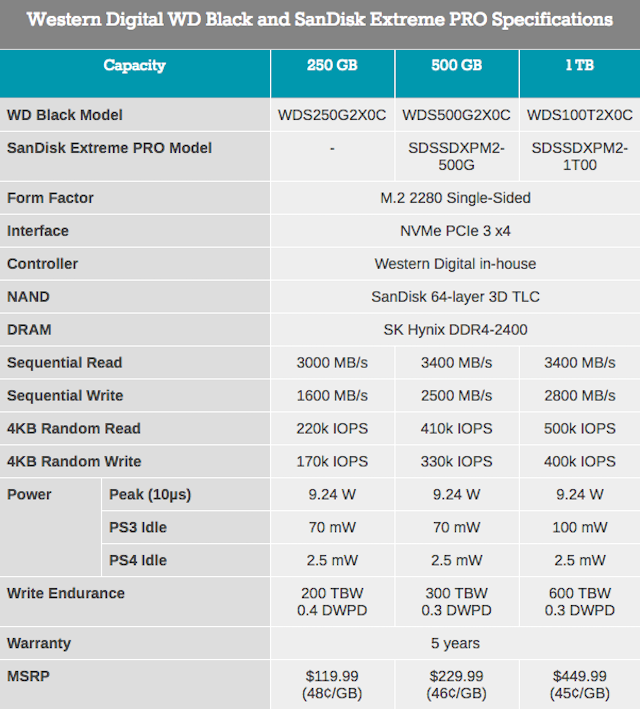
According to the declared technical characteristics of WD Black and SanDisk Extreme PRO, we have a high-performance drive with a consistent reading speed of 3+ GB / s even on a 250 GB model, as well as high random access rates on models with a capacity of 500 GB or more. Record endurance ratings are also at a fairly high level: it is 0.3-0.4 per day for five years. MSRP is positioning WD Black as a direct competitor to the Samsung 960 EVO, it bypasses most of the newest NVMe SSDs. It is worth noting that the entry-level solid-state drives using the NVMe protocol occupy the fastest-growing segment of the market, and manufacturers of various brands are focused on it.
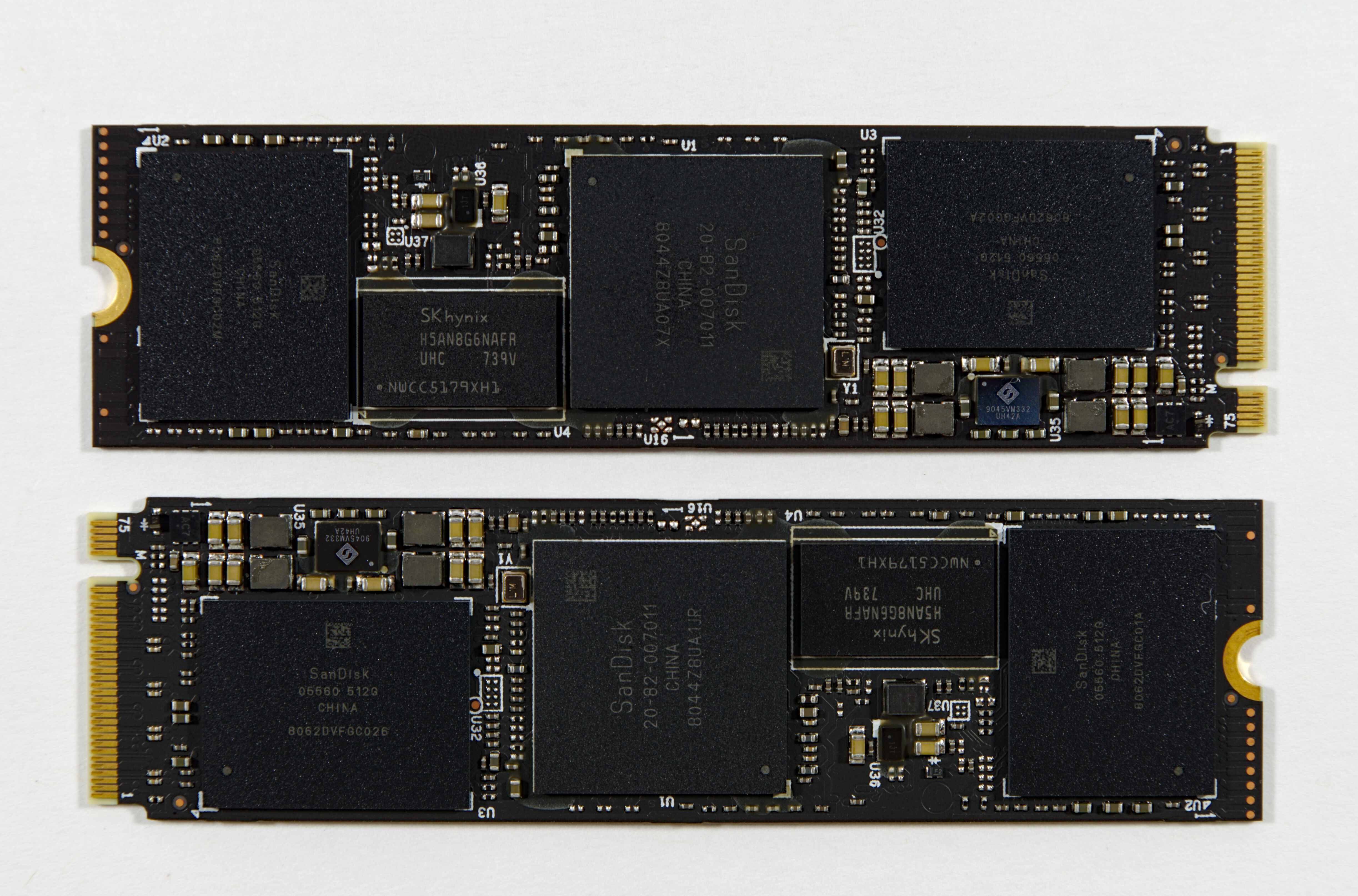
The new WD Black is able (at least for a moment) to reach the power limits of the form factor M.2. What is important, instead of the radiator, Western Digital uses an unusual “design”: the controller is located in the middle of the bar and is surrounded by NAND flash memory on both sides. This arrangement prevents the chips from overheating.
Initially, drives will be offered in capacities from 250 GB to 1 TB, although versions under the SanDisk brand exclude the availability of a 250 GB model. Deliveries should begin by the end of the month. Although Western Digital did not mention its plans to release 2 TB models, if necessary, drives of such capacity will see the light, especially since the company has already announced the release of SN720 with a capacity of 2 TB.
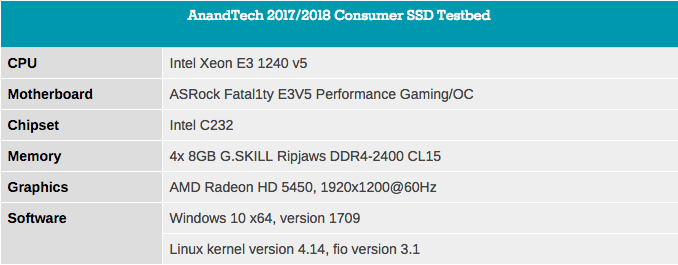
Western Digital NVMe Architecture - NAND & Controller
Noteworthy aspects of the WD Black 3D NAND SSD are a new, self-made SSD controller and the latest 64-layer BiCS 3D NAND in one of the NVMe SSDs. 64-layer 3D-NAND (BiCS 3) is the third generation of 3D-NAND SanDisk / Toshiba. The first two generations had 24 and 48 layers, respectively, but were released on a “modest” scale. None of the previous generations was produced in an amount sufficient to displace a 15 nm planar NAND Toshiba / SanDisk. What can be said about the production of the 64-layer version, which is growing at an accelerated pace. Western Digital has already used 64-layer NAND in SanDisk Ultra 3D SSDs and WD Blue 3D SATA late last year.
BiCS (Bit Cost Scalable) technology allows to increase packing density by 1.4 times and increase the number of layers to 64, built on cells with a charge trap - a complex design that eliminates almost all the flaws of a planar NAND. Bit density can increase from one 3D generation to the next, due to the projected scaling both vertically and horizontally. Having a larger number of electrons per NAND cell in a charge trap design as compared to the design of floating gates in a planar NAND (with very small geometries) ensures a high level of reliability and durability of the 3D NAND cell compared to the best planar NAND samples. The disadvantage is the high cost of upgrading equipment 2D NAND for the production of 3D-NAND-plates.
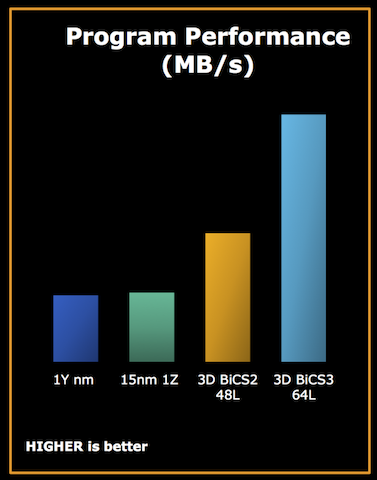
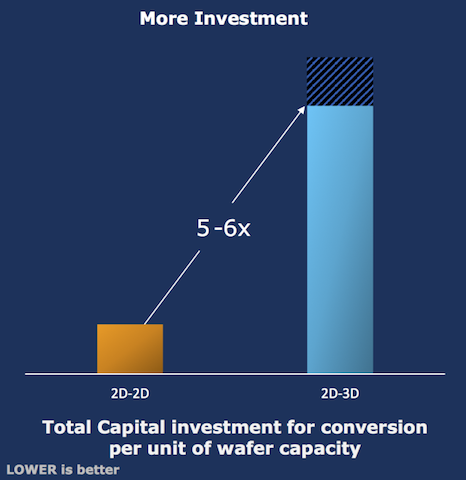
Although the production of BiCS 4 (96-ply) is rapidly increasing, this year 64-ply BiCS 3 NAND will take the place of the favorite from Western Digital, it is the subject of this review.
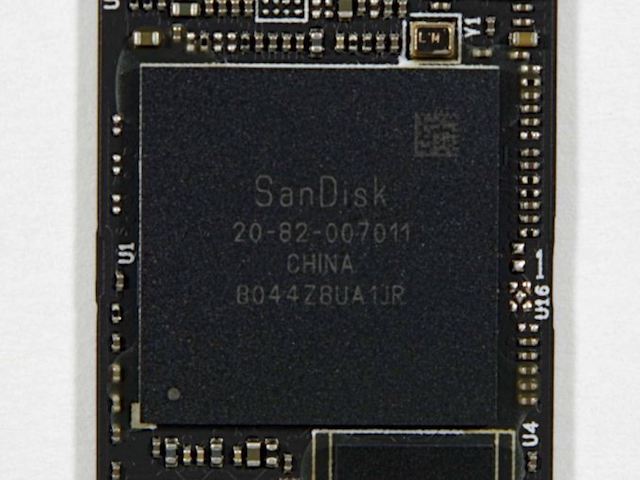
As for the controllers, Western Digital decided to switch from a Marvell product to its own design. The main reason is the creation of an architecture that will be optimized for BiCS flash: the controller will not need to support NAND from other suppliers, it will be designed taking into account the development of the BiCS line. NVD SSDs have performance limits, so it’s important to find a way to extract every possible performance bit from an available NAND.
Not surprisingly, almost all manufacturers of flash memory on their flagship SSD-drive NVMe have their own controller. Samsung uses its own controllers on all of its SSD devices, Intel uses its own controller for SSD-900p (Optane). Even conventional and low-end SSD devices from top vendors, although they use the acquired controller chip, come with in-built firmware. Vertical integration (starting from flash memory manufacturing and IC assembly to system integration in the form of NVMe or SATA SSDs) allows vendors to optimize the performance of their products.
The new controller has a tri-core architecture (possibly using Arm Cortex-R cores), manufactured using the 28-nm process technology. It is conceived and developed scalable - the current controller can interact with the host using a PCIe 3.0 x4 link or x2-link, as in the Western Digital SN520. The controller architecture will allow future products (using variations of the controller) to enter the market faster and complement them with new features. Western Digital can now segment its NVMe product stack. The controller in Western Digital Black 3D NAND SSD is optimized for client workloads, including computer games and high-performance commercial applications. The company is confident that the new controller architecture will exist, at least, until the NVMe SSDs go beyond the limits of PCIe 3 x4 interfaces.
Unlike other manufacturers of NVMe SSD controllers, Western Digital paid less attention to firmware and more hardware accelerators to enable data exchange between the host and flash memory (processing the NVMe command and transferring data from flash to the host). Power management and heat control are performed without the help of processor cores. The firmware is used only for selective processing of commands (for example, SMART data sampling, flash translation layer (FTL) algorithm and exception handling). If you do not use the processor for all critical tasks, the controller will not experience a power shortage.
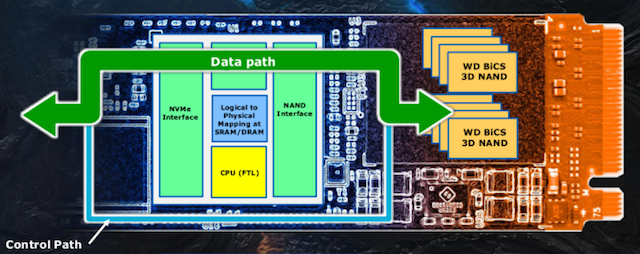
To improve performance, the WD NVMe SSD architecture implements multi-level caching (nCache). WD Black 3D NAND NVMe SSD uses nCache 3.0 (compared to nCache 2.0 it contains many updates).
Before going into details, it is interesting to look at how nCache technology has evolved over the past years. In its first generation, nCache technology was designed to cache the NAND mapping table and small records (less than 4KB) in the SLC segment on the matrix. In the second version (first introduced in SanDisk Ultra II), all write operations were intercepted into the pseudo-SLC cache, the volume of which was increased to 5GB for every 120GB of storage capacity, and direct copying of data from the SLC buffer to TLC was implemented at the chip level bypassing controller, which allowed the use of a more economical model of the controller without any loss in performance. nCache 2.0 has placed the NAND mapping table in the SLC cache area.
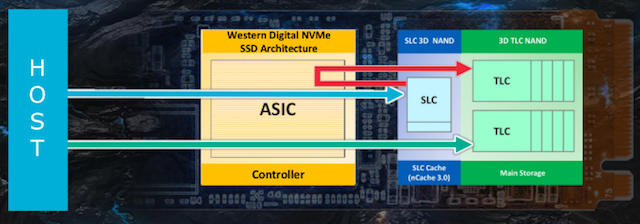
In addition, for new-generation products, 3D TLC performance is more acceptable, compared to planar TLC, when it comes to long recording sessions. The same picture with endurance. Instead of sending everything through the SLC cache, as was the case with nCache 2.0, nCache 3.0 allows writing to the TLC space after filling the SLC segment.
Another advantage of nCache 3.0 over nCache 2.0 is the absence of the On Chip Copy function, which was used in flat TLC matrices. Considering that 3D TLC provides direct access during long recording, the additional On Chip Copy function, previously responsible for transferring data from the SLC cache to TLC, is no longer needed.
Finally, Western Digital's nCache 3.0 still uses a fixed-size SLC cache. Western Digital does not disclose SLC cache sizes for WD Black, but it looks like our 1TB test samples have about 20 GB of SLC cache.
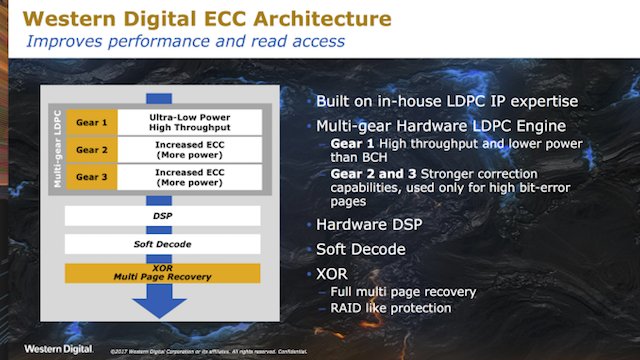
As befits a good and modern SSD controller, the new Western Digital architecture provides several levels of error correction. The first three levels are different LDPC-style error correction codes for handling the number of bit errors, which increase leads to increased energy consumption and reduced performance. The basic level of error correction is the LDPC code, controllers with LDPC support increase the probability of correctly reading data from TLC NAND several times. The LDPC error correction code significantly improves the recognition of the data stored in the cells compared to the basic BCH error correction mechanism that was used in almost all SSDs before the appearance of TLC NAND. This level of error correction is the only necessary for the normal operation of the drive during most of its service life. The second and third levels of correction are designed to handle the increased error rate, which occurs already in the last periods of use of SSD. These codes are fully processed by the dedicated hardware on the controller, without using the resources of the processor cores.
To recover serious data loss, which is not subject to the three levels of LDPC, the controller provides for the similarity of traditional RAID5 data recovery on XOR-segments. Although this is not enough to withstand the "failure" of the entire matrix NAND. ECC error correction memory ensures data integrity in the controller's SRAM and external DRAM.
AnandTech Drive Test - The Destroyer
The Destroyer is an extremely time-consuming test that shows how an SSD behaves with intensive workloads with a large amount of I / O. The Destroyer has been an integral part of the Anandtech test suite for almost two years, it is designed to “destroy all greenhouse conditions” by loading the system in SSD searches with the best performance characteristics. As in the real world, the drives were given time to take a breather in order to clear the collection of garbage from them and clean the cache, only idle periods were reduced to 25 ms, and therefore we did not get the results a week later. The AnandTech Storage Bench (ATSB) tests do not include the launch of real-world applications that generate workloads, so the performance will hardly change with changes in CPU and RAM performance,
Evaluation of the performance of this test depends on the average throughput of the drive, the average delay of I / O operations and the total energy consumed by the drive during the test.
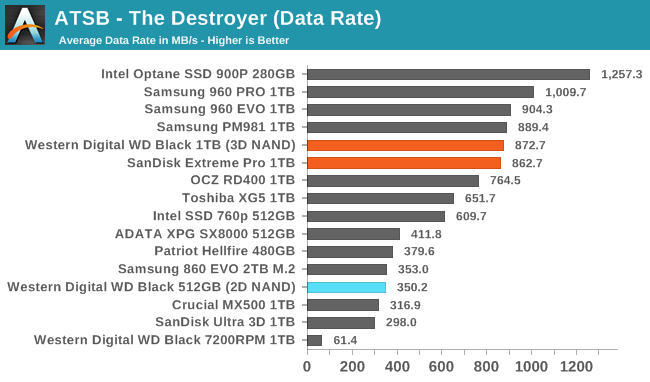
The average data transfer rate of the new WD Black during The Destroyer test is almost as high as that of the TLC 960 EVO from Samsung and its new PM981 OEM drive. And if the original WD Black NVMe SSD was clearly one of the slowest NVMe drives and showed results at the SATA SSD level during our test, the new WD Black looks quite competitive among the fastest models.
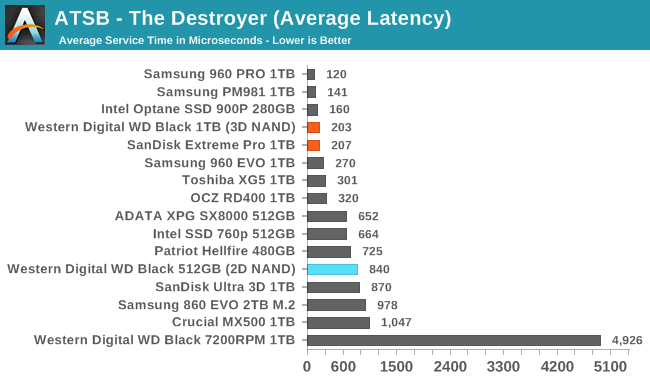

The average delay on WD Black is approximately at the level of TLC-drives from Samsung, and according to the results of p99 delay, we have the best result that we saw on any SSD-drive based on flash memory with such a capacity.
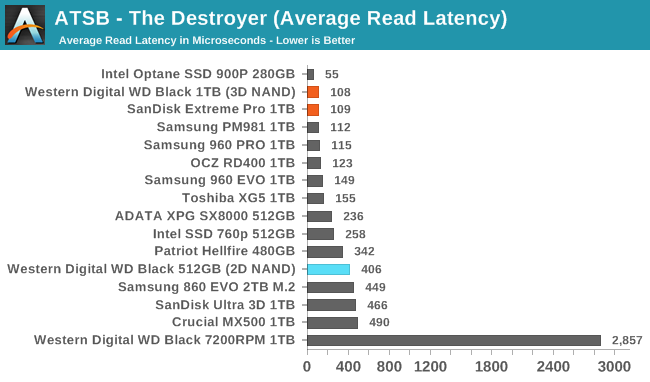
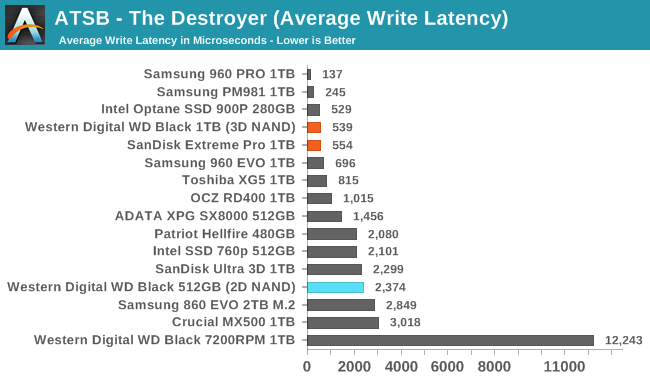
The average read latency from WD Black to The Destroyer is as good as any other flash-based SSD we tested. The average recording delay is record low, but Samsung’s top drives are clearly faster.
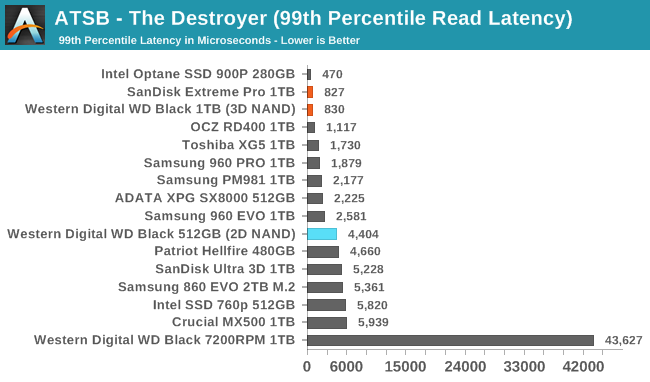
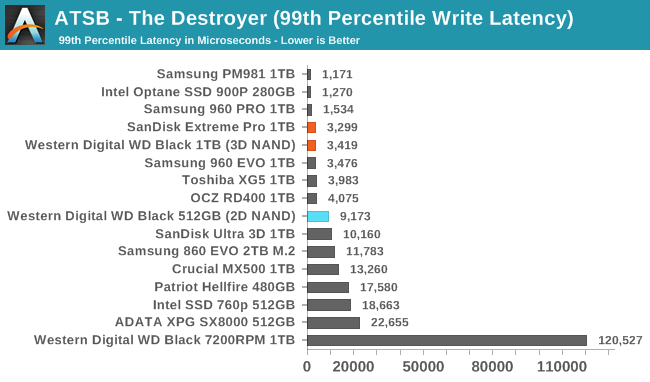
As for the p99 read delay, the WD Black shows better results, second only to the smaller Intel Optane SSD 900P. But in terms of the record delay p99, WD products come in second place.

The power consumption of the new WD Black has dropped dramatically compared to the previous SSD, bearing the same name. The new model consumes less than half the energy compared to the past, which brings it to the leading first place, a little behind - Toshiba XG5.
Test drives AnandTech - Heavy
Our “Heavy” test, in contrast to the “Destroyer”, is designed to demonstrate SSD operation under heavy loads in a shorter period of time. The total amount of recorded data during the Heavy test will not fill the disk, which will not bring the SSD to a steady state; The test results are significantly affected by the performance of the drive during peak periods. Detailed data on the Heavy test can be found in the corresponding article on AnandTech. This test is run twice, once on a completely cleaned drive, and once after filling the drive with a long write.
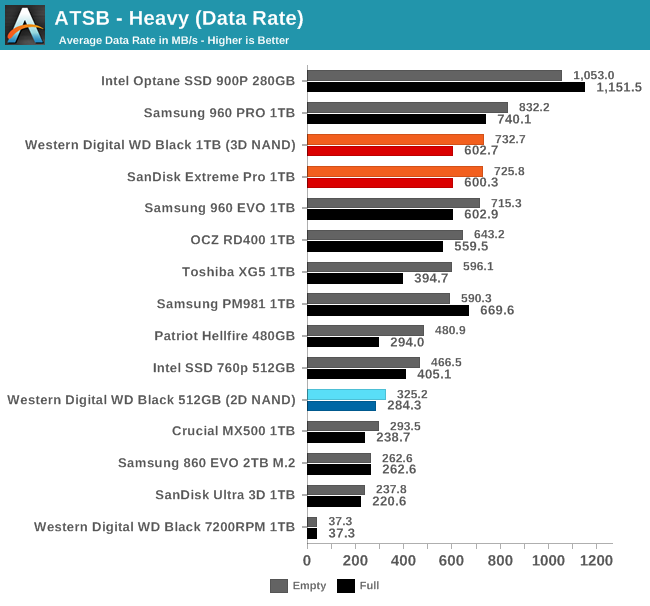
The average data transfer rates of the new WD Black SSD in the Heavy test are very close to the Samsung 960 EVO. Premium products, such as the Samsung 960 PRO and Intel Optane SSD 900P, work faster, but the WD Black and SanDisk Extreme PRO NVMe solid-state drives can be easily attributed to the high-end segment.
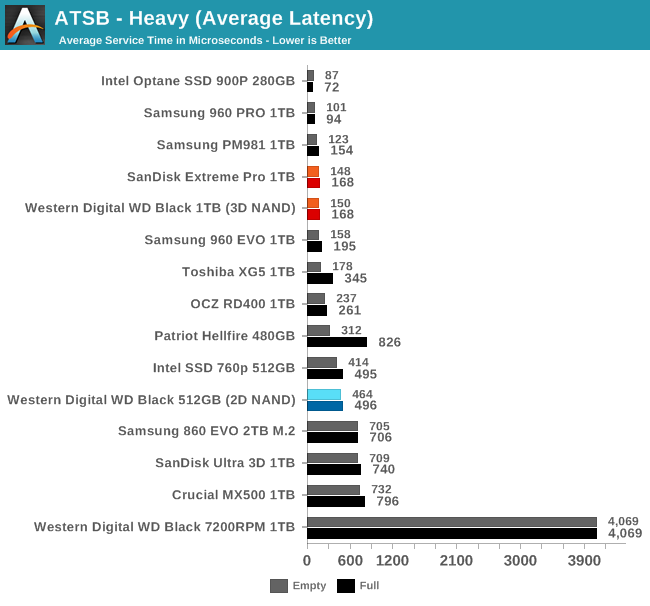

Estimating the average and p99 delays of WD Black during Heavy gives some of the best results on any solid-state drive based on flash memory. In addition, the p99 WD Black recording delay rate shows a much lower performance loss on a full drive than the Toshiba XG5 or Samsung 960 EVO.
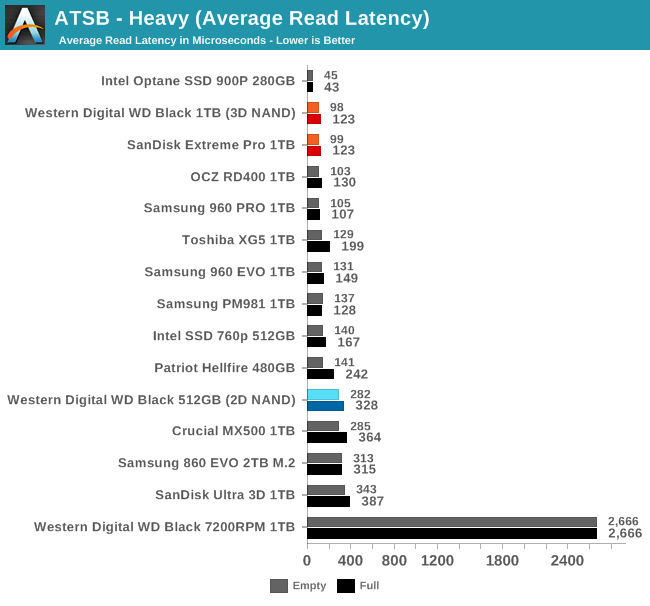
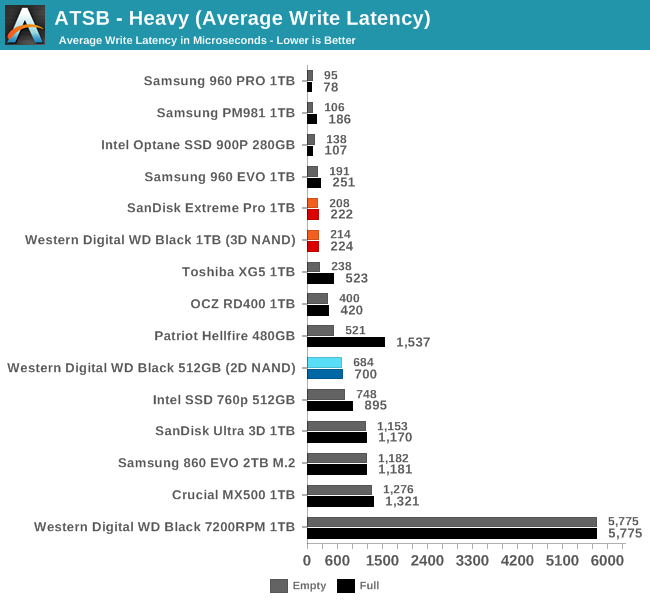
WD Black is one of the best drives on average read latency, and the average write latency is slightly higher than the Samsung 960 EVO. The loss of performance that comes from testing on a full disk is about the same as that of most MLC-based disks.
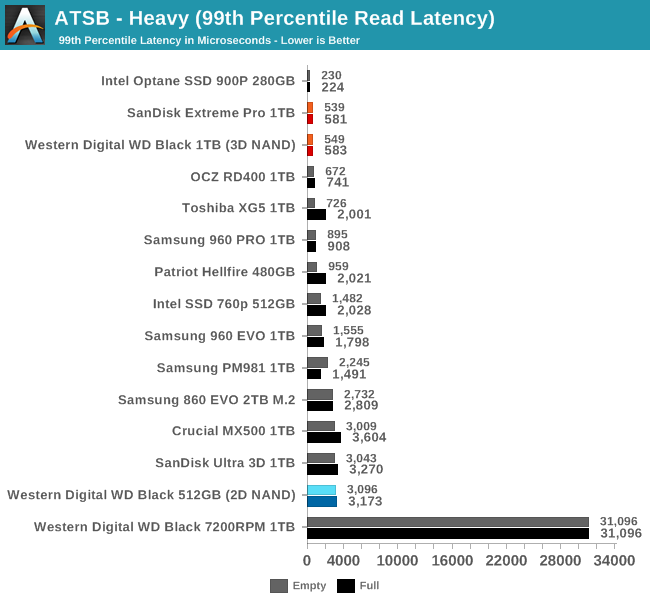
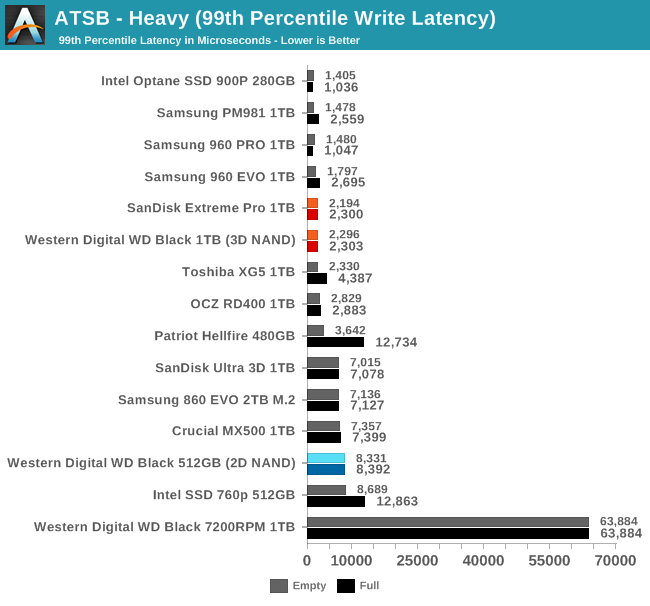
The new Western Digital controller architecture provides excellent QoS for read operations, with the 99th percentile latency lower than any competing flash drive. The 99th percentile of the record delay is also at the top of the ranking, but it is no longer so obvious among speed champions.
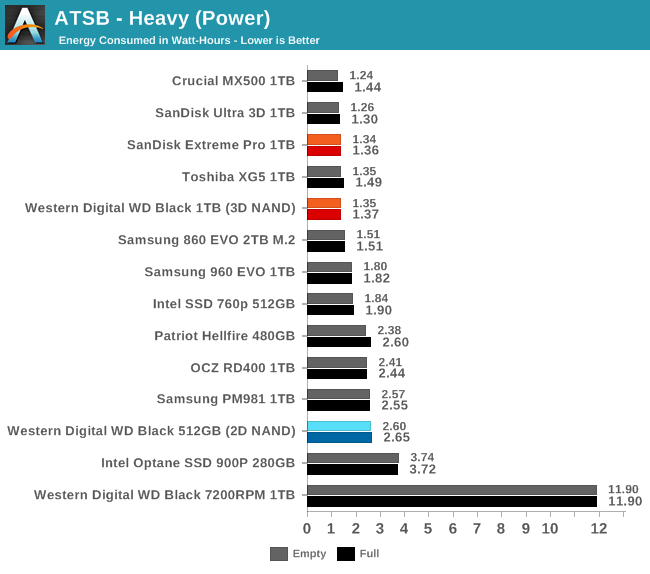
WD Black and SanDisk Extreme PRO are becoming on a par with Toshiba XG5 and several other NVMe solid-state drives, which have very low power consumption, comparable to good SSD SSD. The total energy used during the Heavy test is slightly higher than that of the Crucial MX500 and Western Digital SATA drives with the same 64L 3D TLC NAND.
Test drives AnandTech - Light
Our test for Light drives has relatively more consecutive sessions and a shorter queue depth than The Destroyer or Heavy, this is the shortest test. It is based mainly on applications that are not very dependent on the performance of the drive, so its results most likely reflect the launch time of applications and file downloads. This test can be considered as the sum of all small delays in everyday use, but when reducing downtime to 25 ms, it takes less than half an hour to complete it. Detailed information about the Light test can be found in the corresponding article on AnandTech. As in the case of the ATSB Heavy test, this test is run twice: on a drive that has been completely cleared, and after filling the drive with a sequential write.

During a test run on an empty drive, the average data transfer rate of the WD Black drive is slightly lower than that of the Samsung 960 EVO, and vice versa, when the drive is full. Samsung PM981 - the only drive that has the advantage, although not very significant, in both cases. Even at the worst performance, the performance of the new WD Black is a cut above the performance of last year’s WD Black.
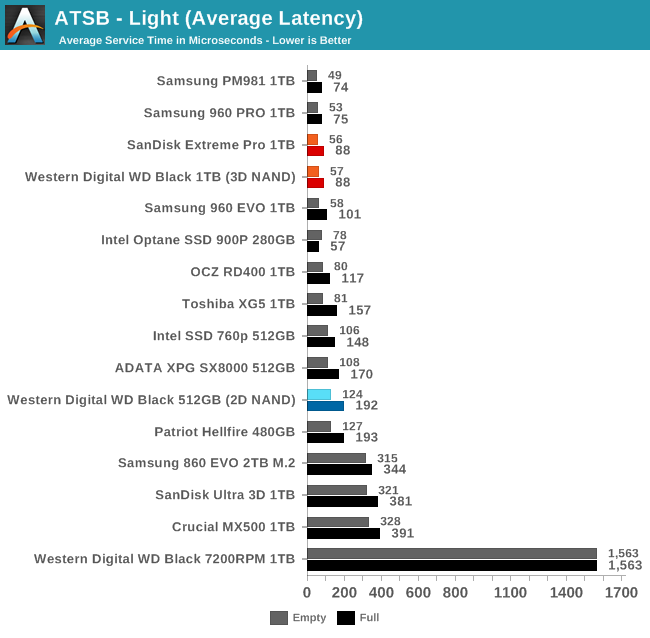
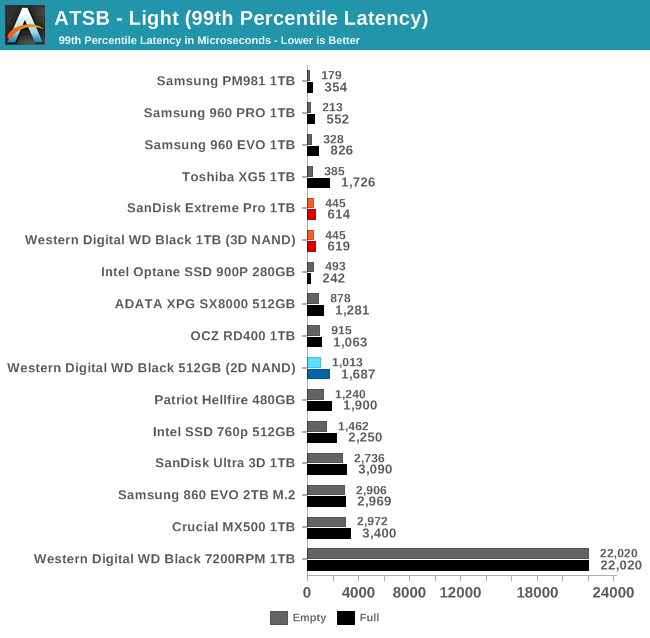
The average WD Black latency during the Light test is as low as most modern SSDs. The result of the 99th percentile of delays is slightly worse than that of the fastest Samsung drives, except that the performance of the full drive is better than that of the 960 EVO.
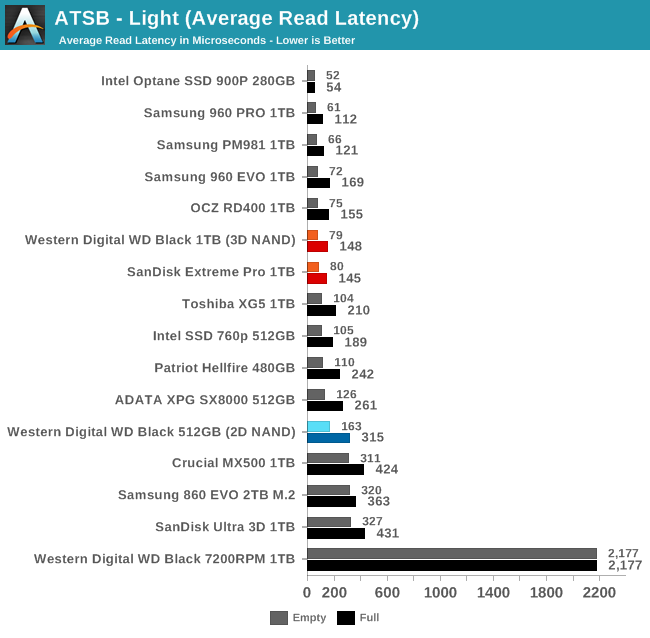
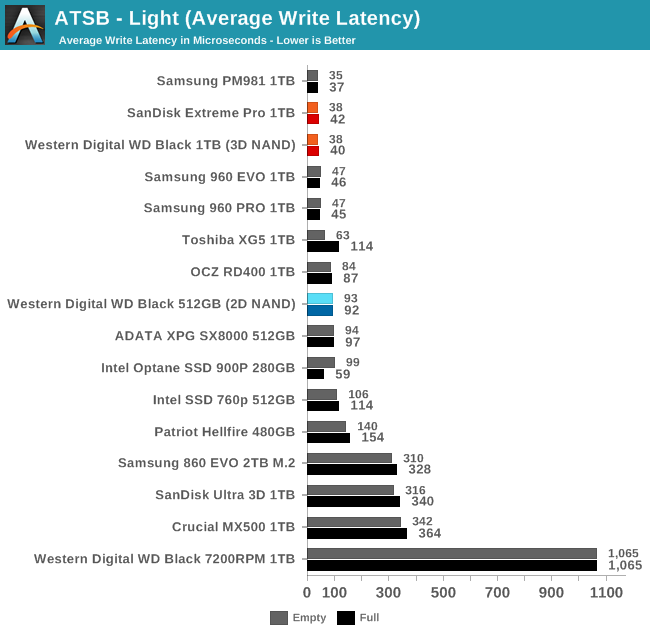
There are quite a few SSDs with an average read latency close to WD Black, and even low-level NVMe SSDs have an average read delay of a fraction of a millisecond (according to our Light test). In terms of the average recording delay, WD Black deservedly shares the first place with a Samsung drive.
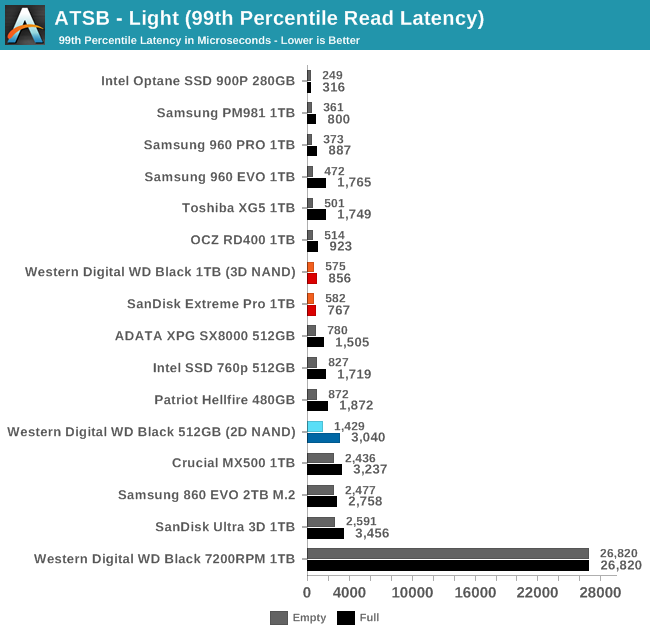
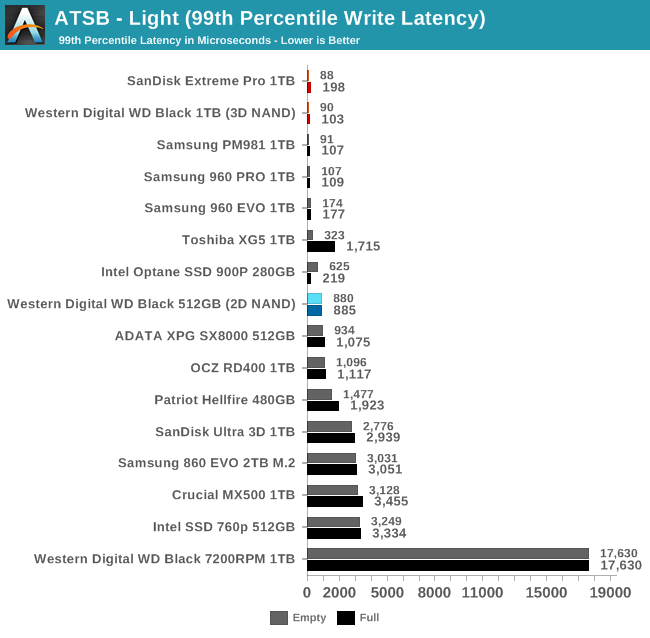
WD Black shows an incredibly low write latency (99th percentile) on the Light test, because its SLC cache is never filled. The read delay (99th percentile) does not show such a record value, but still the result on the full drive is very good.
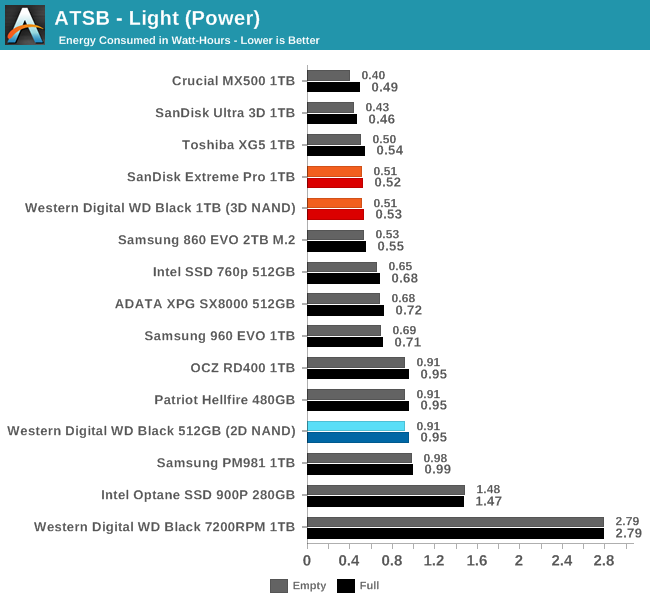
As in the case of the Heavy test, the only tested NVMe SSD that can match the energy efficiency of the WD Black is the Toshiba XG5. These drives are much faster than SATA, while consuming less power.
Test "Random reading"
Our first performance test for random reading uses very short bursts of operations, performed one at a time, without a queue. Drives get enough downtime between such “bursts” to provide a total cycle time of 20%, so thermal regulation is not possible. Each package has a size of 32 MB, read from random 4 kilobyte blocks, from a 16 GB disk range. The total amount of data is 1 GB.
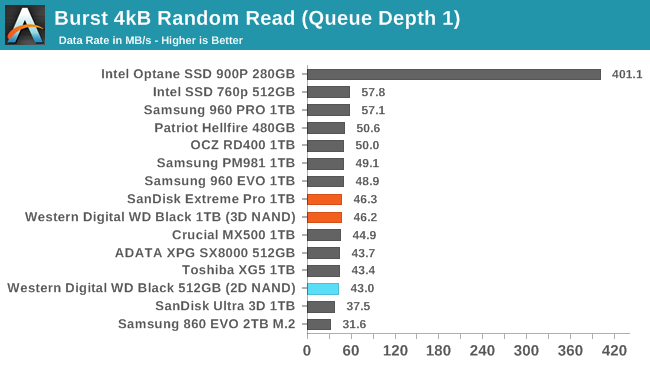
The reading performance of random WD Black blocks does not beat records, but it is still better than last year’s WD Black SSD, and only slightly behind Samsung 960 EVO.
Our reading performance test is similar to the test from the 2015 set: queue depths from 1 to 32 are checked, and the average performance and energy efficiency in QD1, QD2 and QD4 determine the main test scores. Each queue depth is checked one minute or 32 GB of transmitted data, which is faster. After checking the queue depth, the drive shuts down for up to one minute to cool down so that the accumulation of heat does not affect the greater queue depth. Separate read operations still work with 4kB blocks and cover a 64-gigabyte drive spacing.
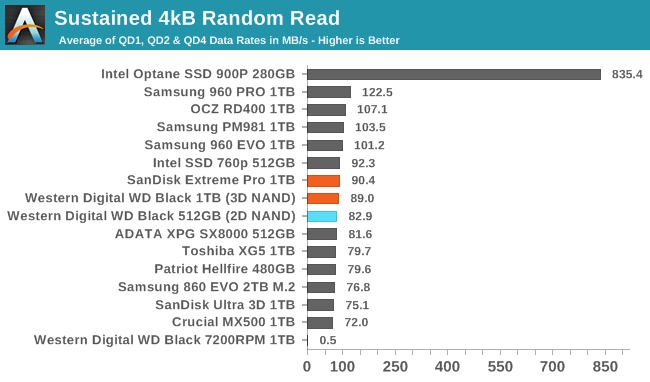
The random reading performance of the WD Black is slightly improved compared to last year’s model. But this is still not enough to catch up with Samsung. In addition, the recently released Intel 760p is slightly ahead of WD Black.
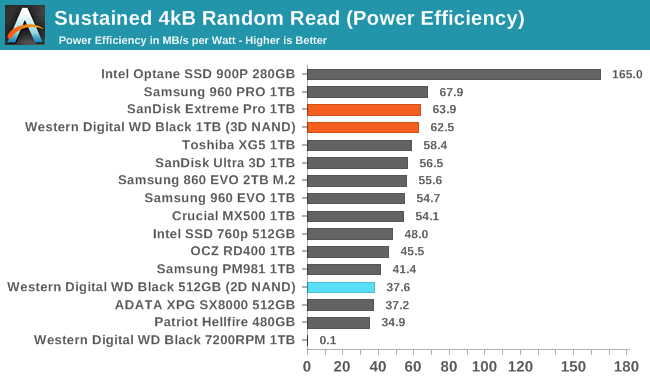
WD Black's energy efficiency during random read operations is better than that of any other TLC drive. Its consumption is not much higher than that of the SATA disk, as can be seen from the “tests” conducted.
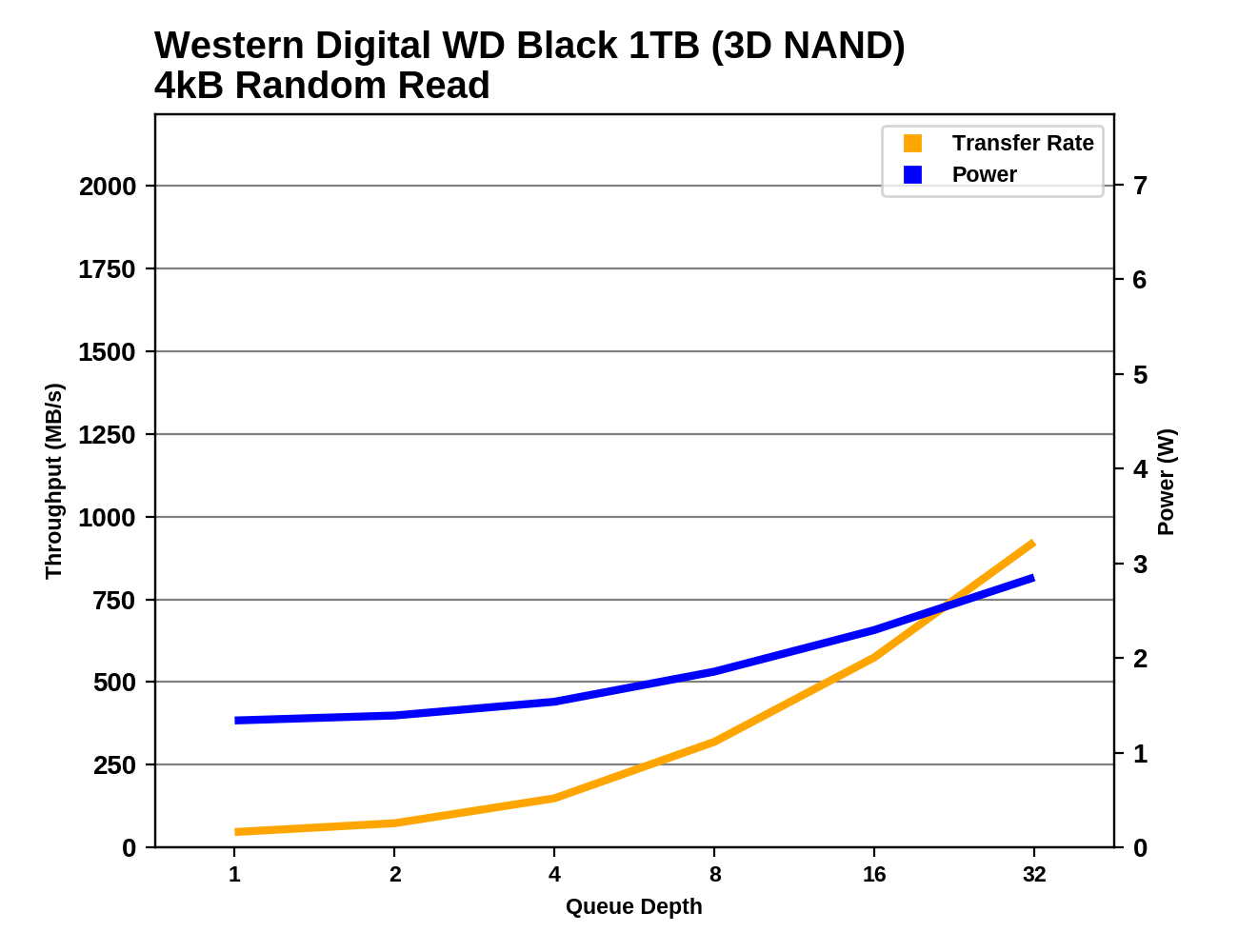
Western the Digital the WD Black 1TB (3D of NAND)
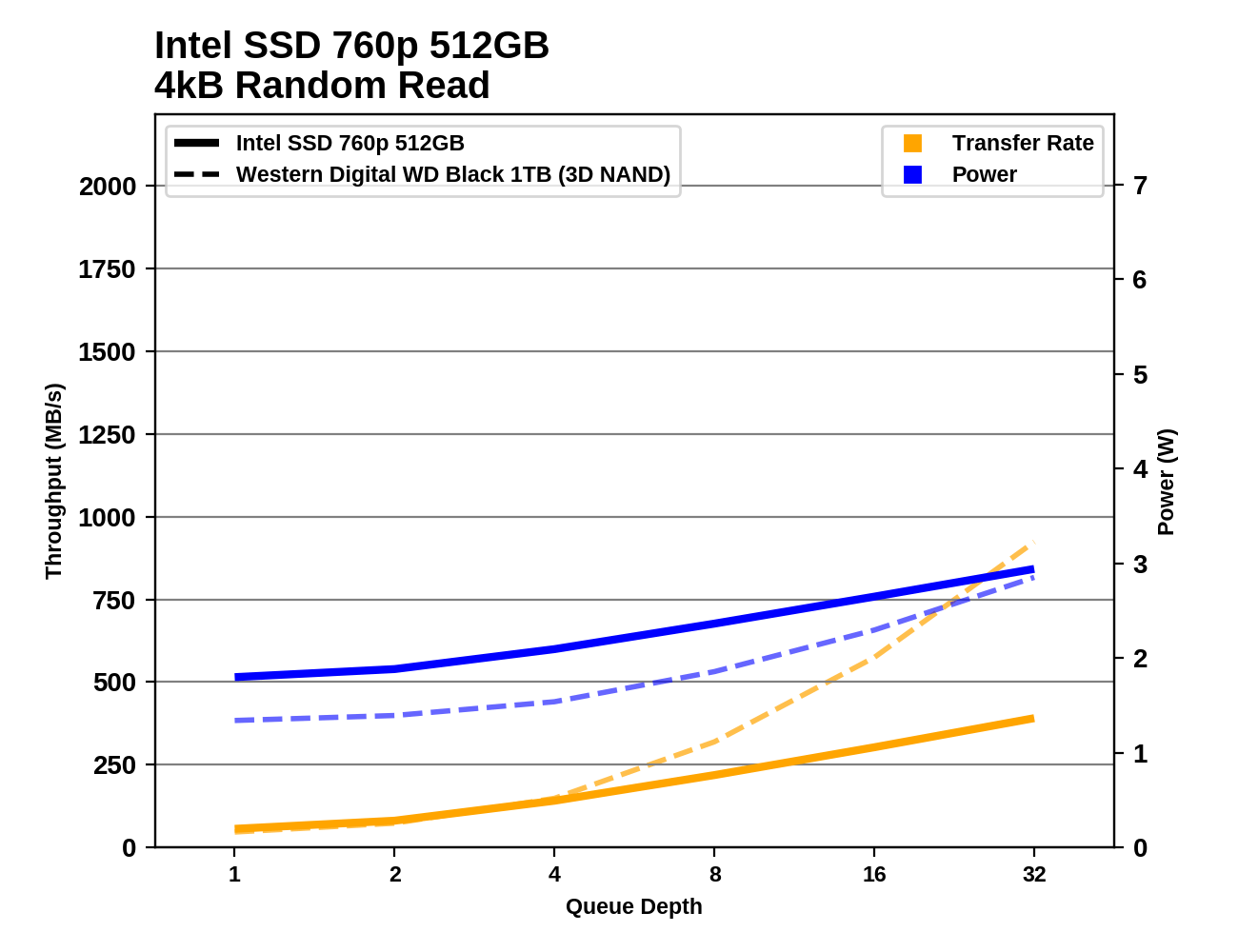
the Intel the SSD 760p 512GB
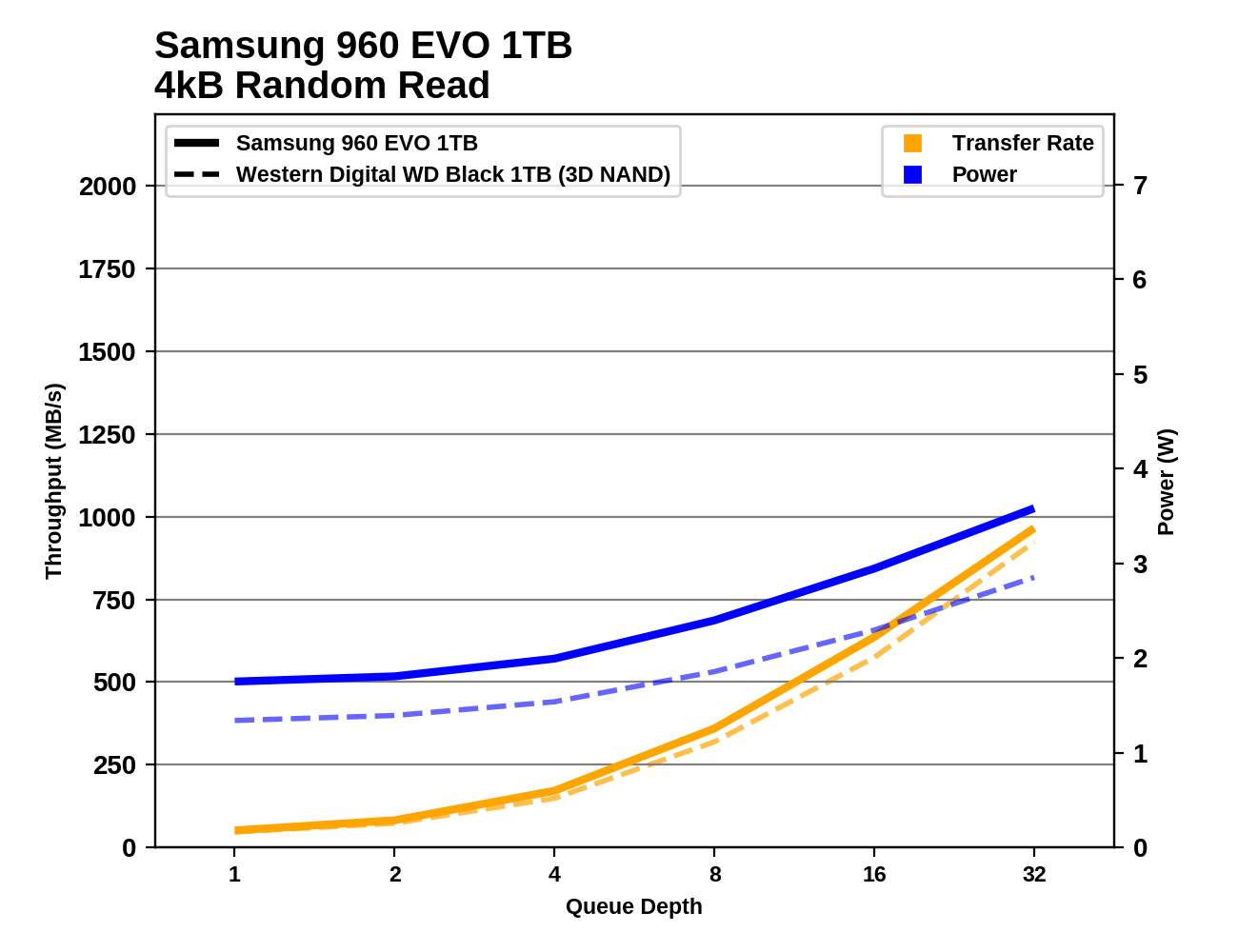
the Samsung 960 the EVO 1TB
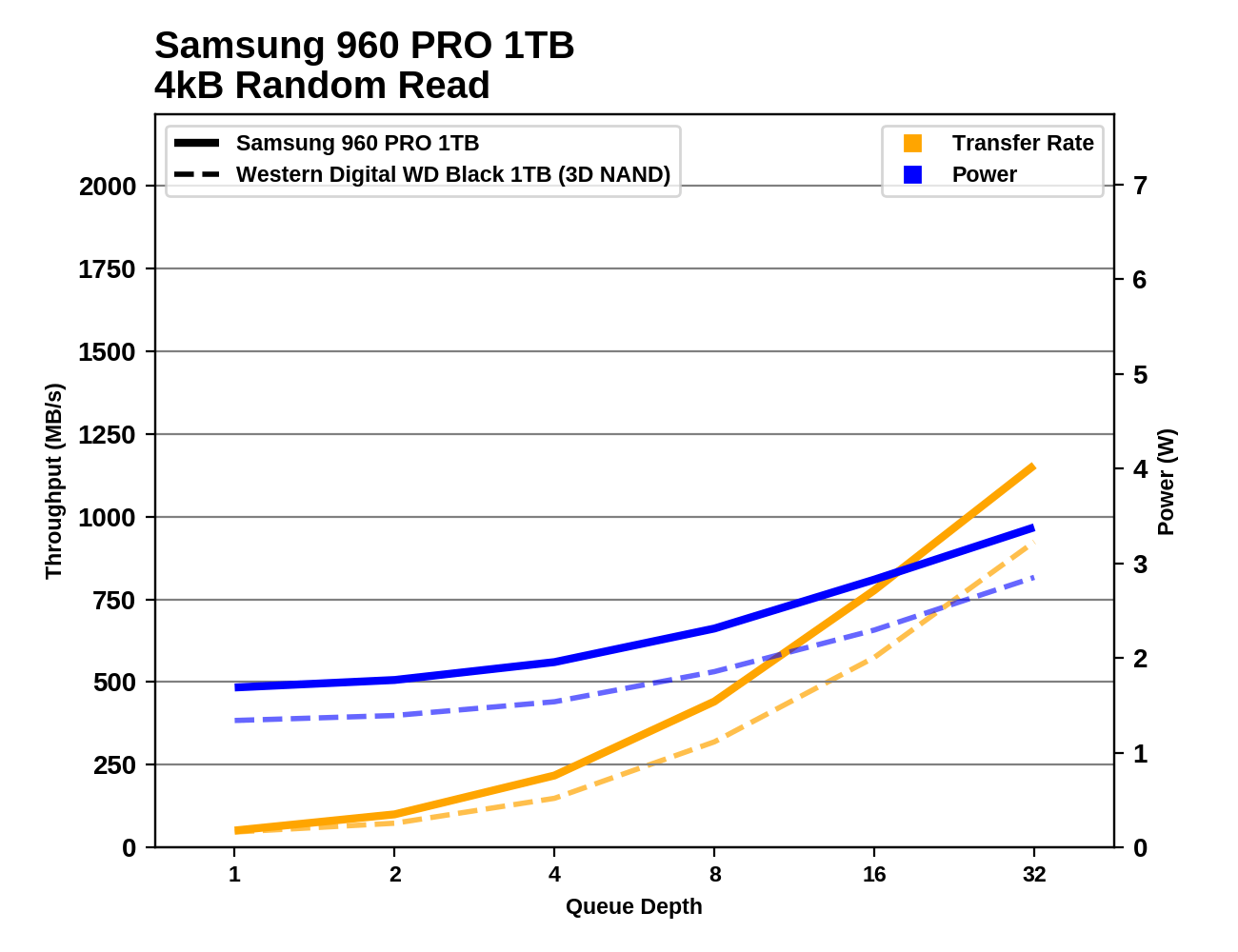
the Samsung 960 the PRO 1TB
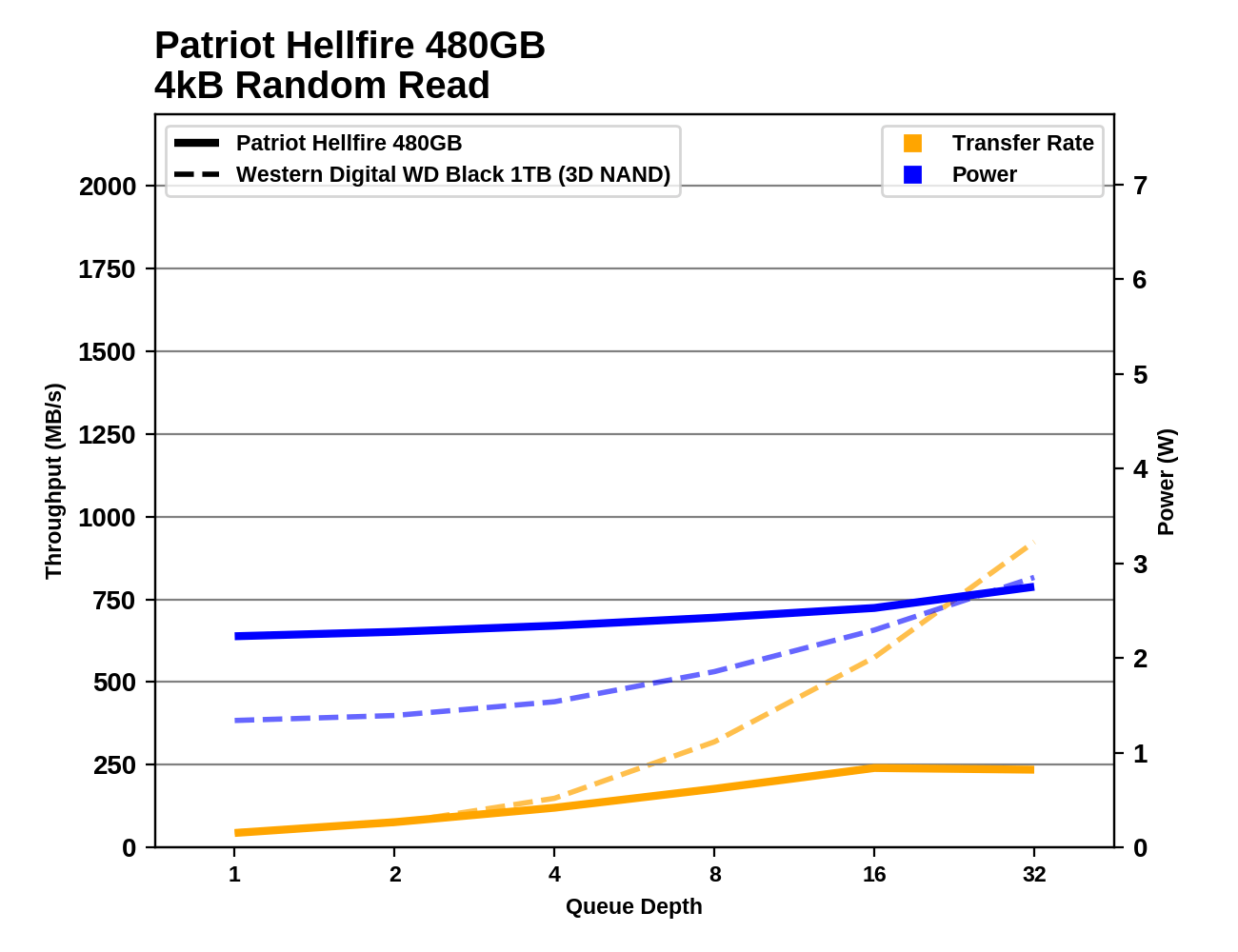
Patriot the Hellfire 480GB
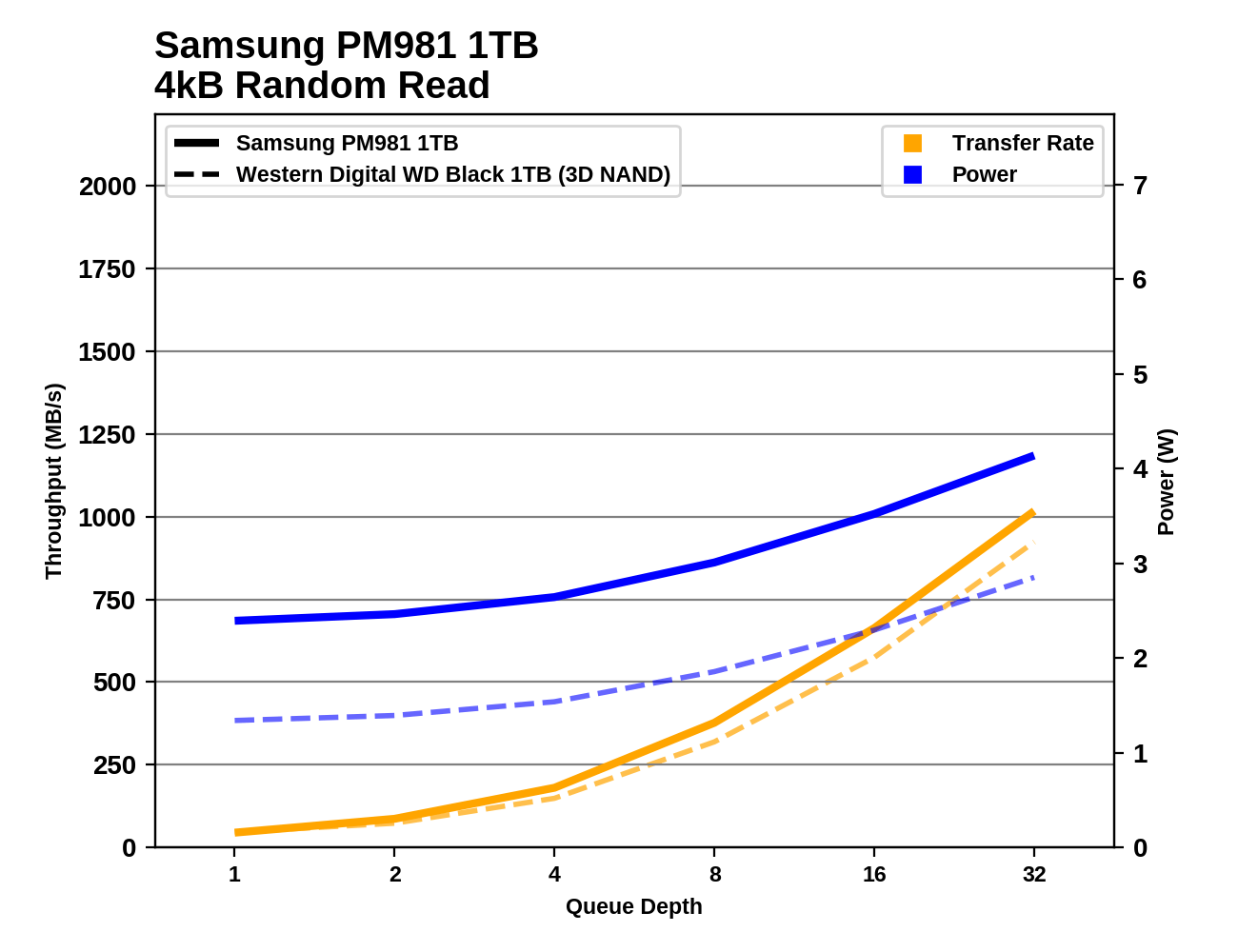
the Samsung PM981 1TB
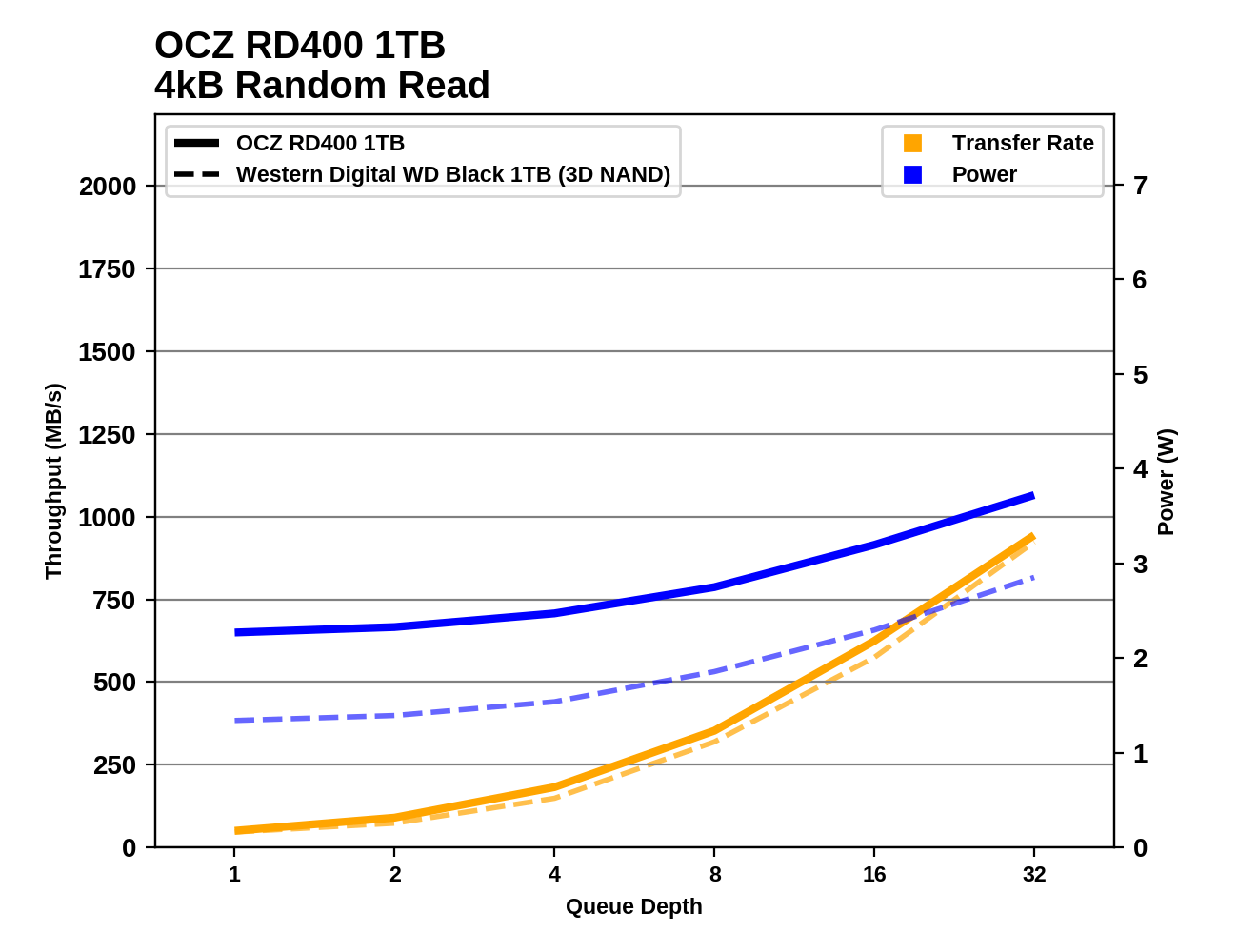
the OCZ RD 400 1TB

the ADATA XPG SX8000 512 GB

Western the Digital the WD Black 512GB (2D of NAND)
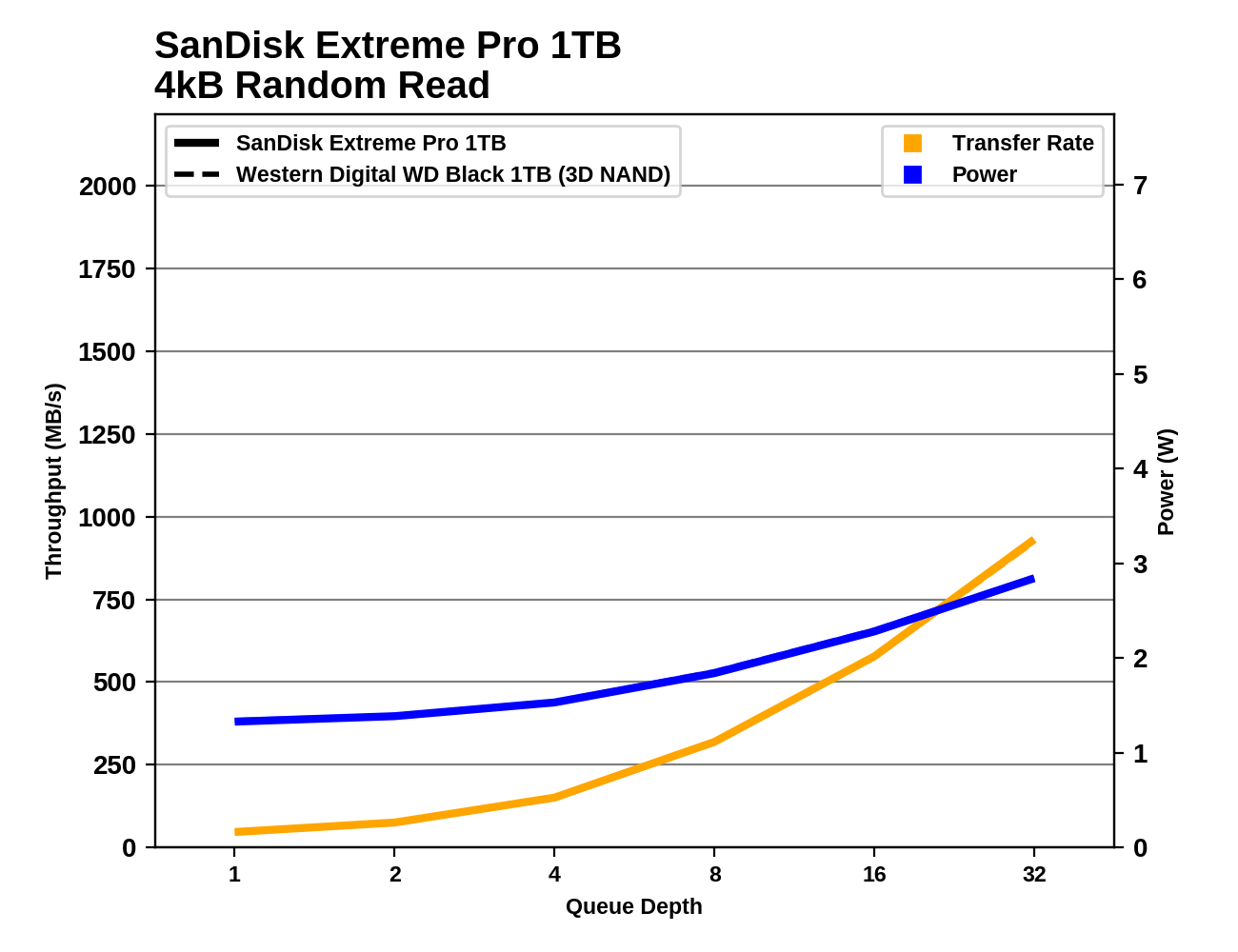
SanDisc Extreme the PRO 1TB
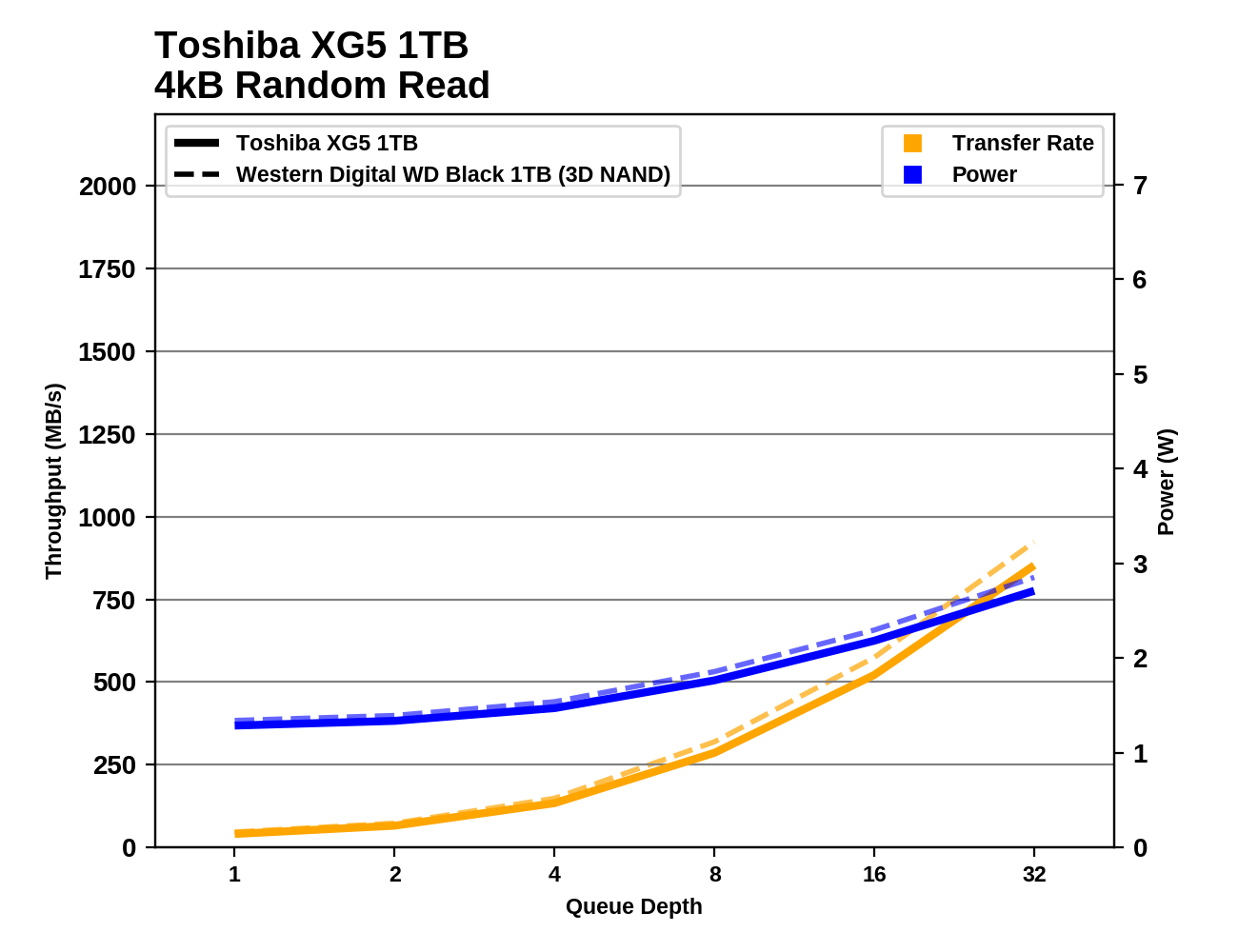
the Toshiba XG5 1TB
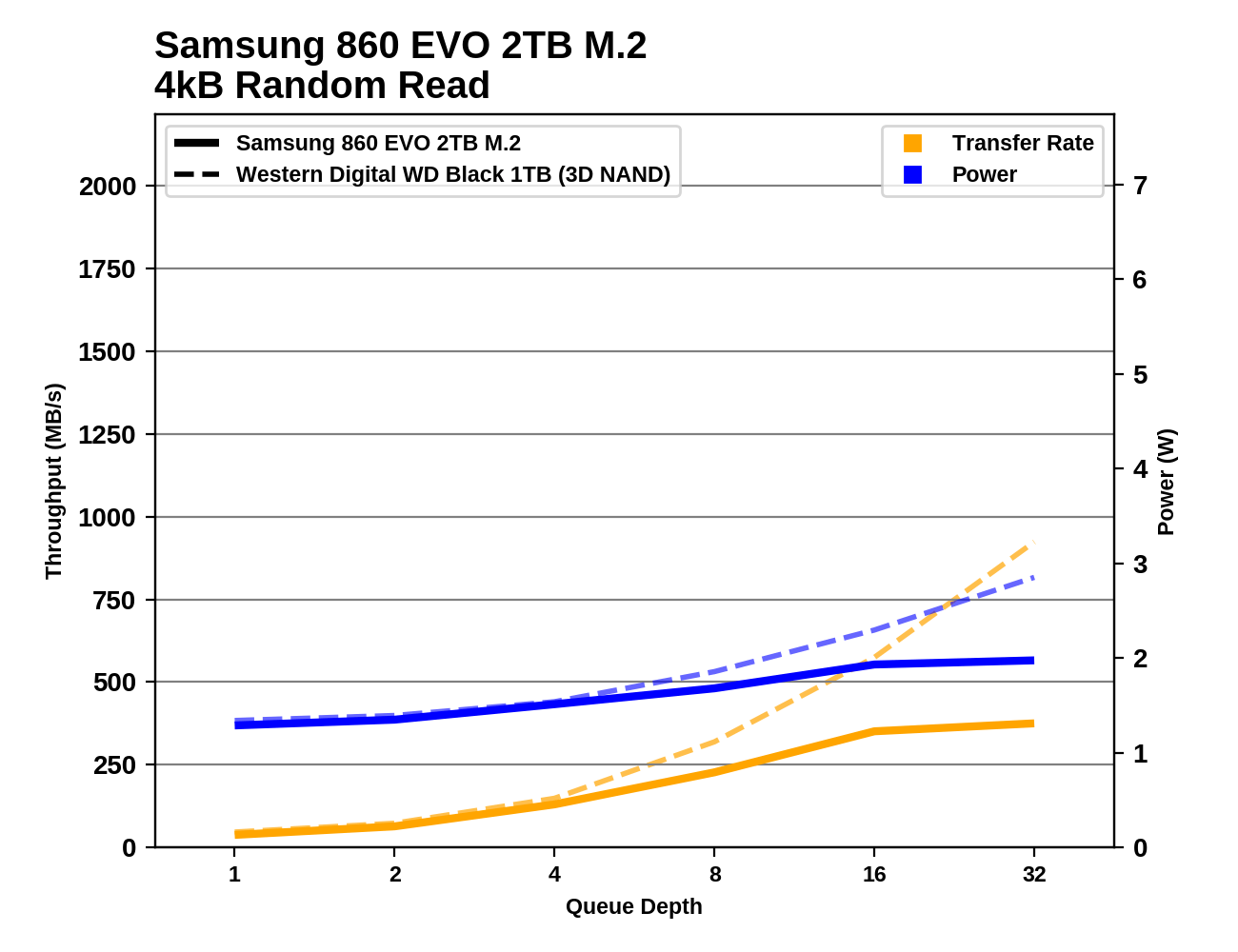
Samsung 860 EVO 2TB M.2
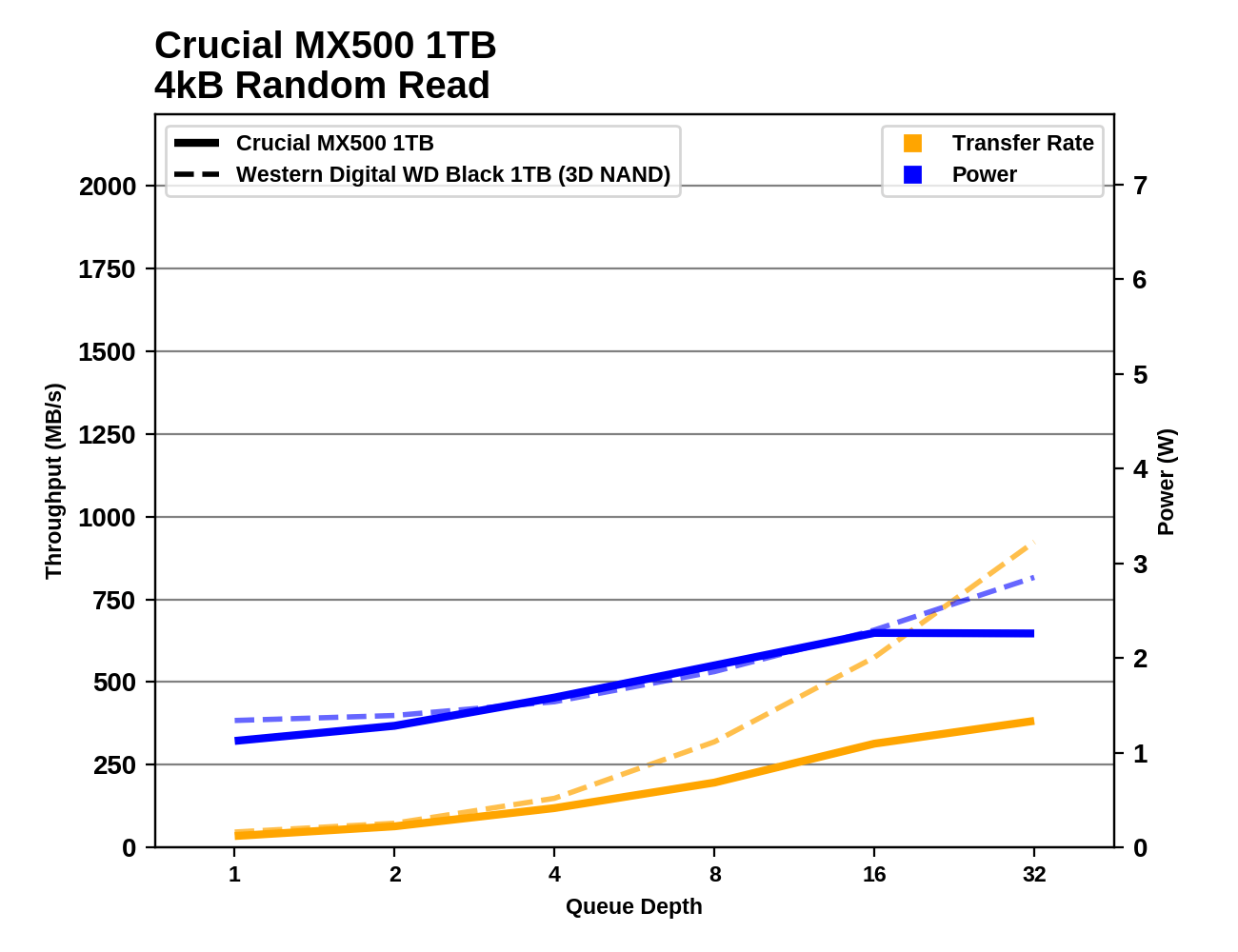
Crucial MX500 1TB
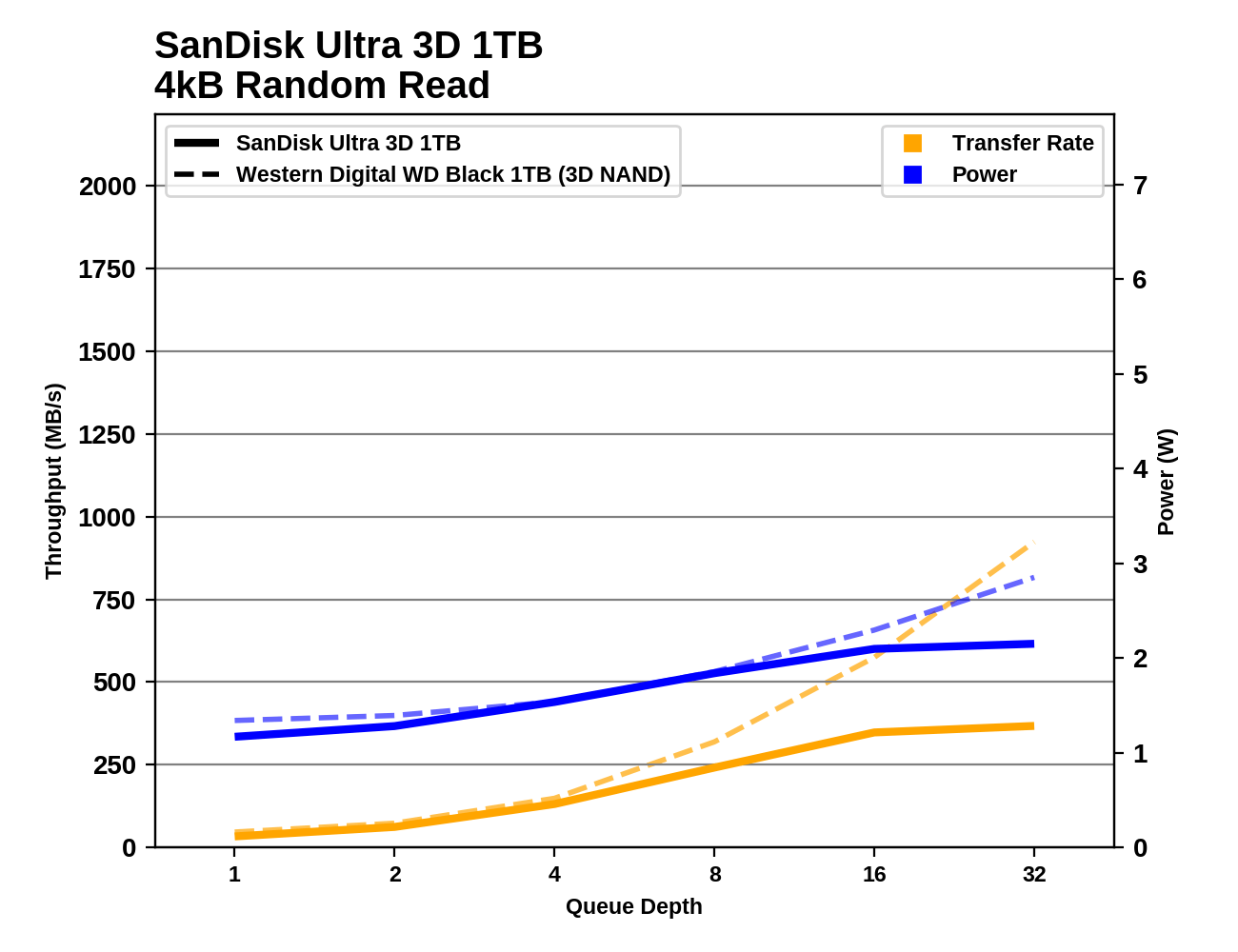
SanDisc Ultra 3D 1TB

Intel Optane 900P 280GB
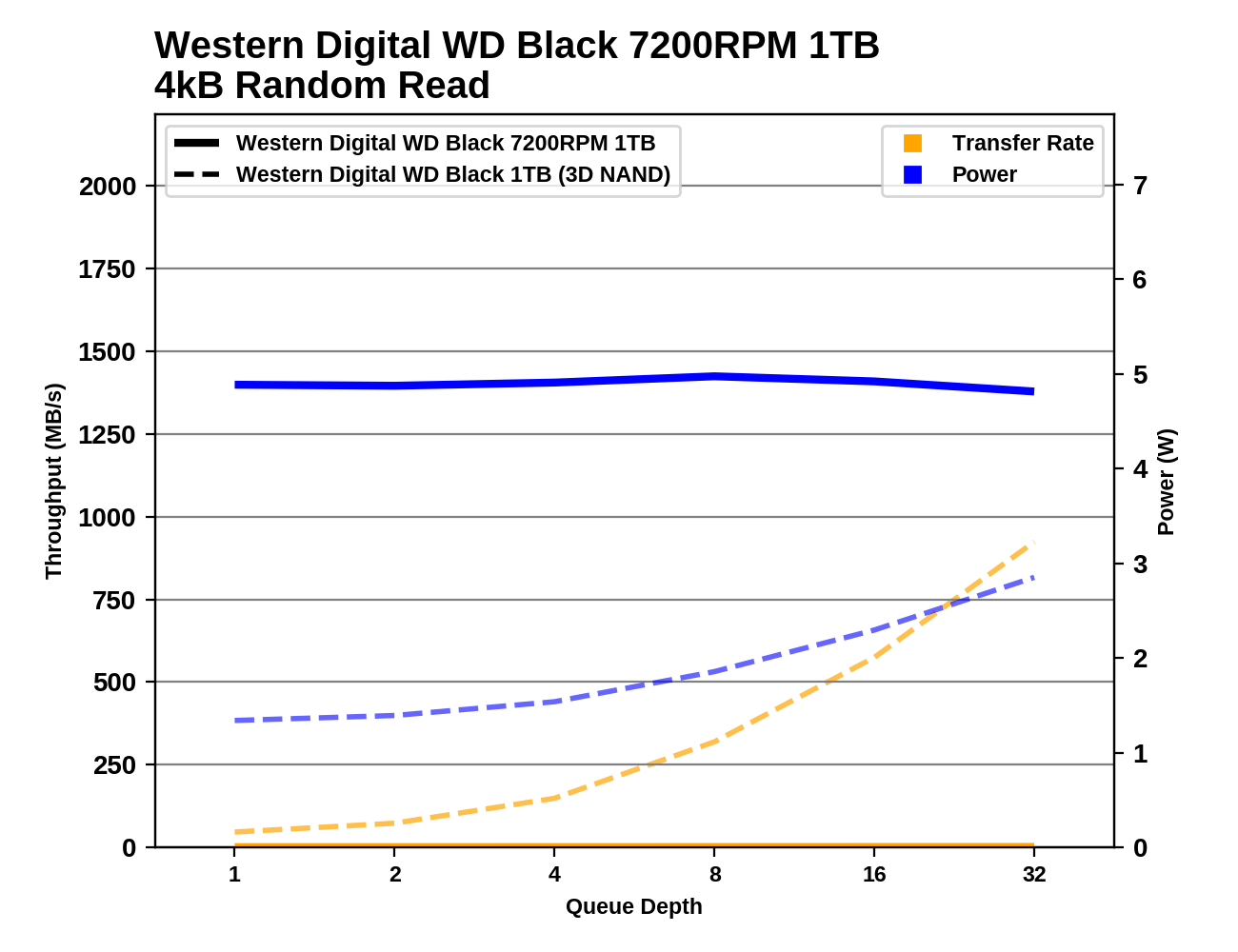
Western Digital WD Black 7200RPM 1TB
At deeper queue levels, Samsung drives slightly outperform WD Black, but most other drives noticeably lag behind as the queue depth increases.
Performance when randomly recording
The performance test of random data writing is planned similarly to the reading test, but each packet is now only 4 MB, and the total recording length is 128 MB. Random write operations of 4 KB are distributed over the 16-gigabyte range of the drive, and are issued one by one, without a queue.

Our WD Black sample suddenly showed a much better result with random recordings than the SanDisk Extreme PRO, although this is essentially the same device. Although the indicators of both disks are at the top of the chart.
As with the read test, our test of a constant 4 KB random write lasts up to one minute or 32 GB per queue depth, spanning 64 GB of disk range. The drive is also provided with up to 1 minute of idle time between queue depths, which makes it possible to constantly overwrite caches and avoid overheating.
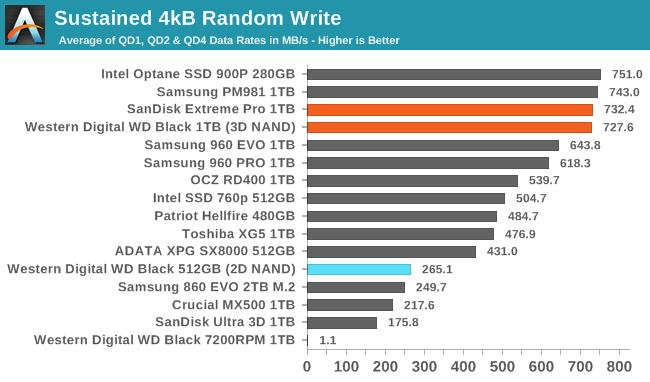
The new WD Black shows just champion performance during the random recording test, well ahead of Samsung’s current retail offerings, and is very close to the results of the OEM PM981 drive, which is the basis for Samsung’s future generation of drives. Last year's WD Black was not much faster than SATA drives.
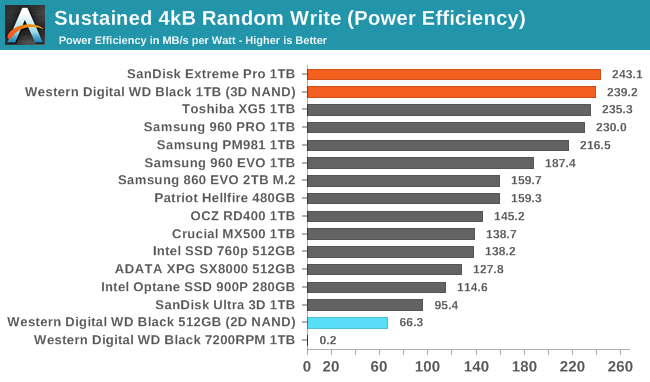
Full reworking of NAND and the controller lifted the WD Black from the bottom of the performance chart (where the last year’s model is) to the very top, eventually surpassing even the Toshiba XG5 and Samsung 960 PRO.
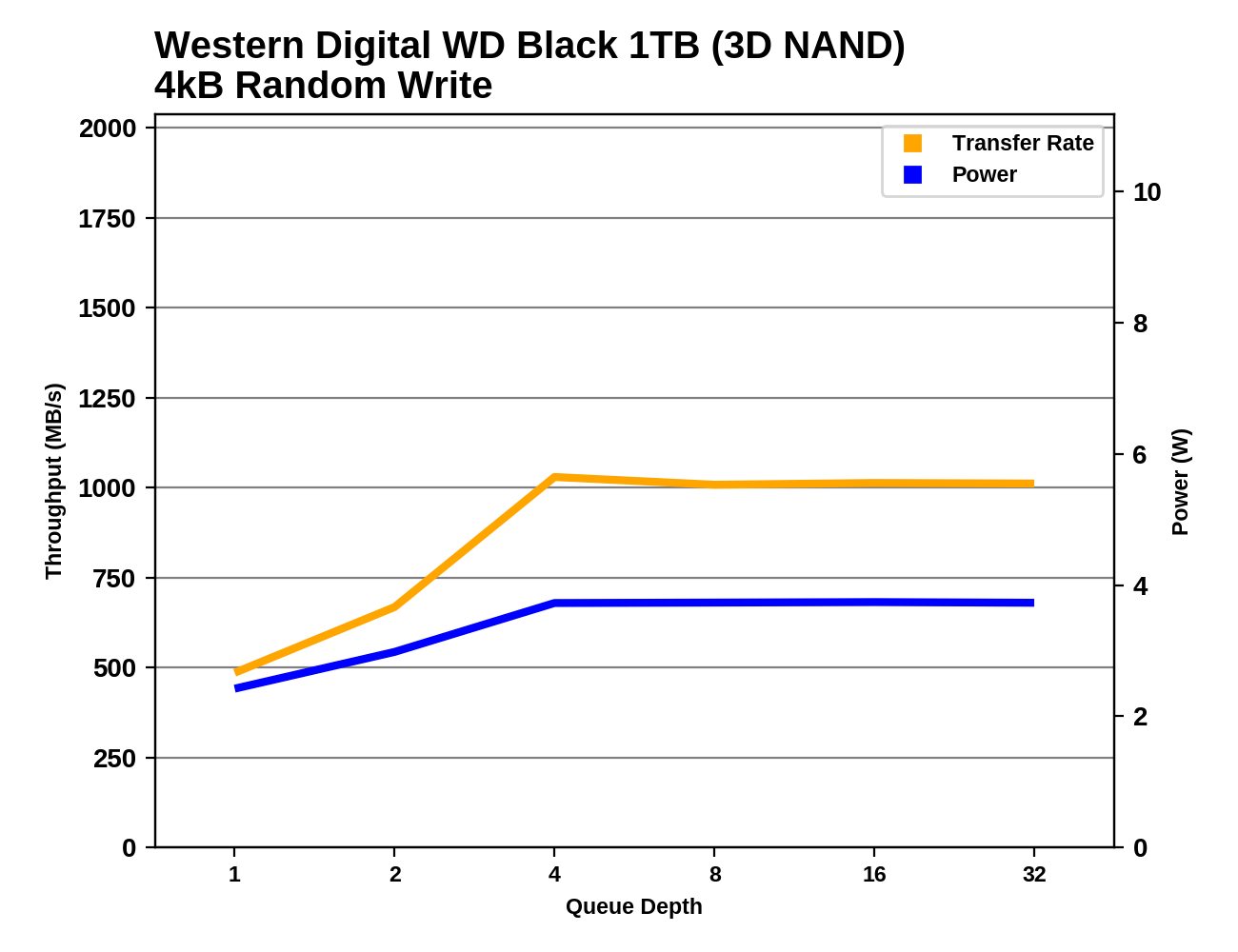
Western the Digital the WD Black 1TB (3D of NAND)
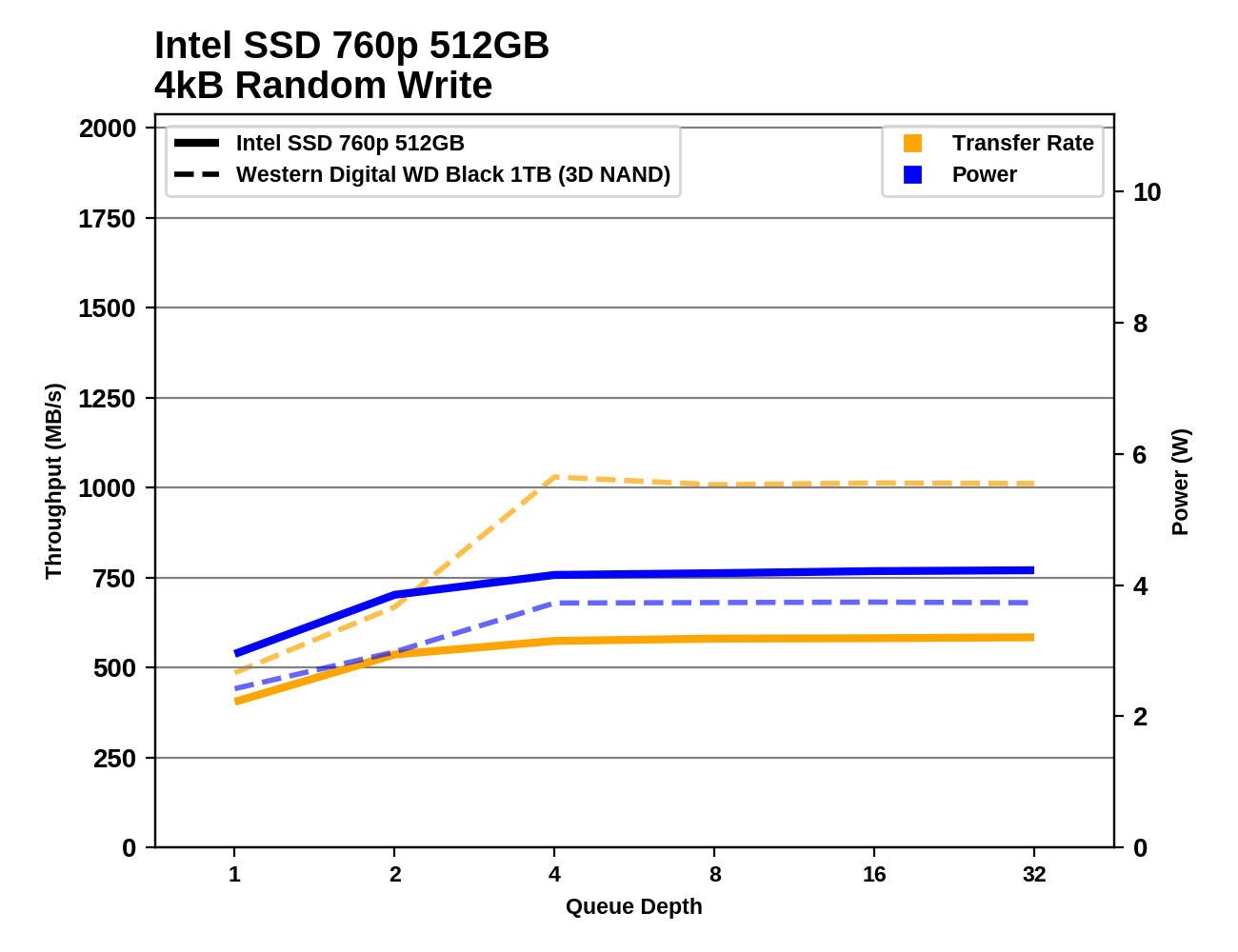
the Intel the SSD 760p 512GB
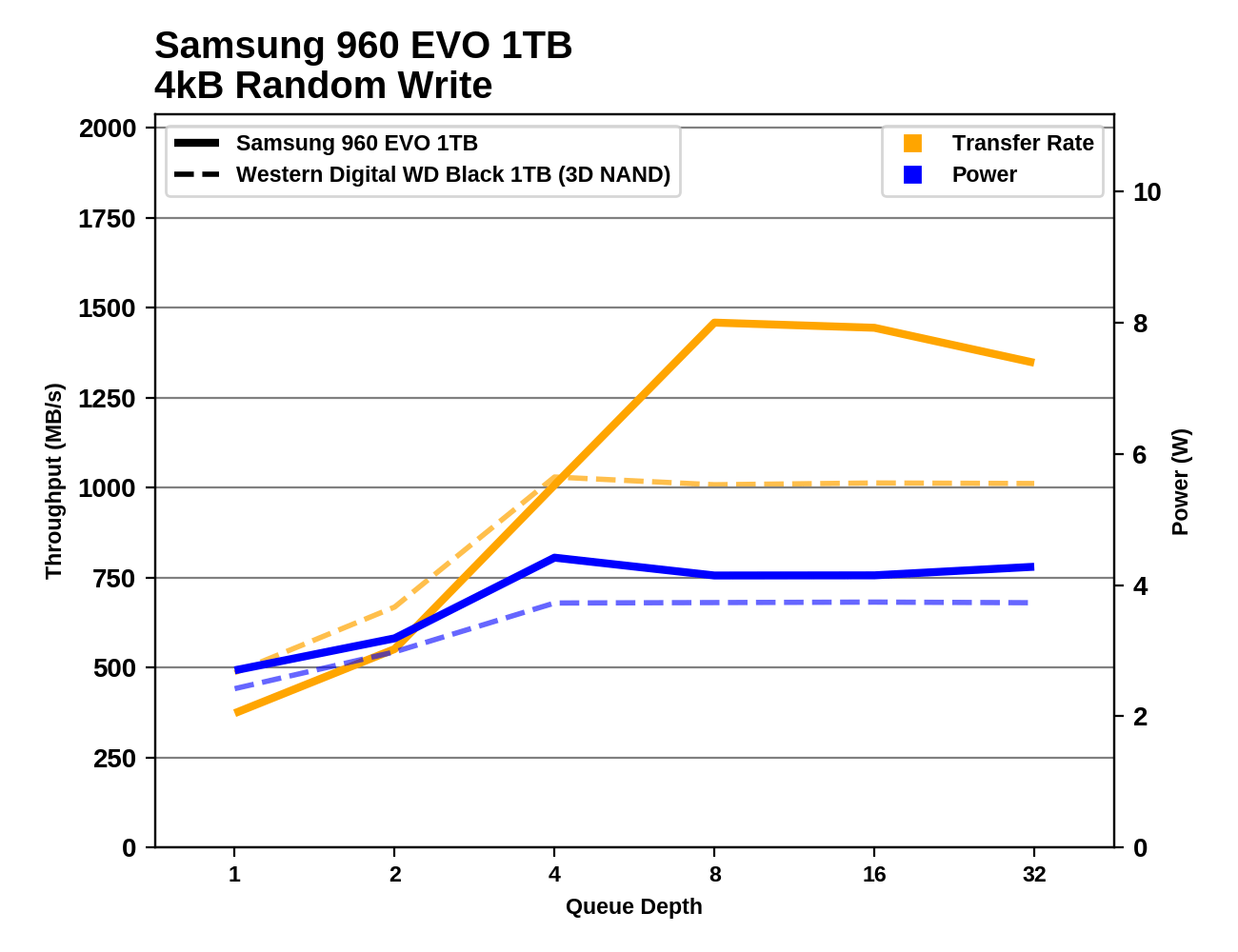
the Samsung 960 the EVO 1TB
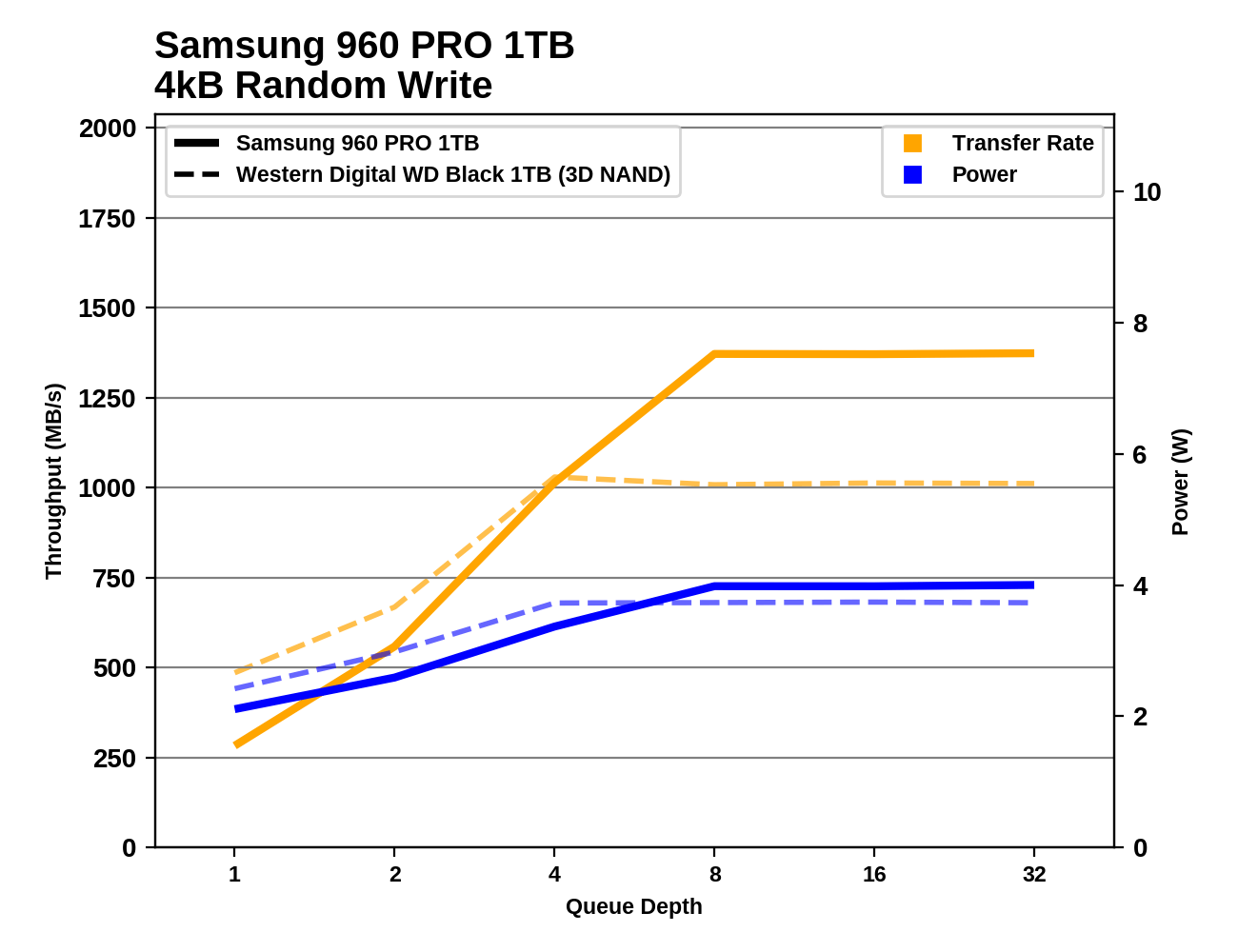
the Samsung 960 the PRO 1TB
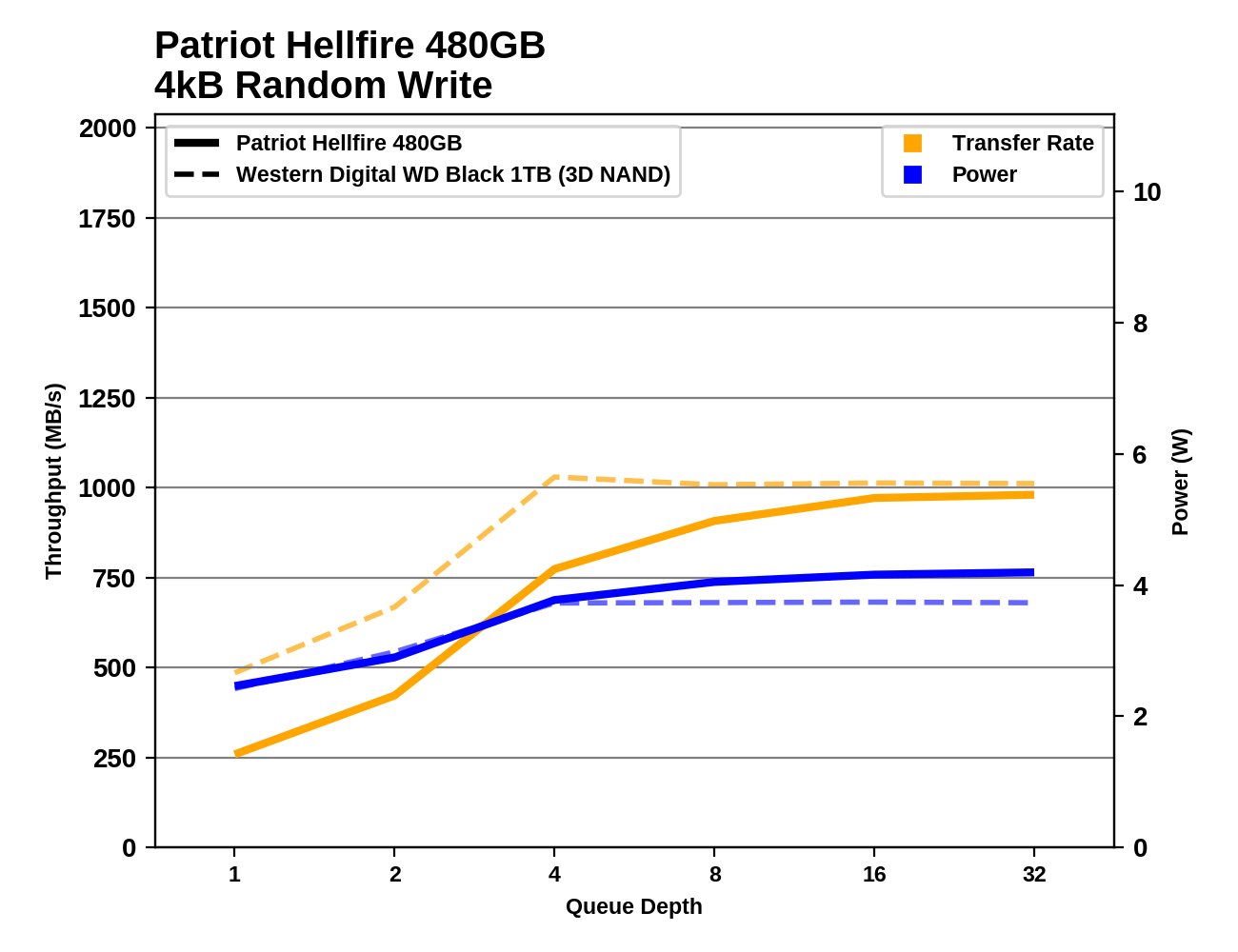
Patriot the Hellfire 480GB

the Samsung PM981 1TB
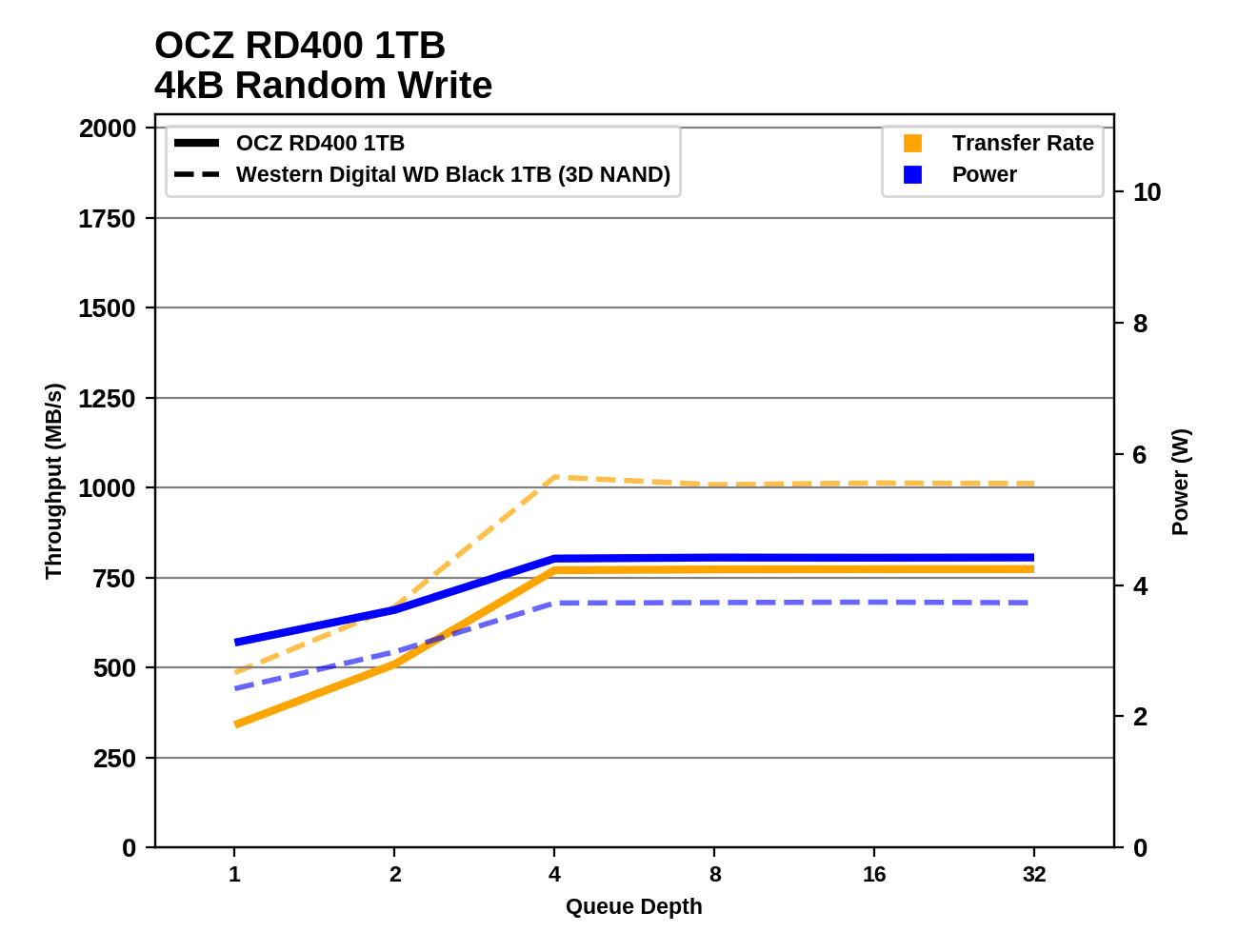
the OCZ RD 400 1TB
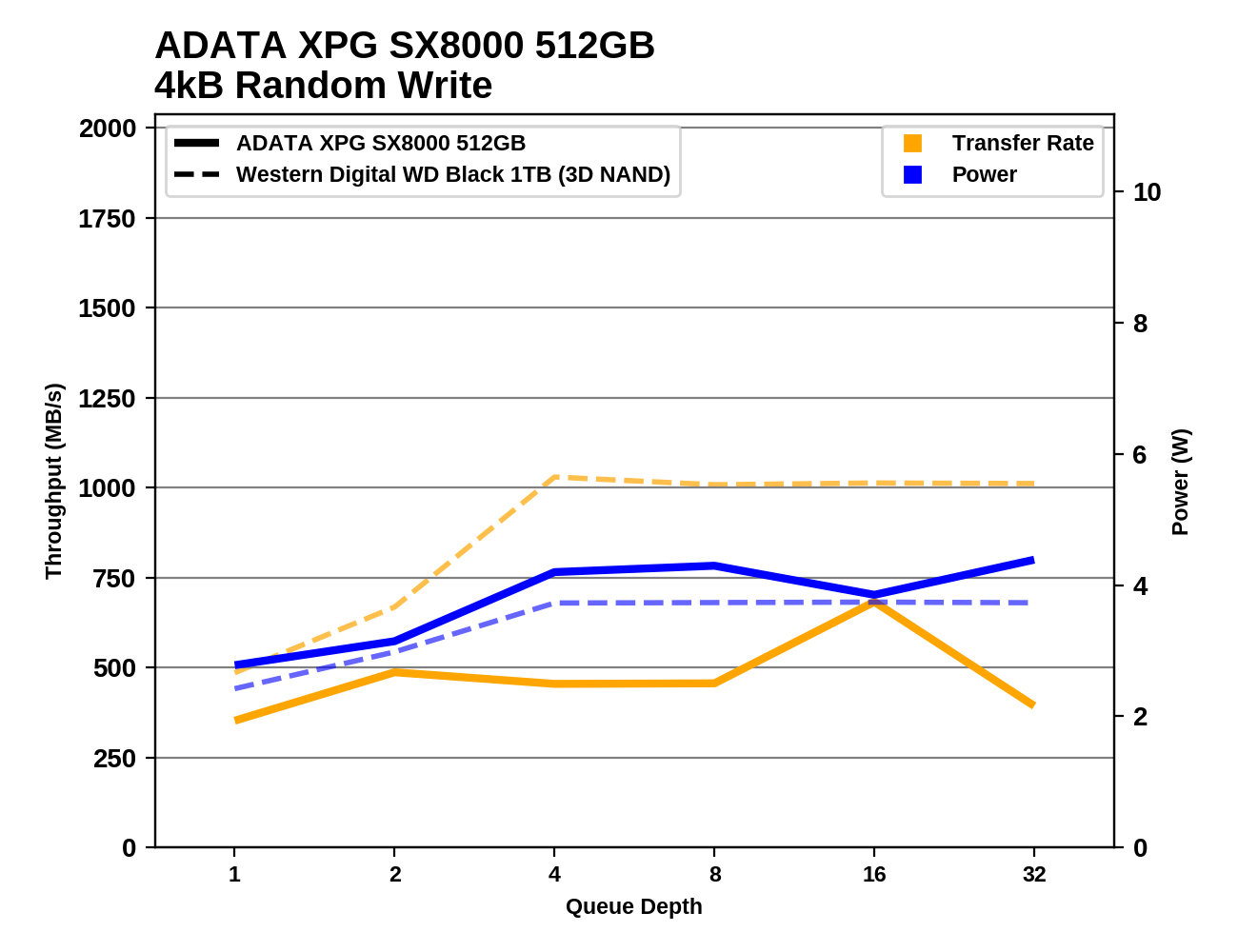
the ADATA XPG SX8000 512 GB
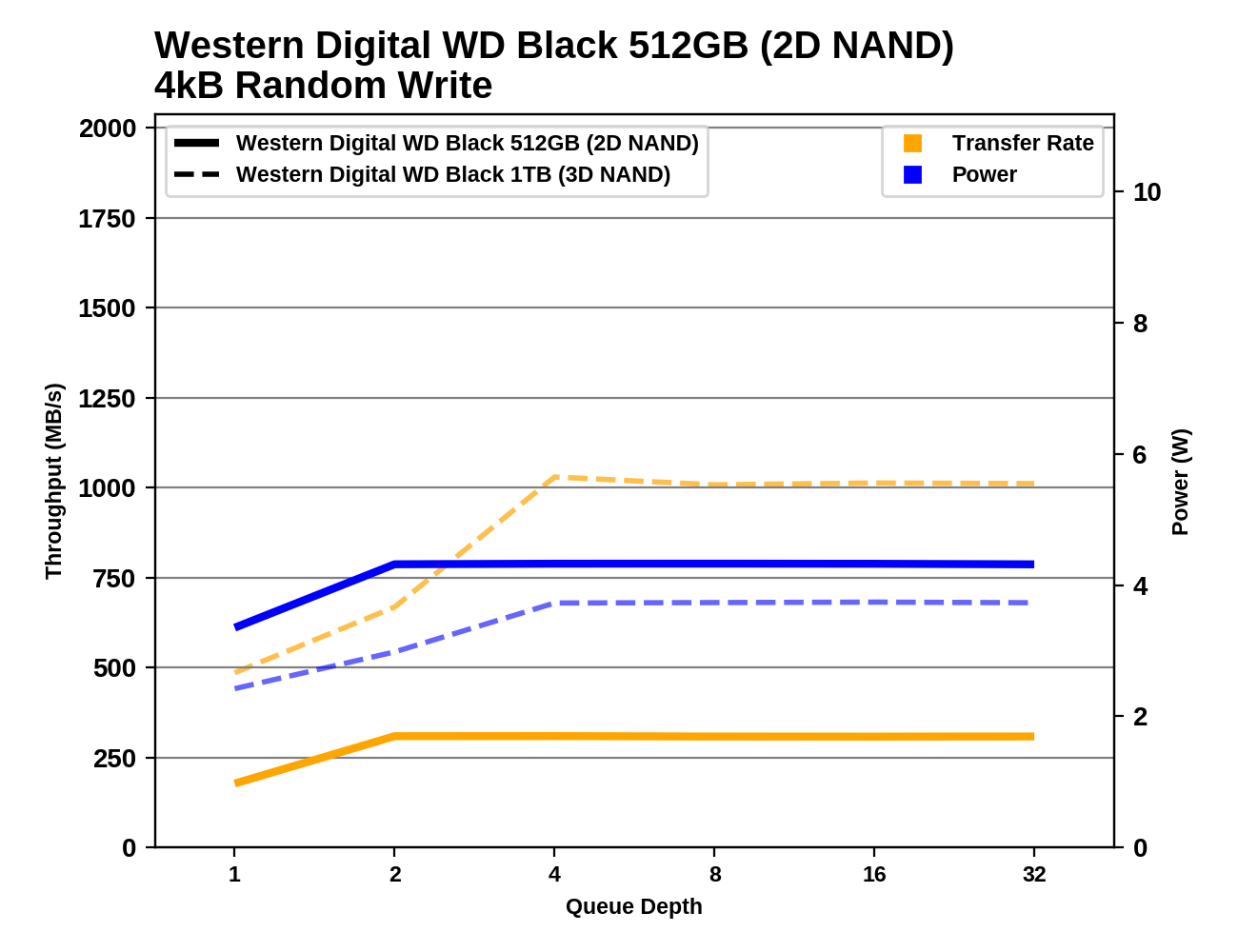
Western the Digital the WD Black 512GB (2D of NAND)
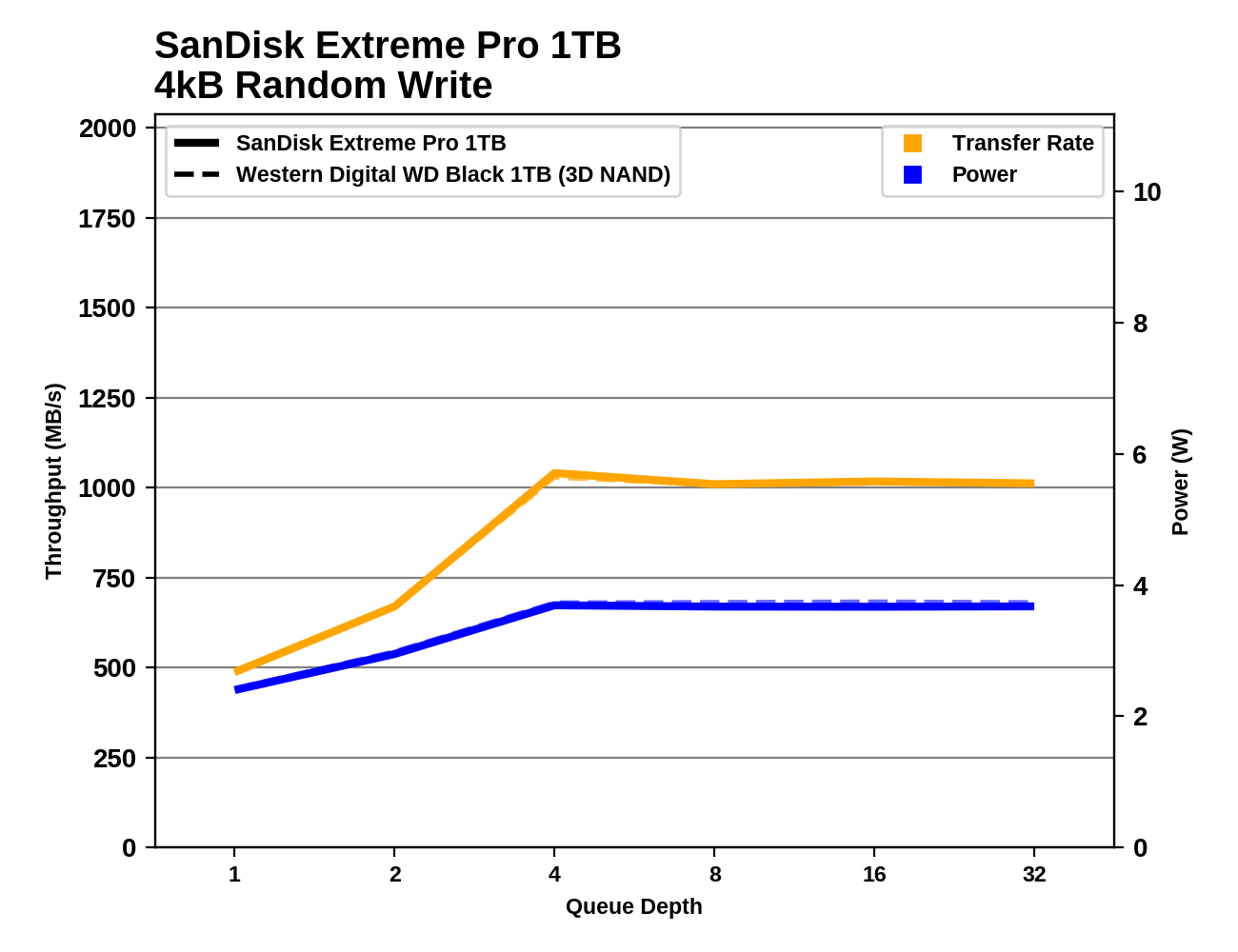
SanDisc Extreme the PRO 1TB
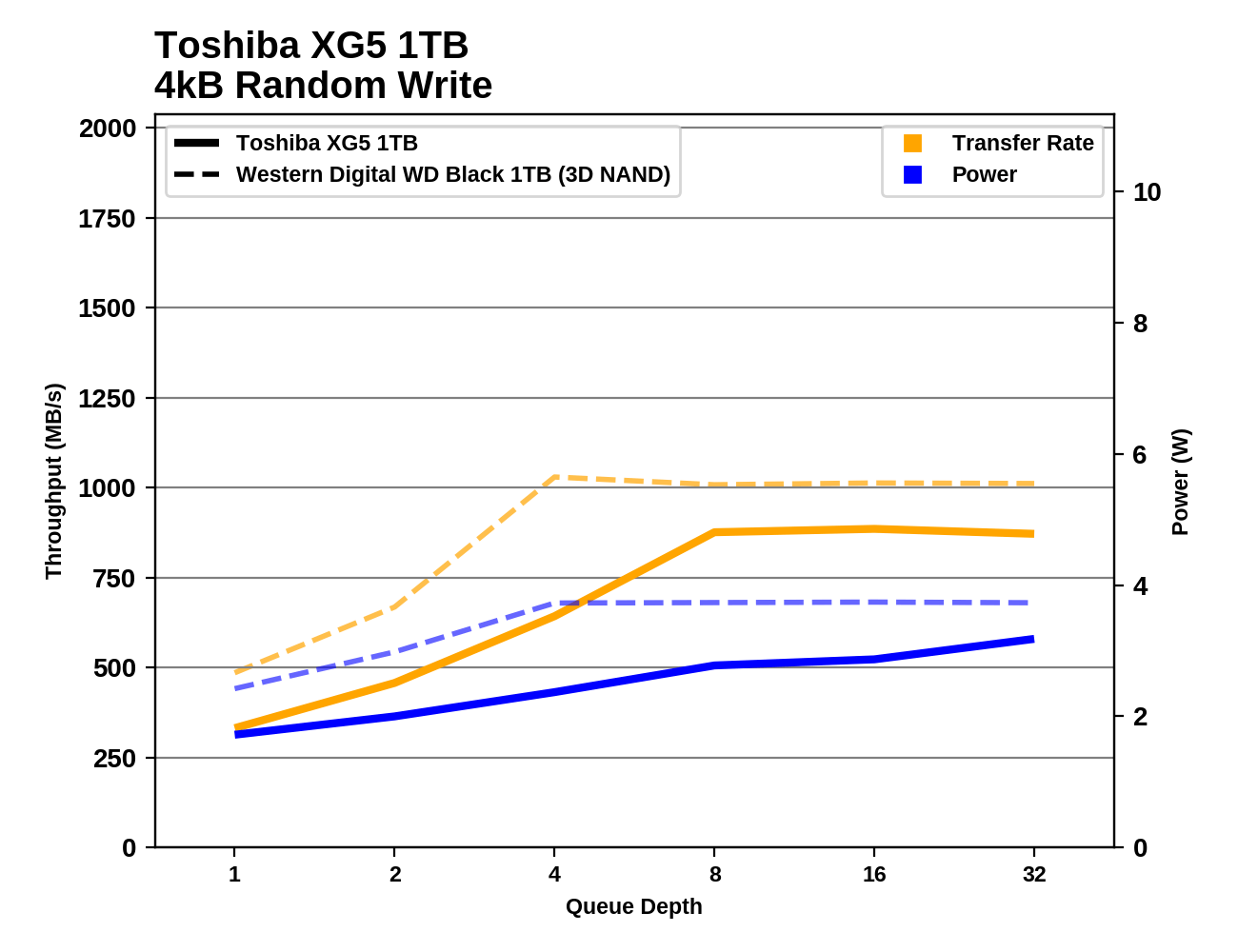
the Toshiba XG5 1TB
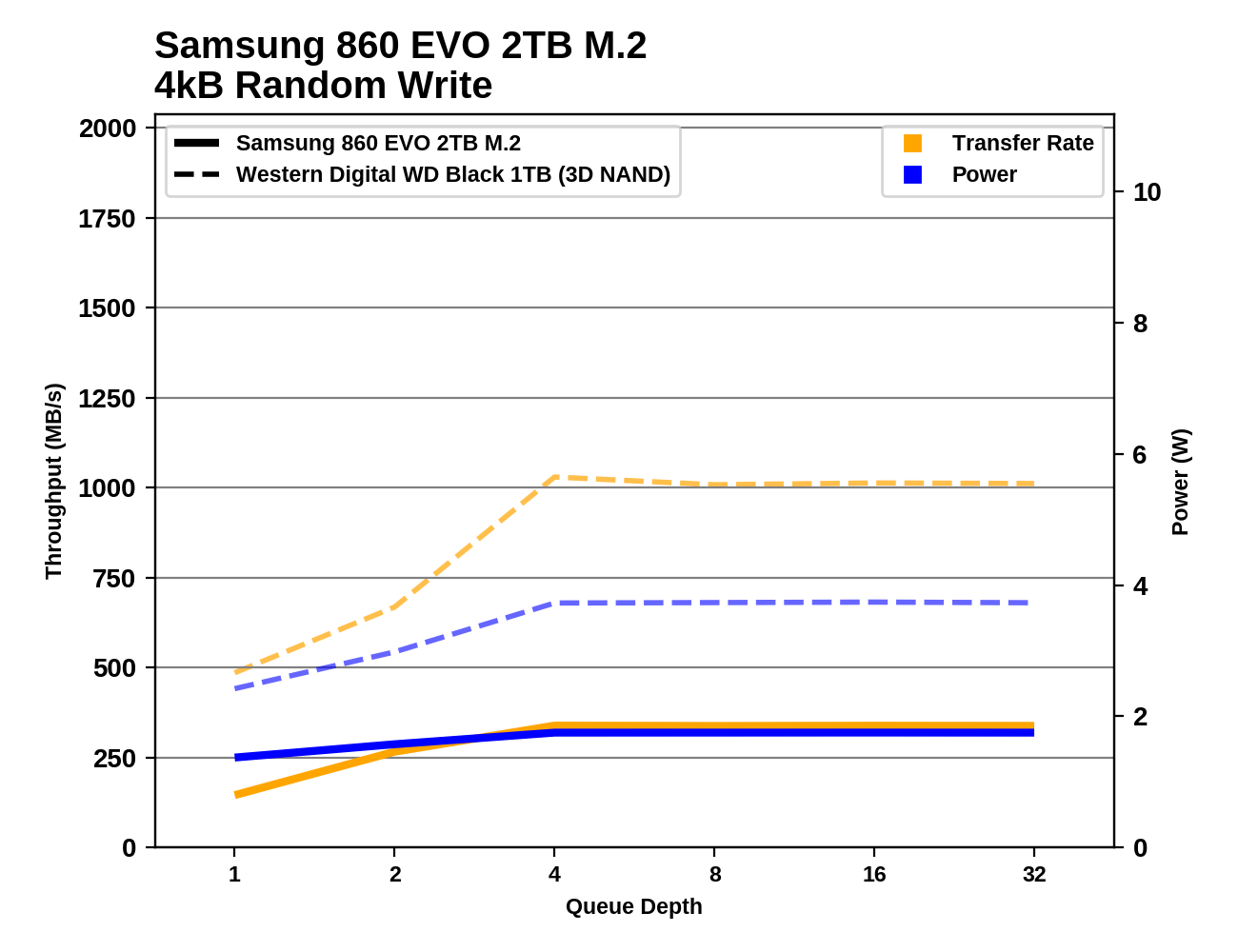
Samsung 860 EVO 2TB M.2

Crucial MX500 1TB
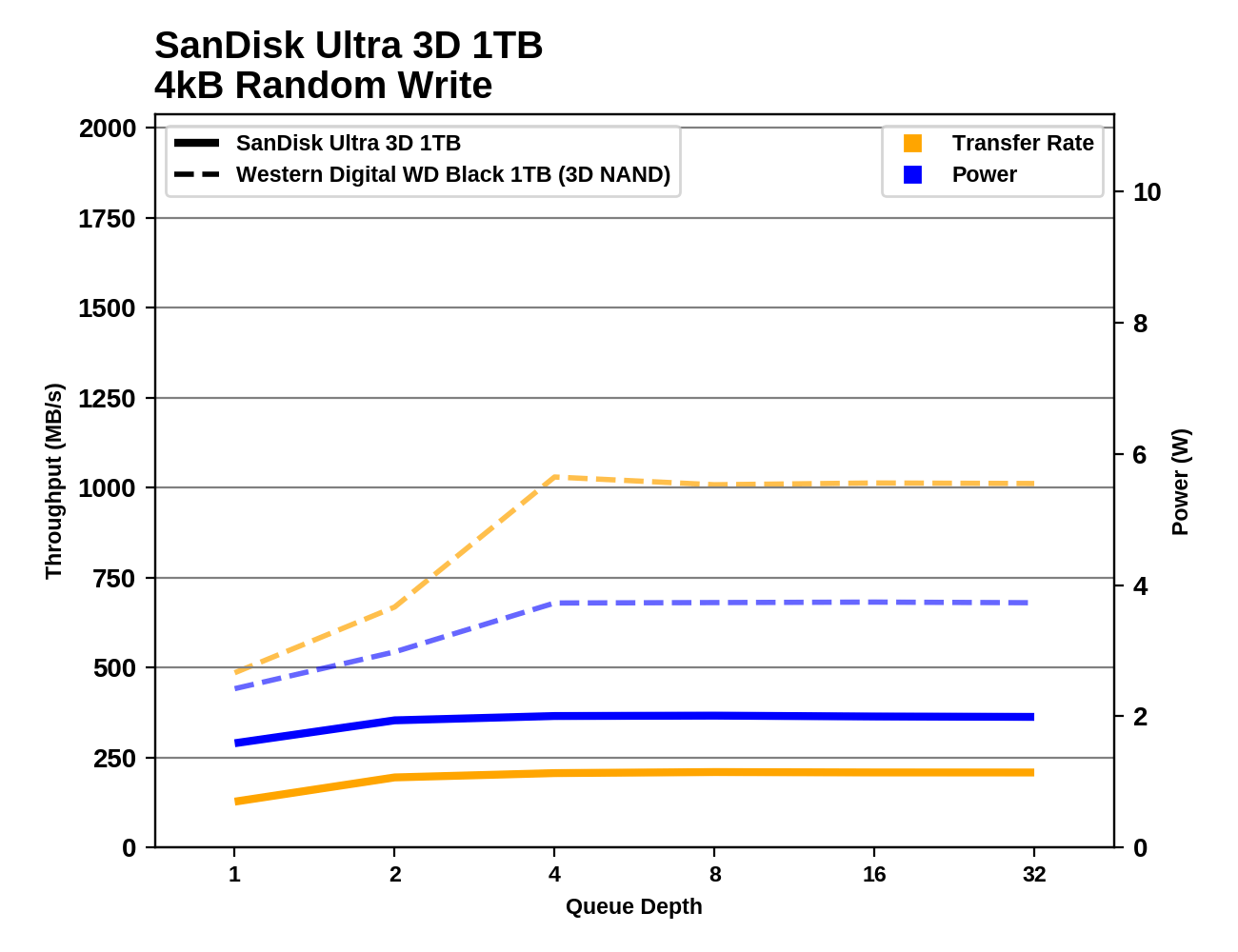
SanDisc Ultra 3D 1TB
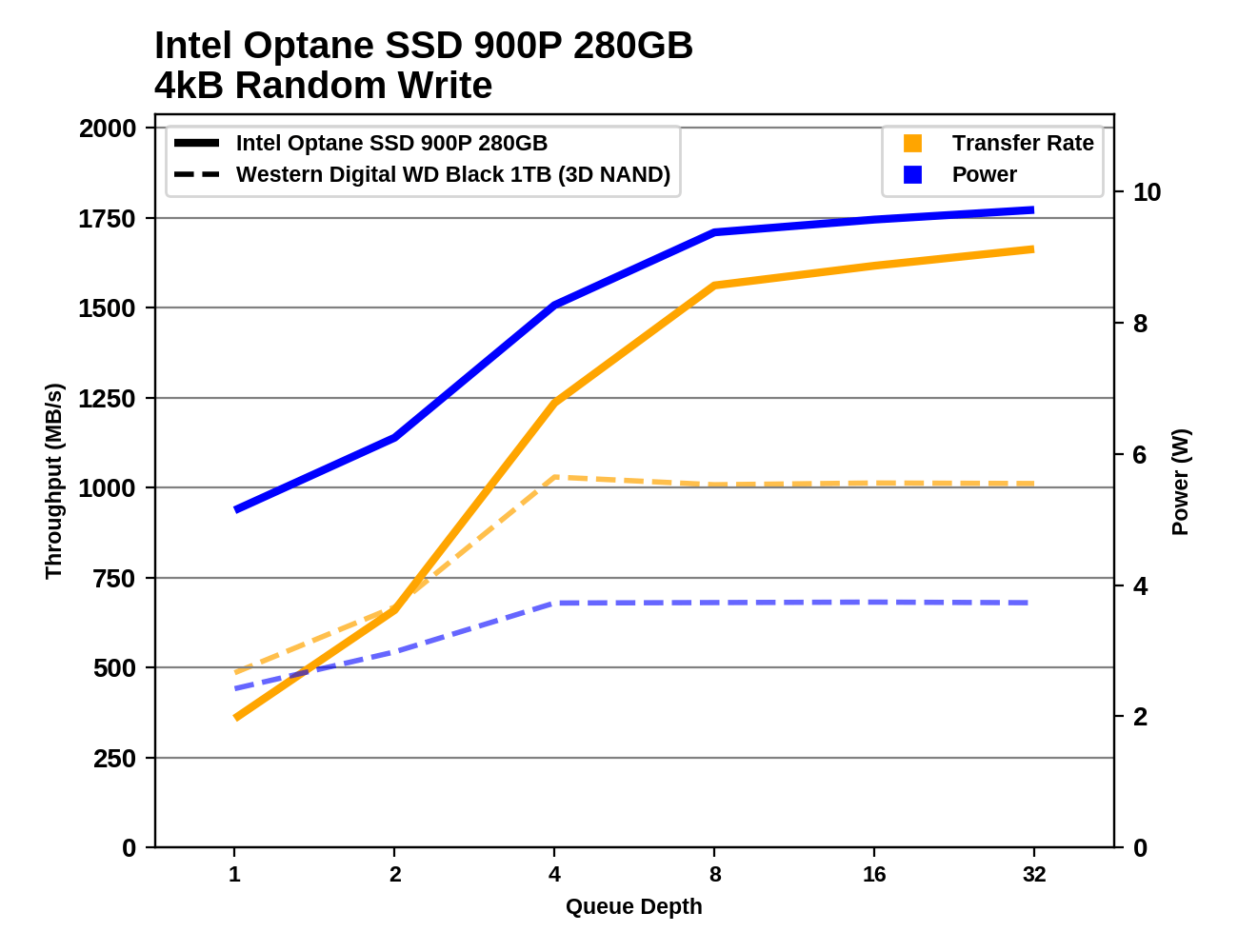
Intel Optane 900P 280GB

Western Digital WD Black 7200RPM 1TB
The performance of the random WD Black recording is saturated at the QD4 level, while the Samsung drives and some other models show gains further, and can reach higher levels of performance with a greater queue depth. Nevertheless, WD Black has excellent performance with arbitrary recording, with more important - low queue depths.
Sequential read performance
Our first sequential read performance test uses short bursts of 128 MB each, executed as operations in 128 KB blocks without queues. The test averages eight bursts of performance for a total of 1 GB of data read from a disk containing 16 GB of data. The drive idle time between each burst is sufficient for a total duty cycle of 20%.
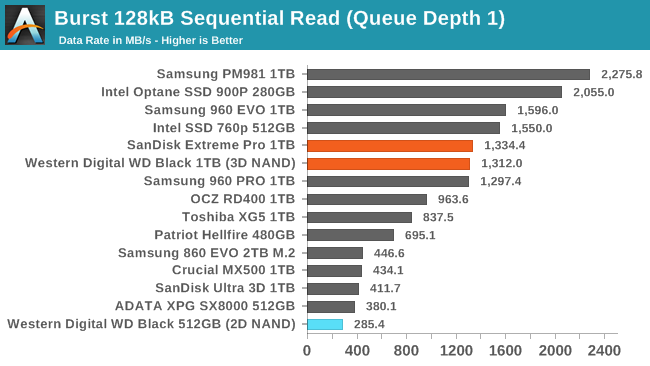
As we can see, the sequential read speed of WD Black is several times higher than in the last year’s model, but still far from setting records.
The sequential read test uses a queue depth of 1 to 32, with performance and power figures calculated as the average of QD1, QD2, and QD4. Each queue depth is checked one minute or 32 GB (which is faster) from a disk containing 64 GB of data.
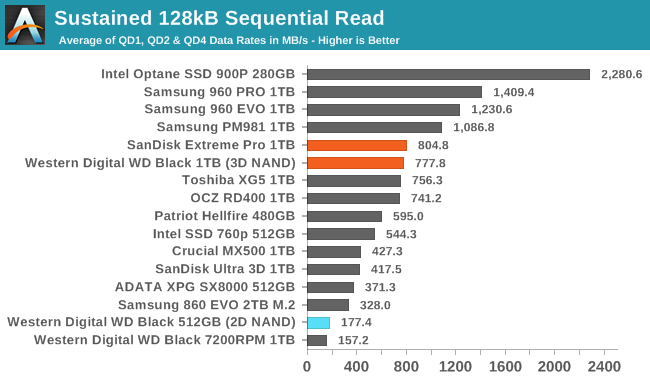
When testing sequential reads, Samsung NVMe drives definitely have an edge over WD Black.
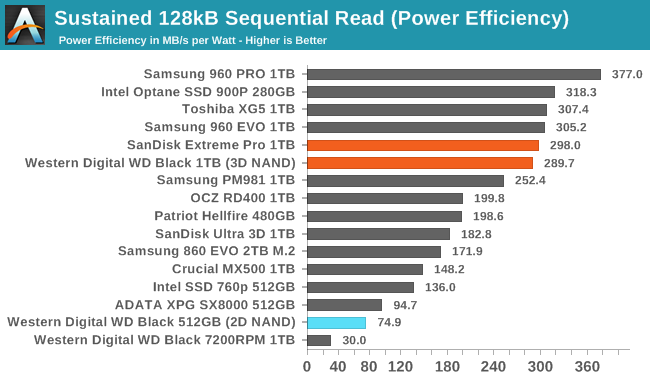
As for the energy efficiency of sequential reading, WD Black is much closer to the top, noticeably inferior only to the Samsung 960 PRO.
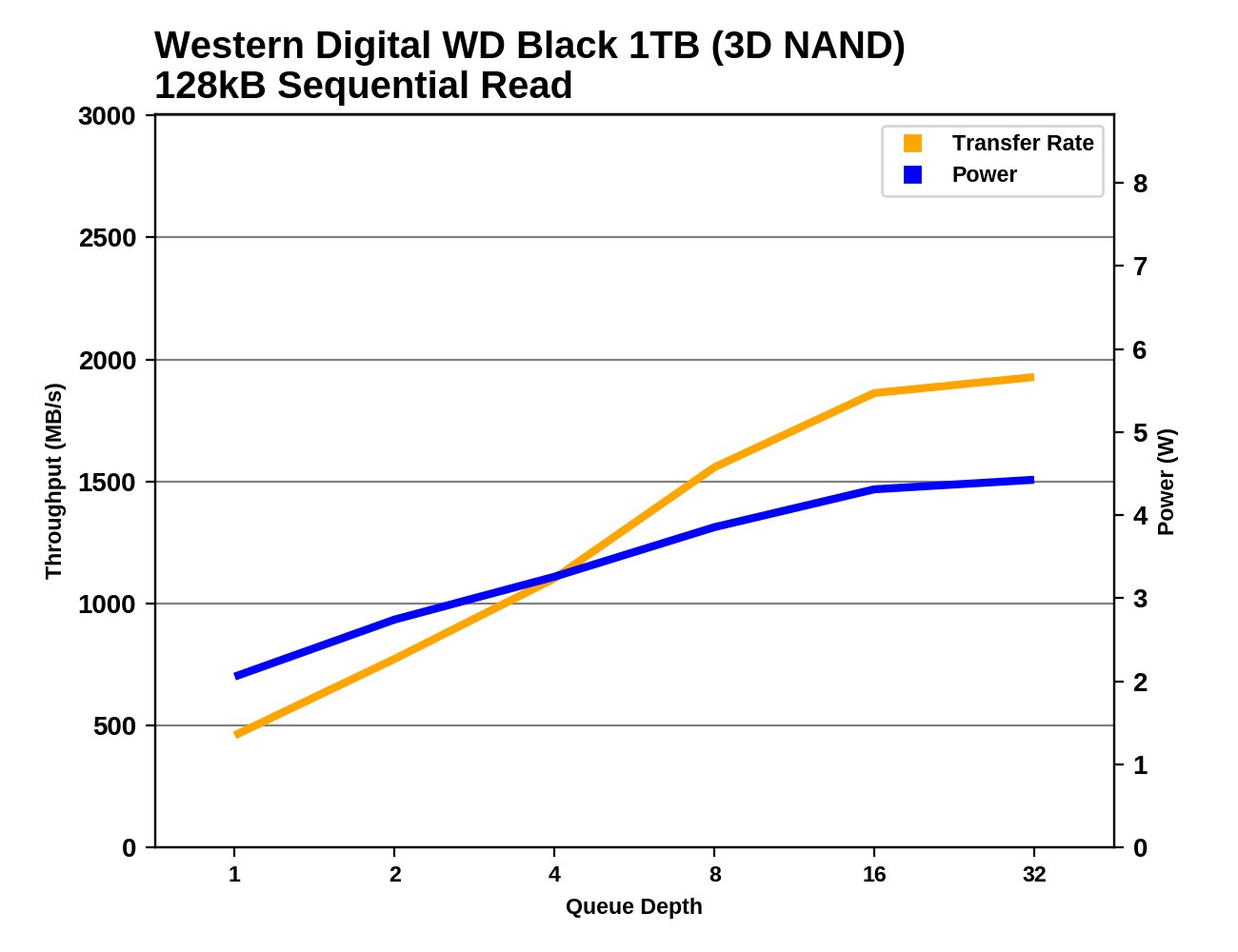
Western the Digital the WD Black 1TB (3D of NAND)
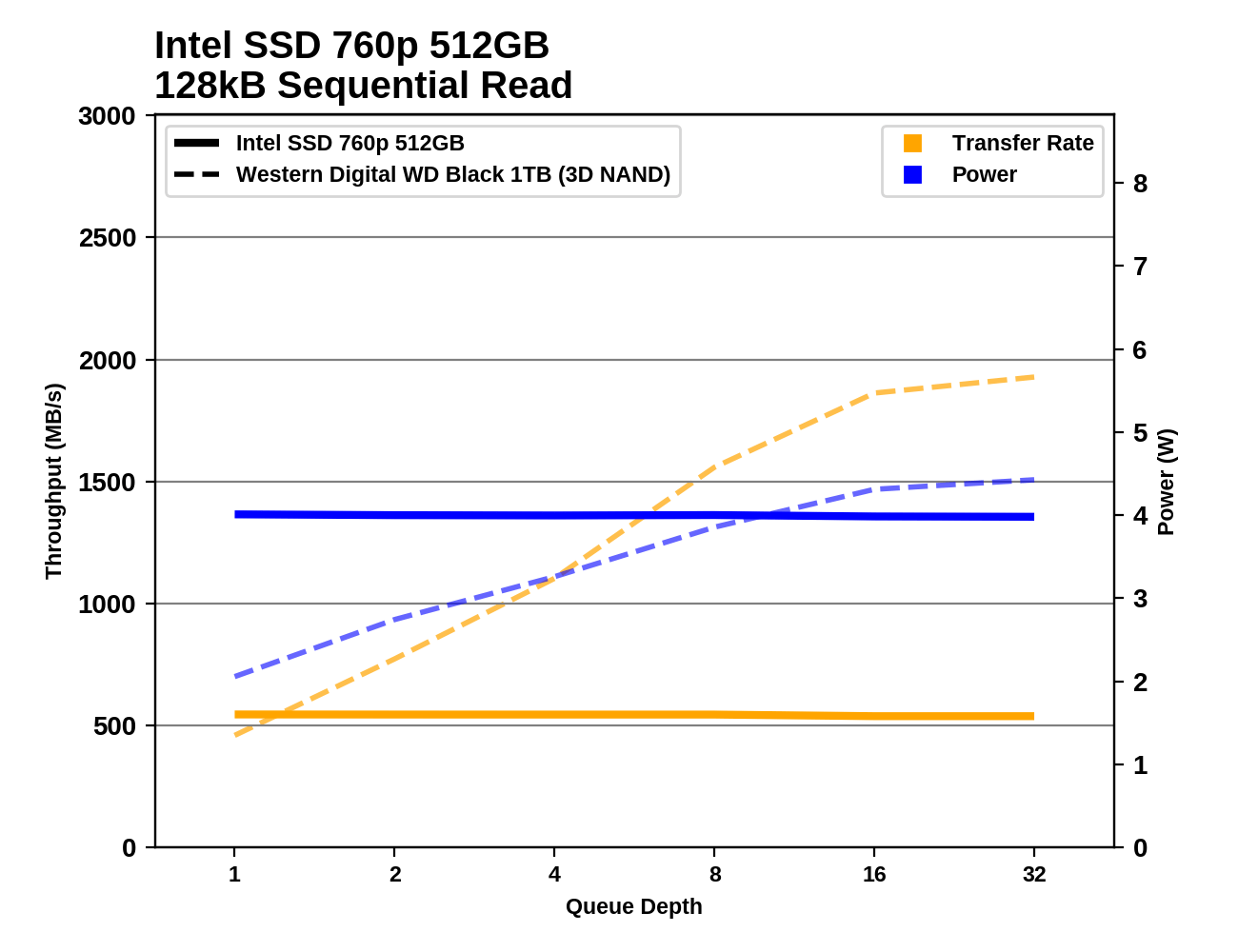
the Intel the SSD 760p 512GB
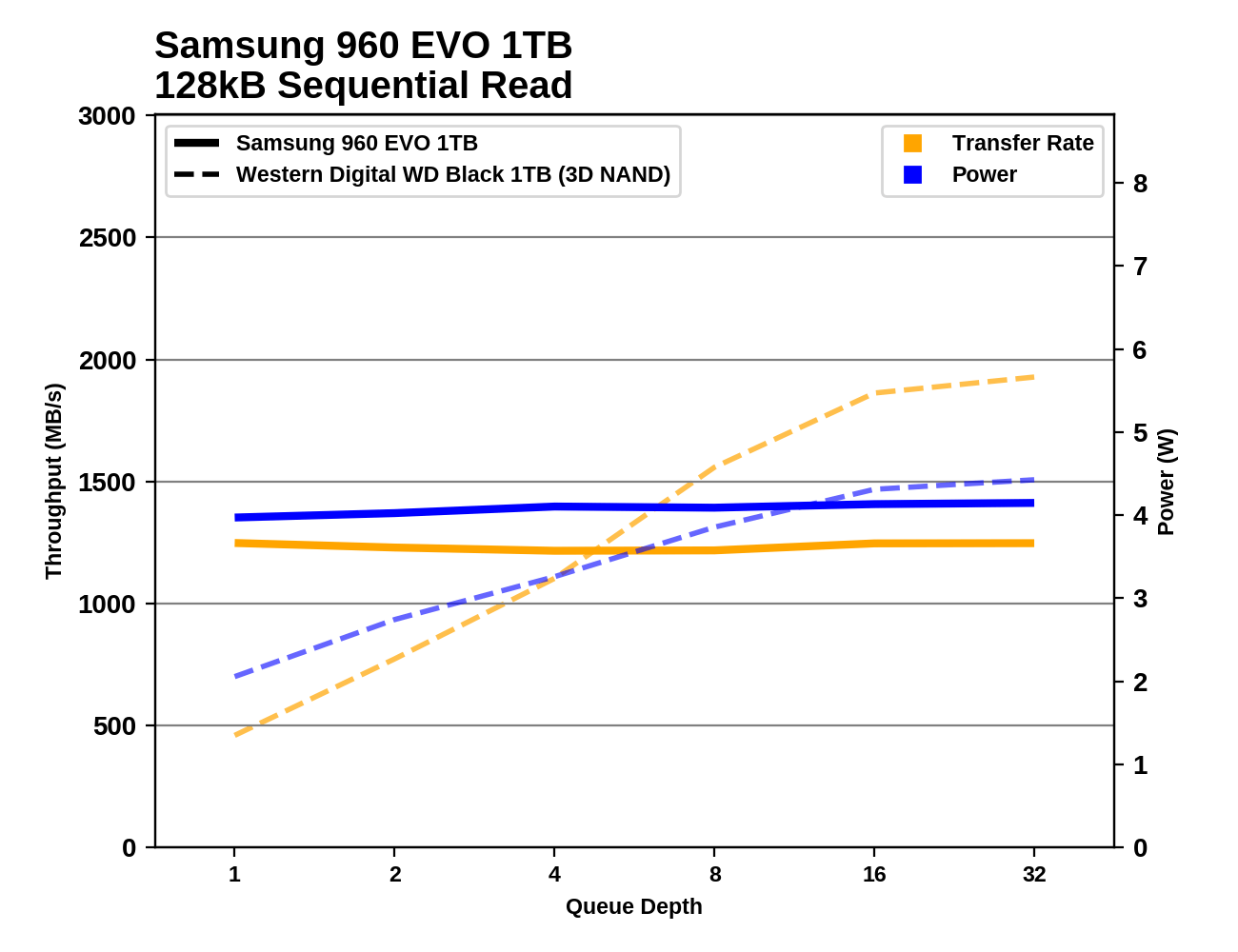
the Samsung 960 the EVO 1TB
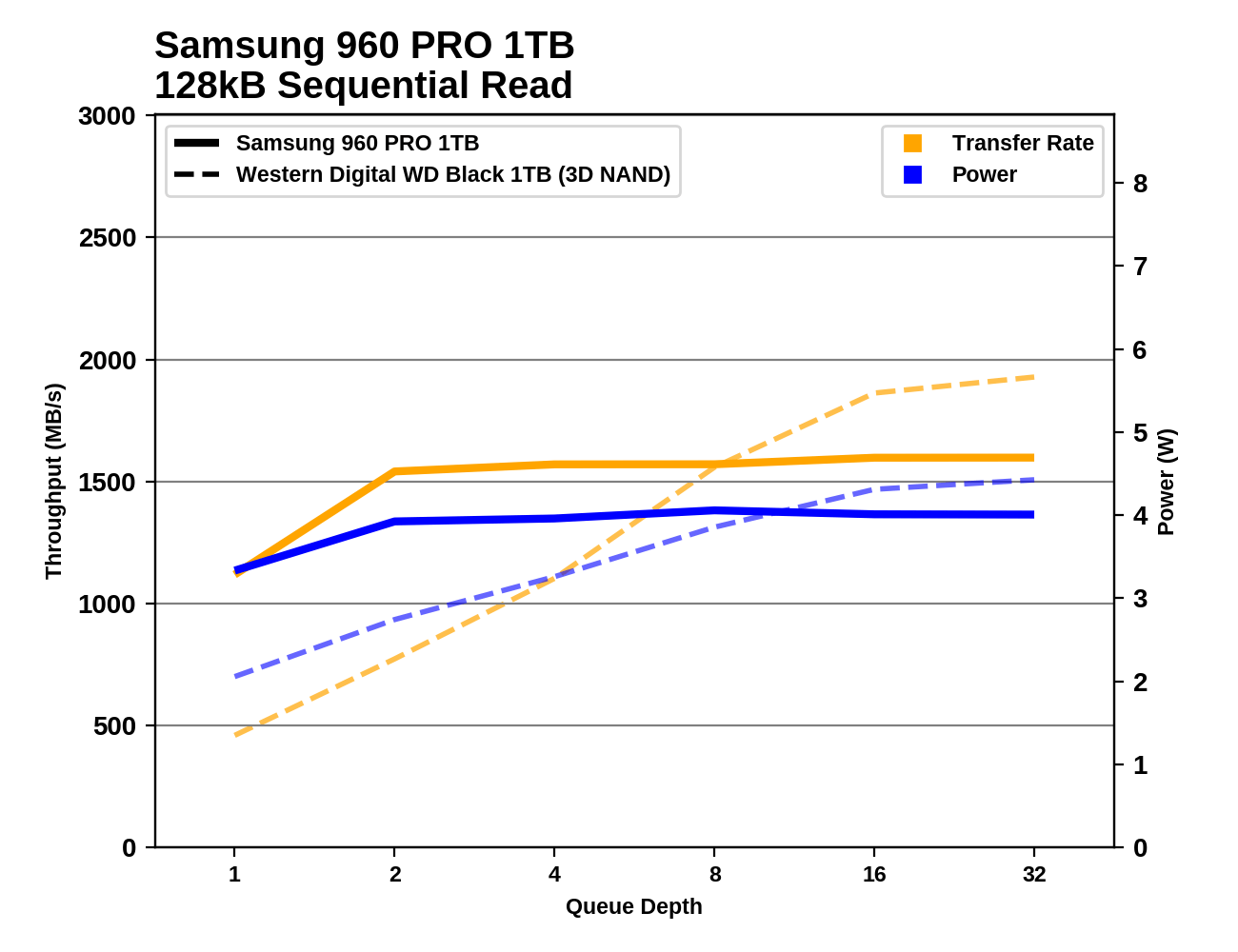
the Samsung 960 the PRO 1TB
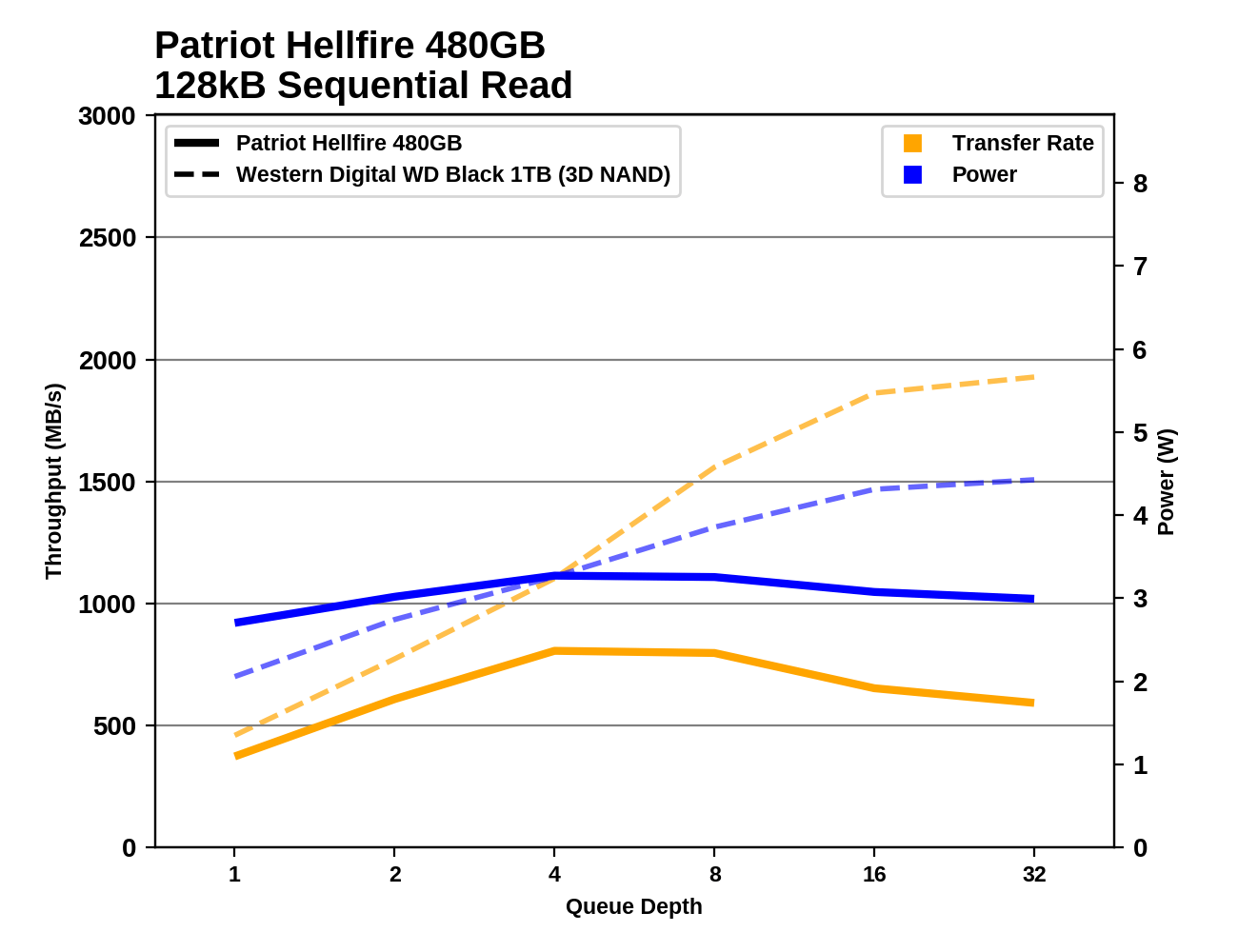
Patriot the Hellfire 480GB
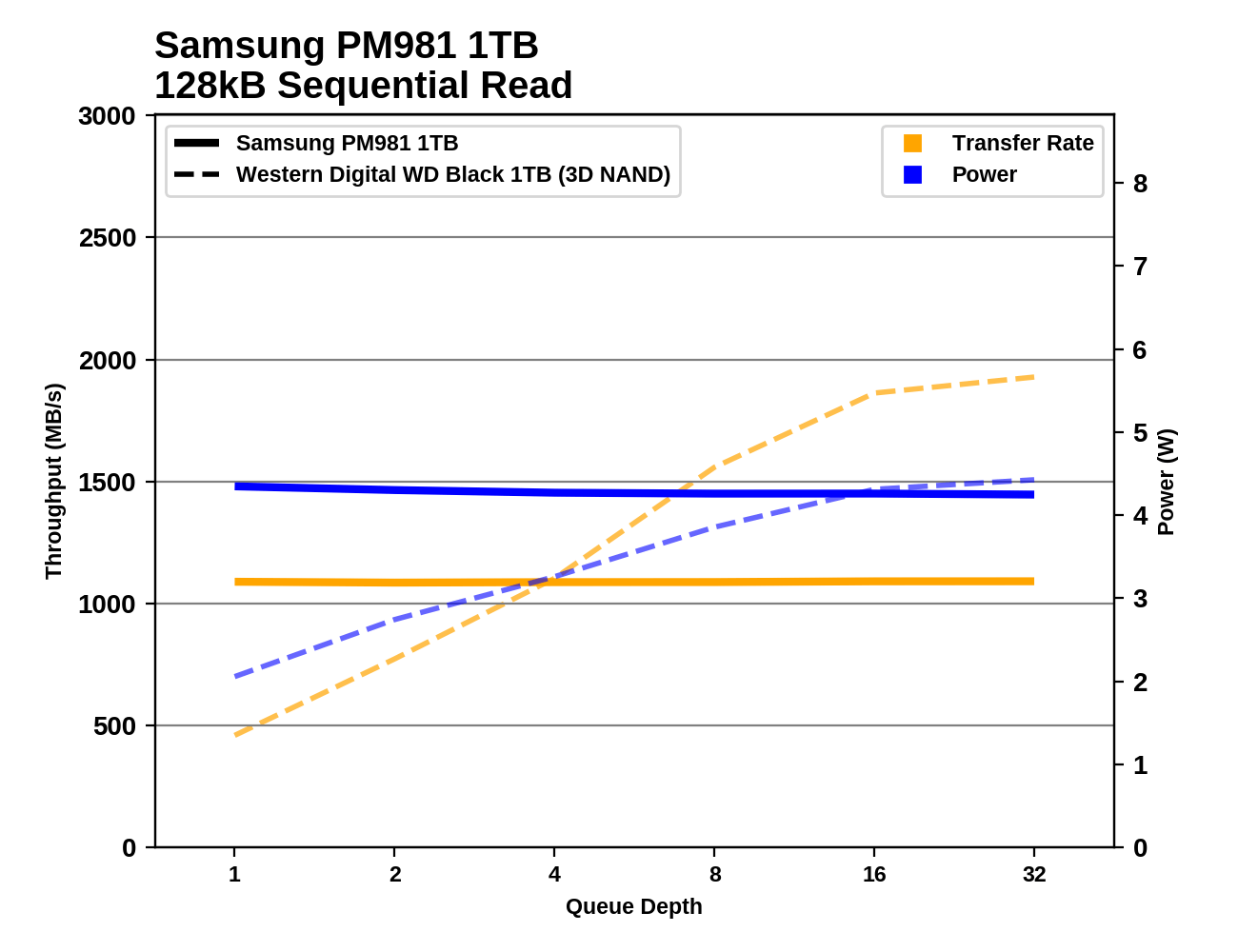
the Samsung PM981 1TB
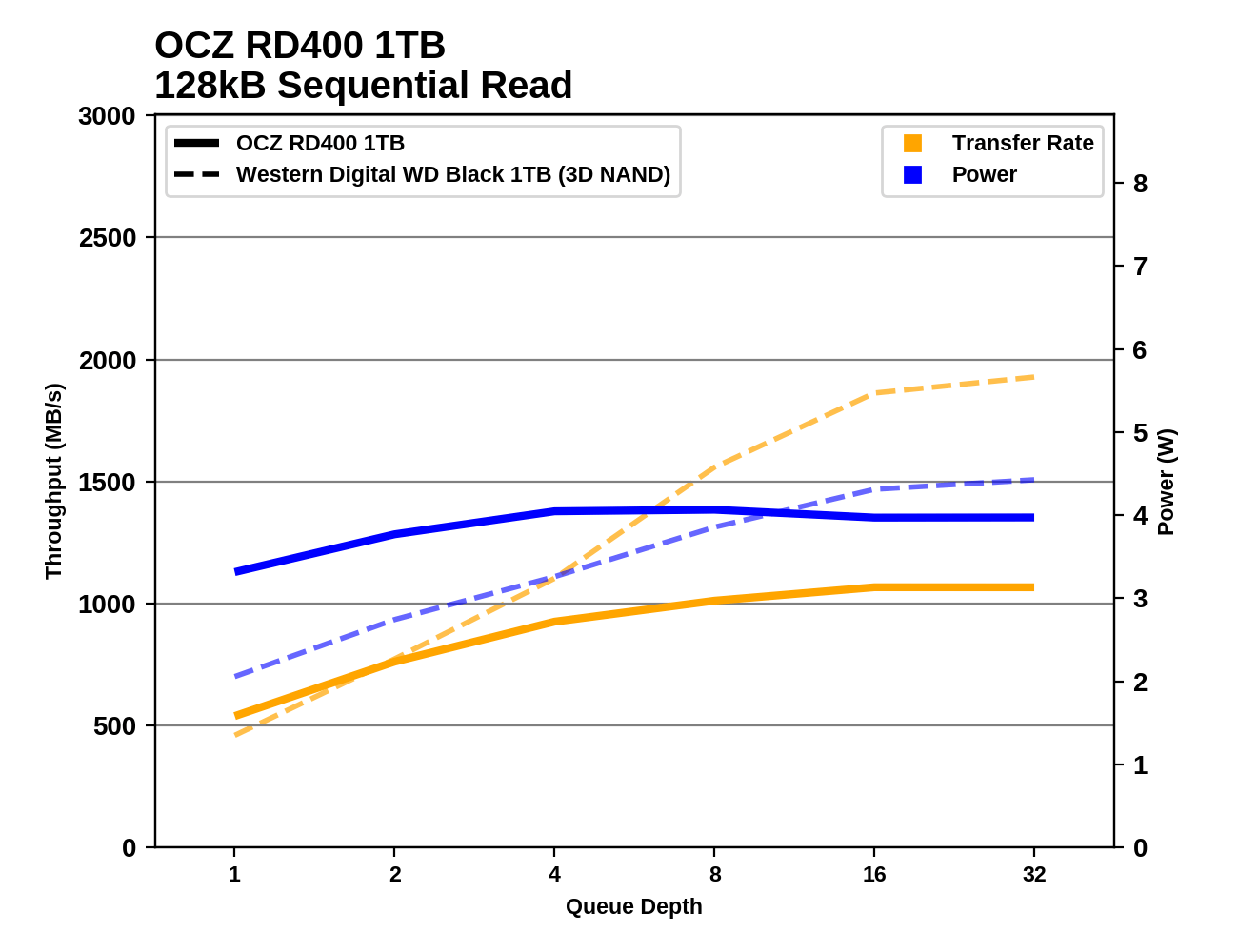
the OCZ RD 400 1TB

the ADATA XPG SX8000 512 GB
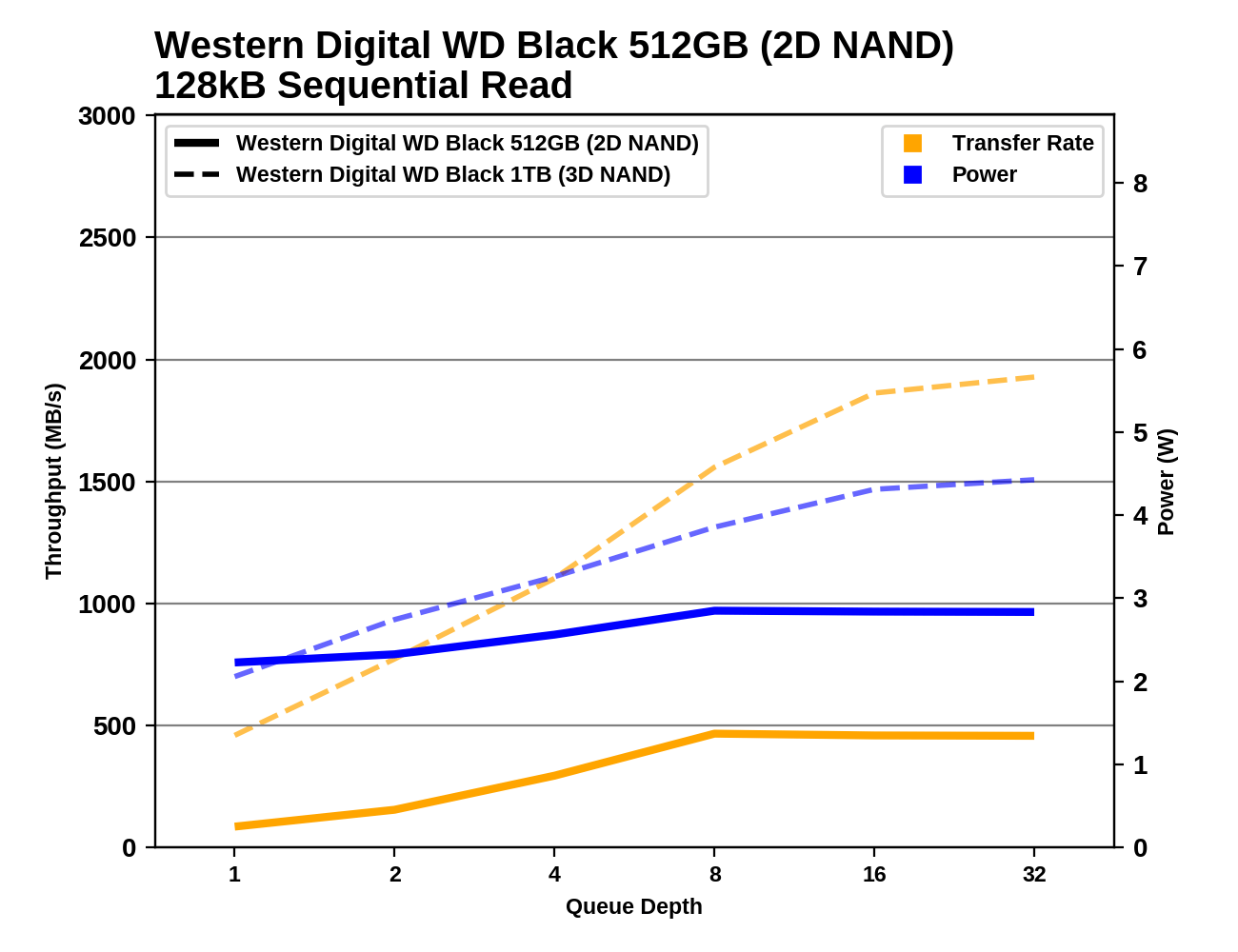
Western the Digital the WD Black 512GB (2D of NAND)
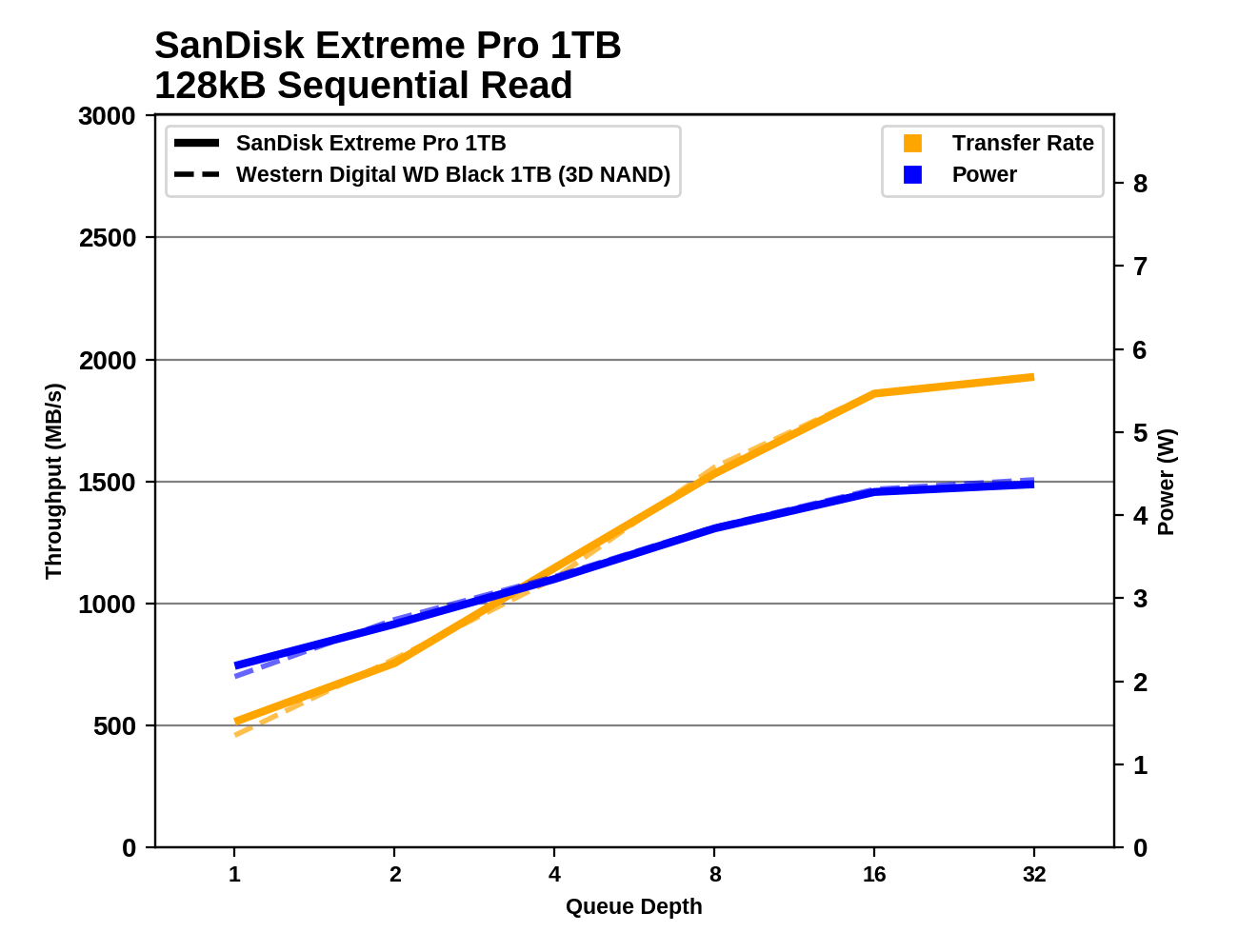
SanDisc Extreme the PRO 1TB
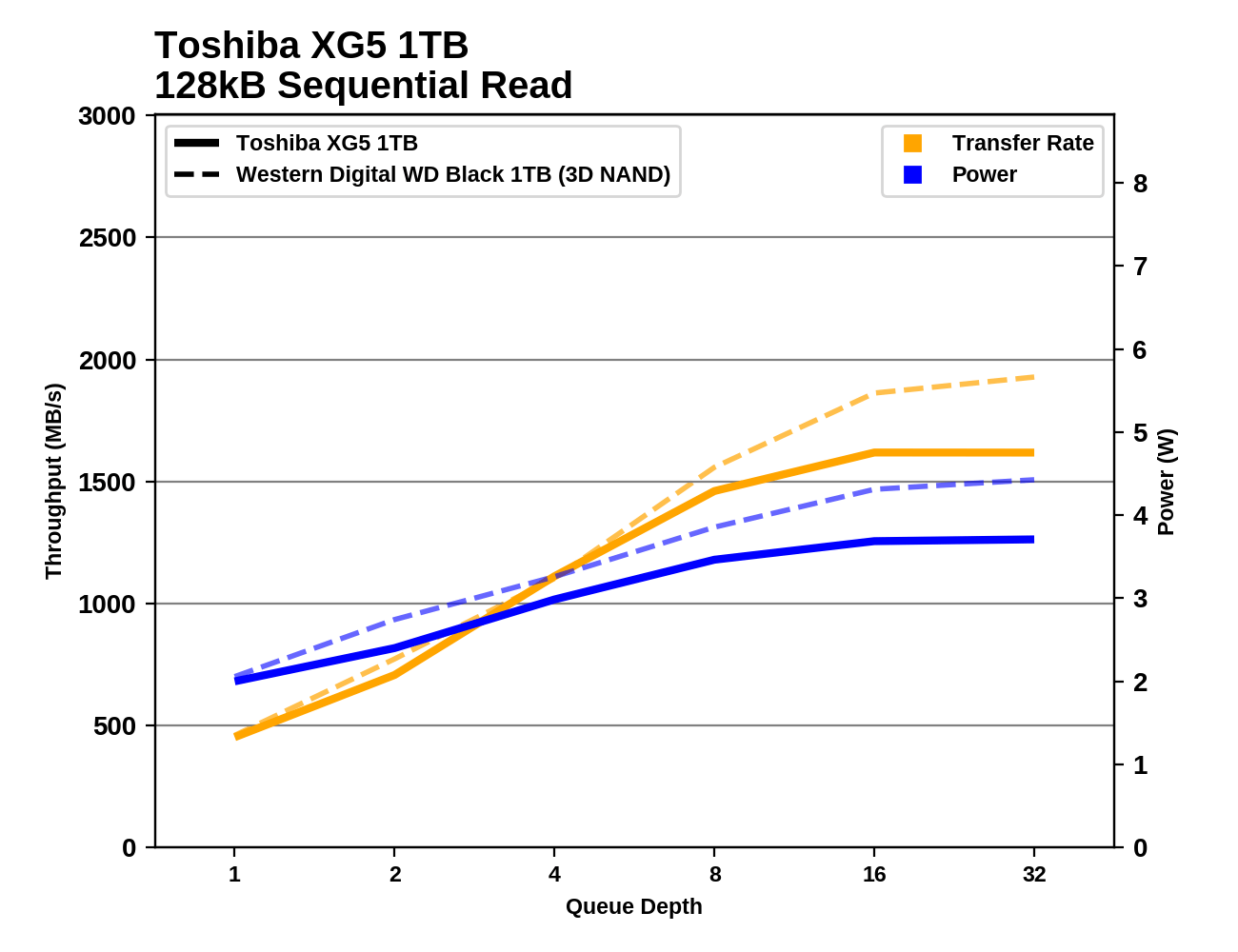
the Toshiba XG5 1TB
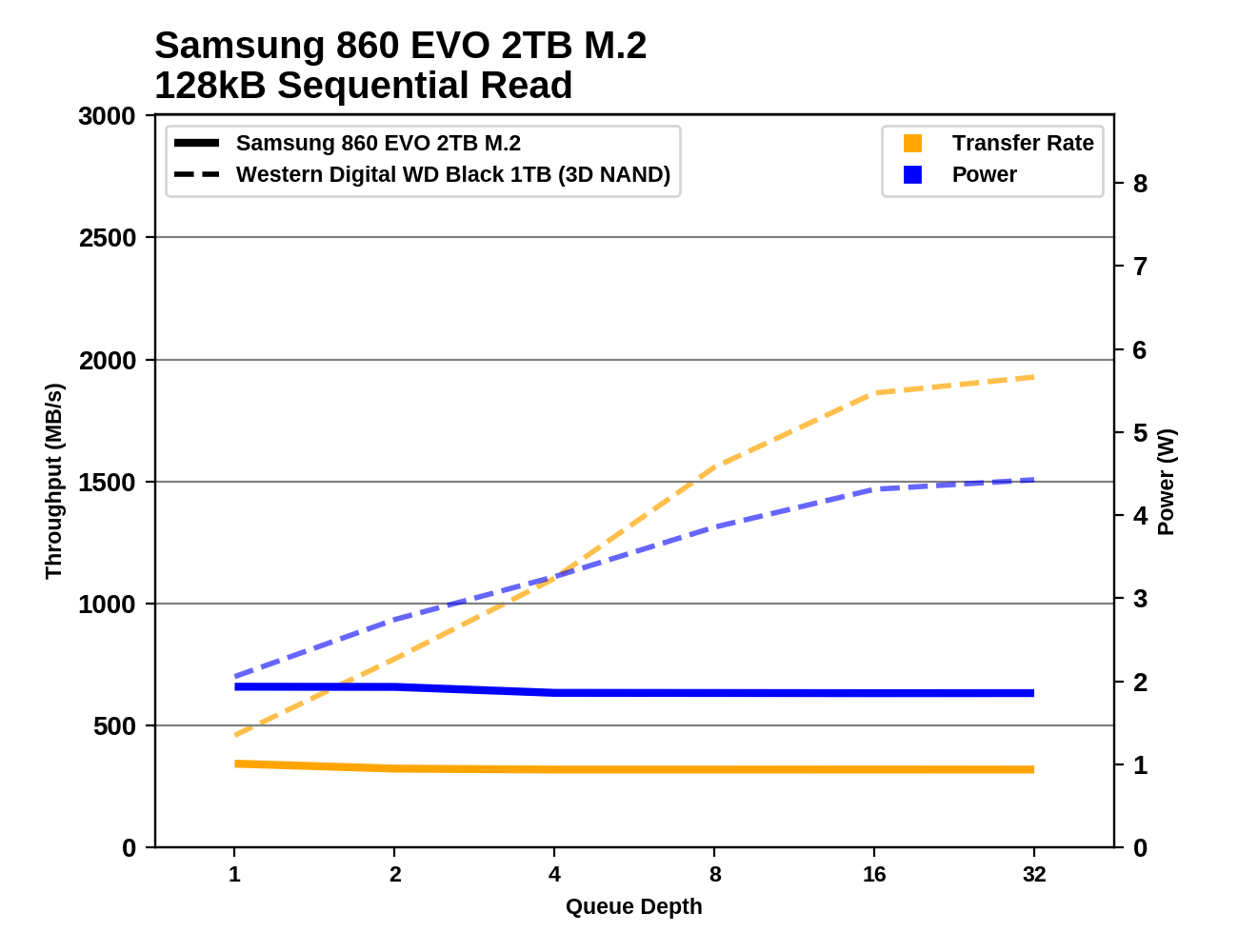
Samsung 860 EVO 2TB M.2
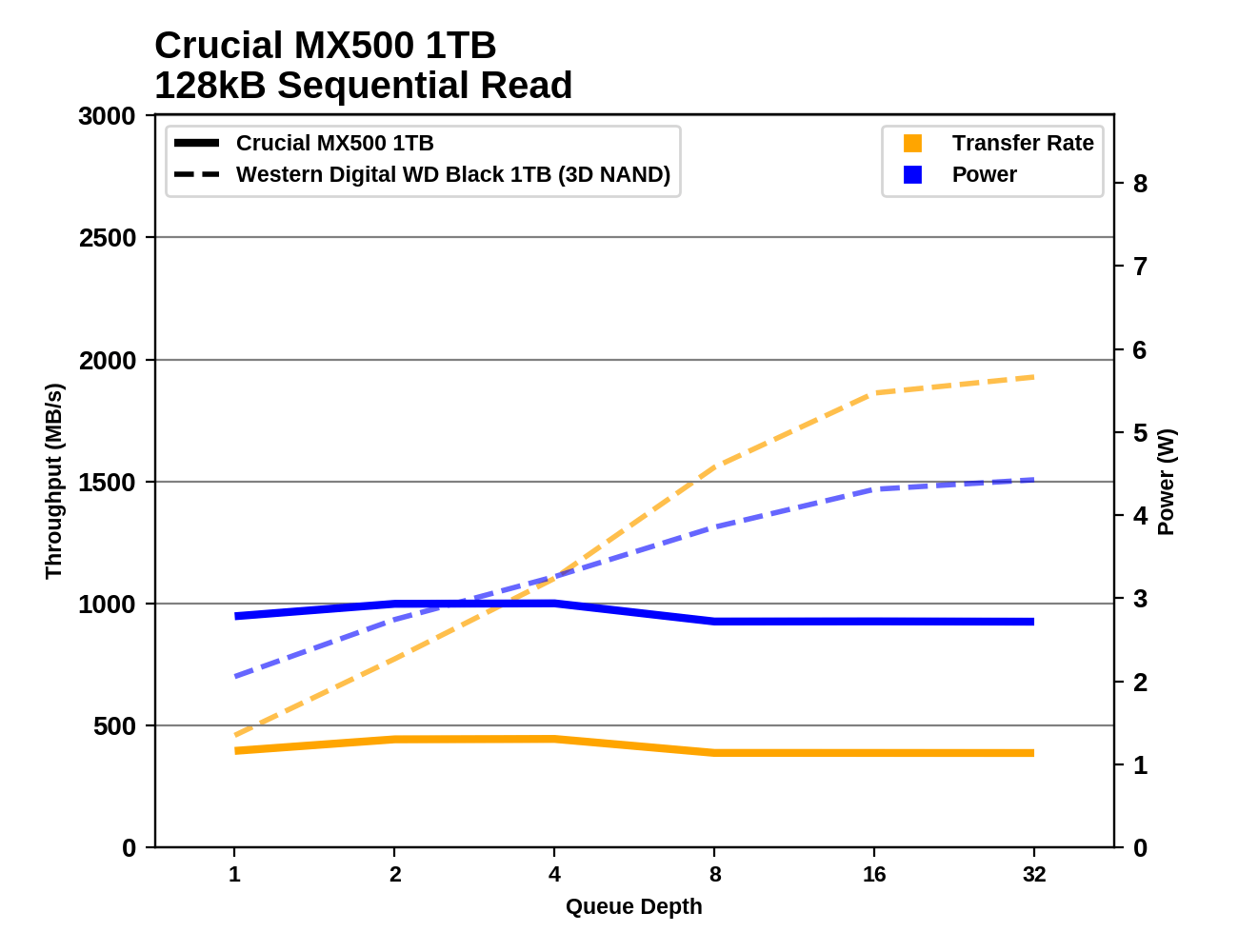
Crucial MX500 1TB
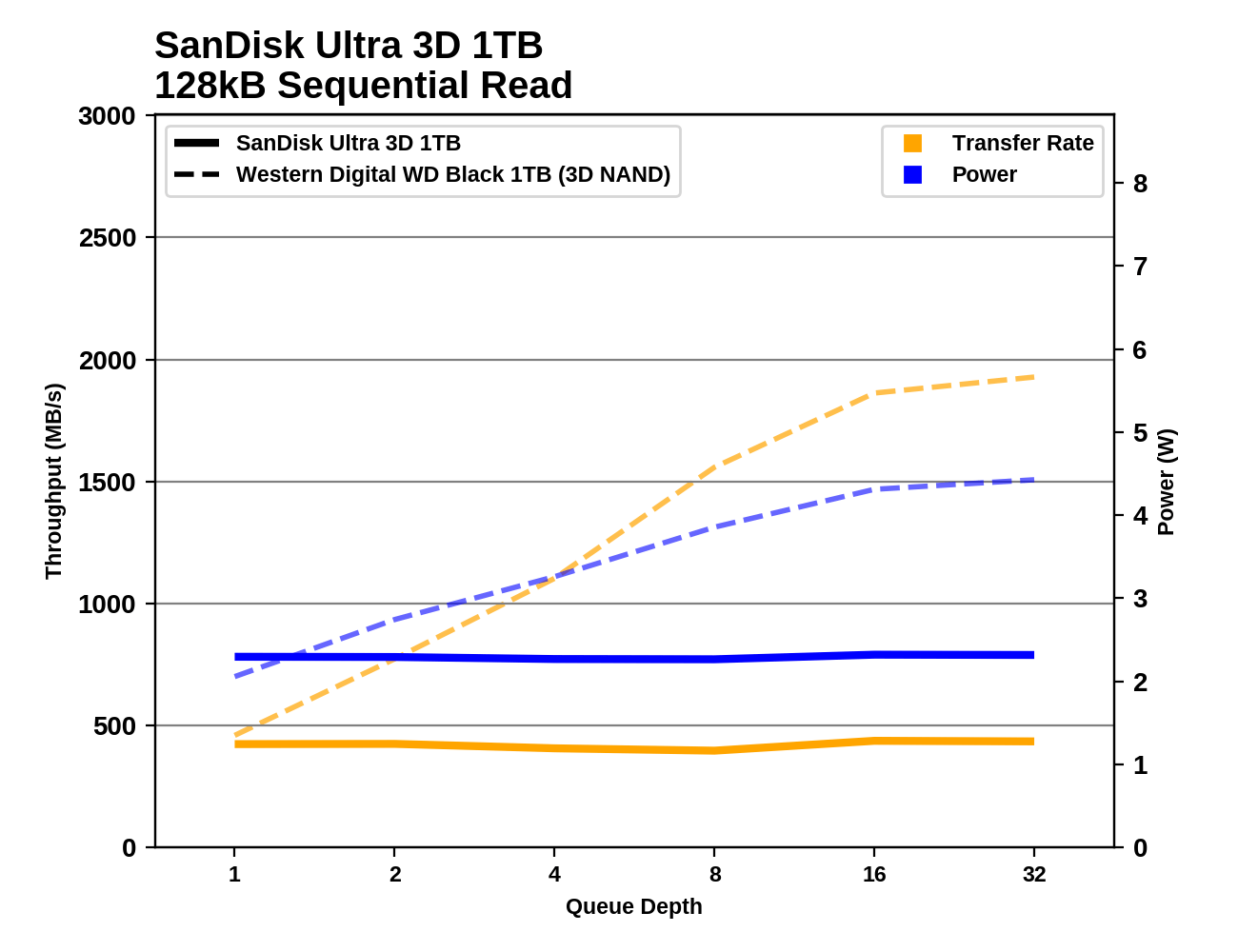
SanDisc Ultra 3D 1TB
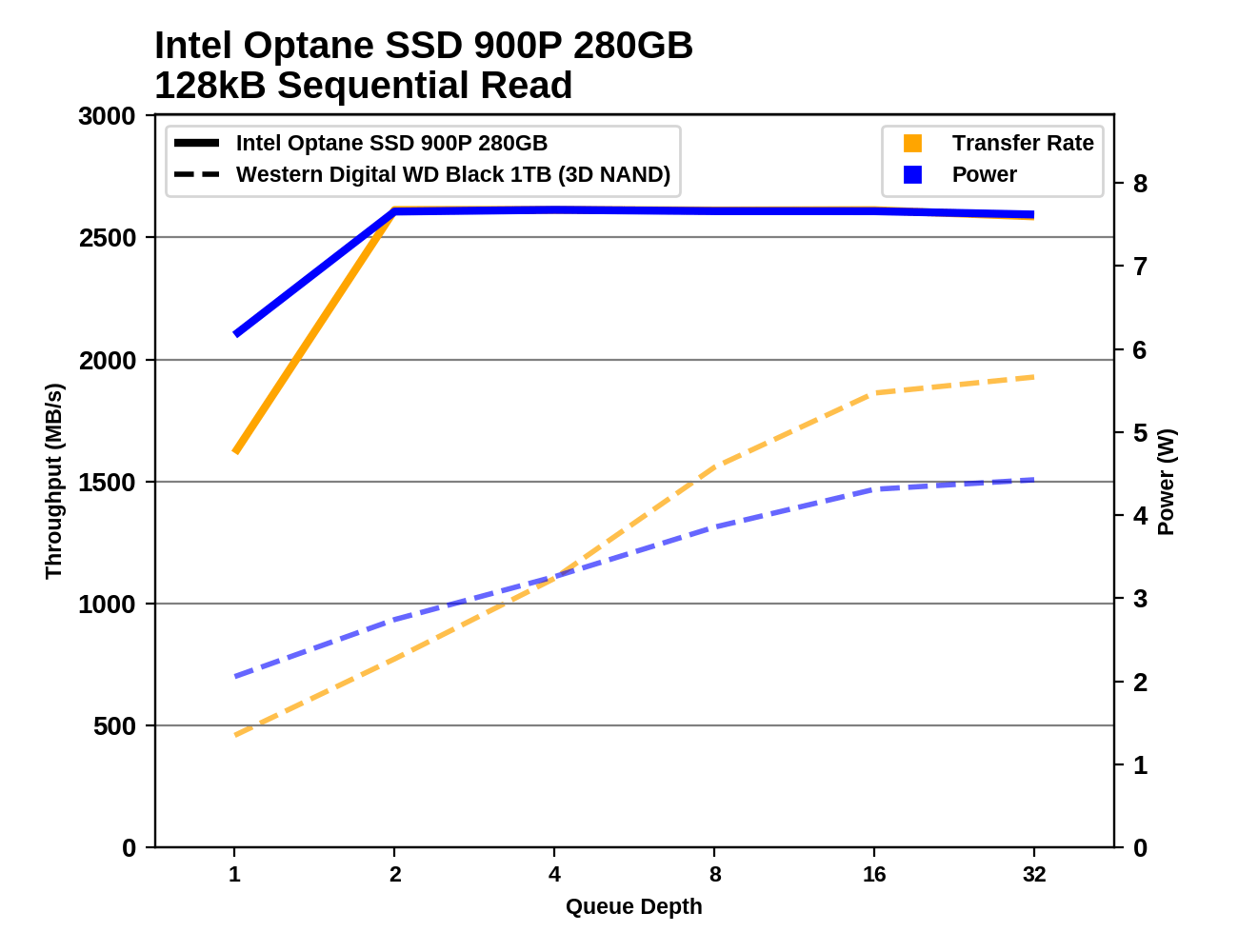
Intel Optane 900P 280GB
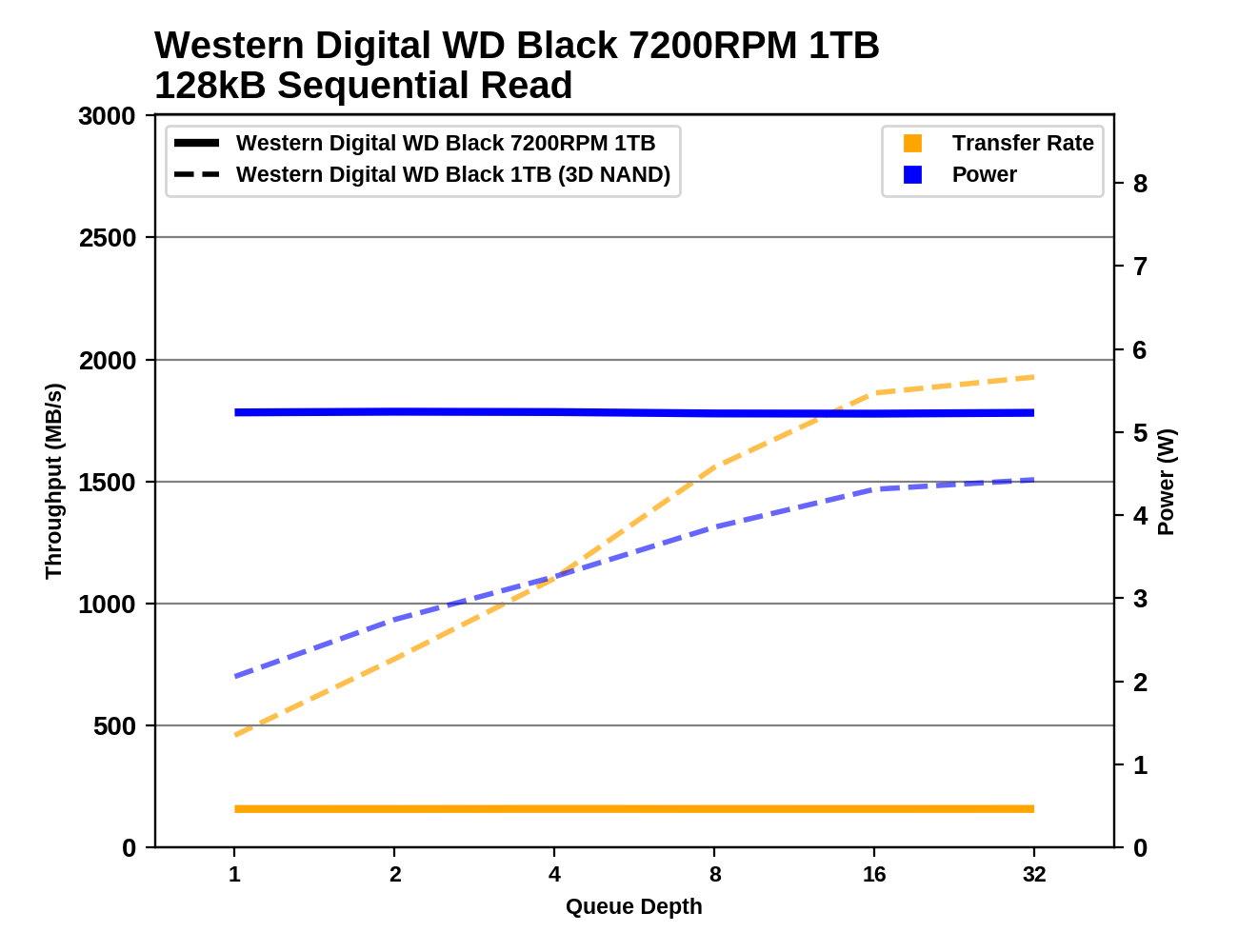
Western Digital WD Black 7200RPM 1TB
The performance of sequential reading of WD Black starts very mediocre in QD1, but is steadily increasing up to QD16, here it surpasses everyone except the Optane SSD. Toshiba XG5 shows similar scaling behavior, but cannot compete with the new WD Black.
Sequential write performance
The performance test of sequential data writing is similar to the previous one - the sequential read test. Each packet writes 128 MB of data in the form of 128 KB operations, released in QD1, for a total of 1 GB of data recorded on a disc containing 16 GB of data.
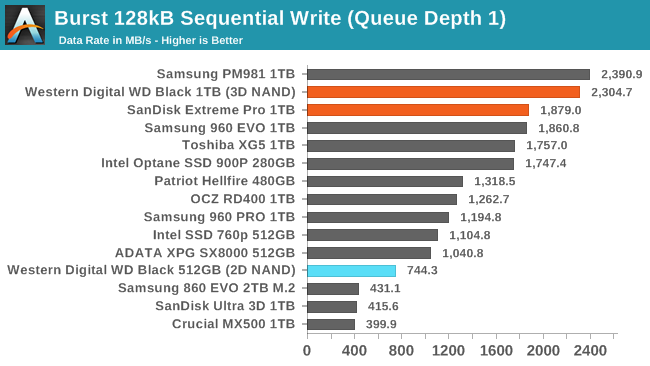
As in the case of the random write test, our twin disks show a surprising difference in speeds during sequential recording. WD SanDisk Extreme shares second place with the Samsung 960 EVO, while WD Black is on a par with the Samsung PM981 (which replaced the 960 Evo, the increase in write speed compared to the SSD 960 Evo is about 40%).
The long sequential write test is structured identically to a sequential read test, except for the direction of data transfer. The queue depth varies from 1 to 32, and each depth is checked for one minute or 32 GB, after which a minute of idle time set aside for correct development of the garbage collection technology comes, such a break allows the drive to cool down. The test is limited to the 64-gigabyte range of the drive.
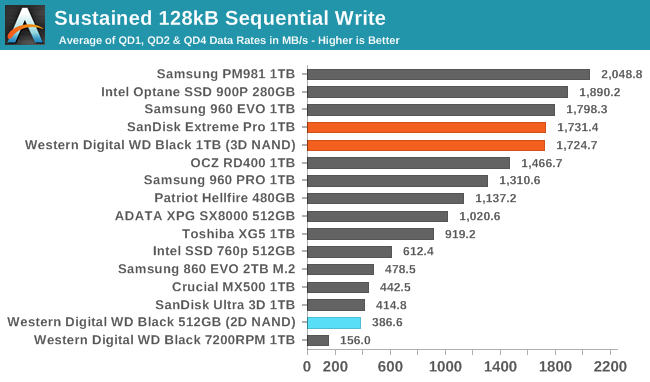
The performance of WD Black's continuous sequential recording is not in the first place, but it is far ahead of everything except the best drives from Samsung and Intel. WD Black is almost two times faster than the Toshiba XG5, which uses essentially the same flash.
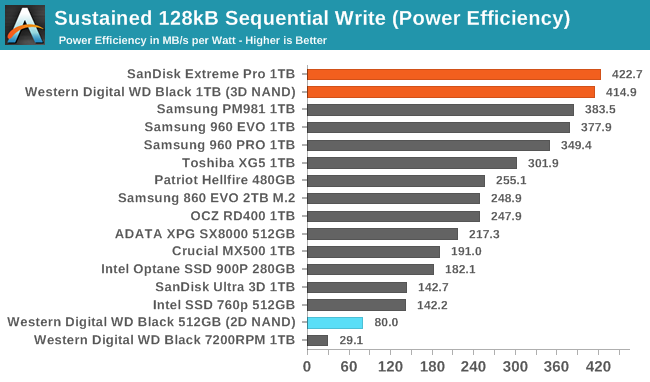
Despite the fact that the tested product did not show top performance when testing sequential recording, WD Black is a clear winner in terms of energy efficiency. With a power consumption of just over 4 watts, it does not suffer from a lack of power at all. So much work has been done in this direction that the drive was able to outperform all competitors in efficiency testing.
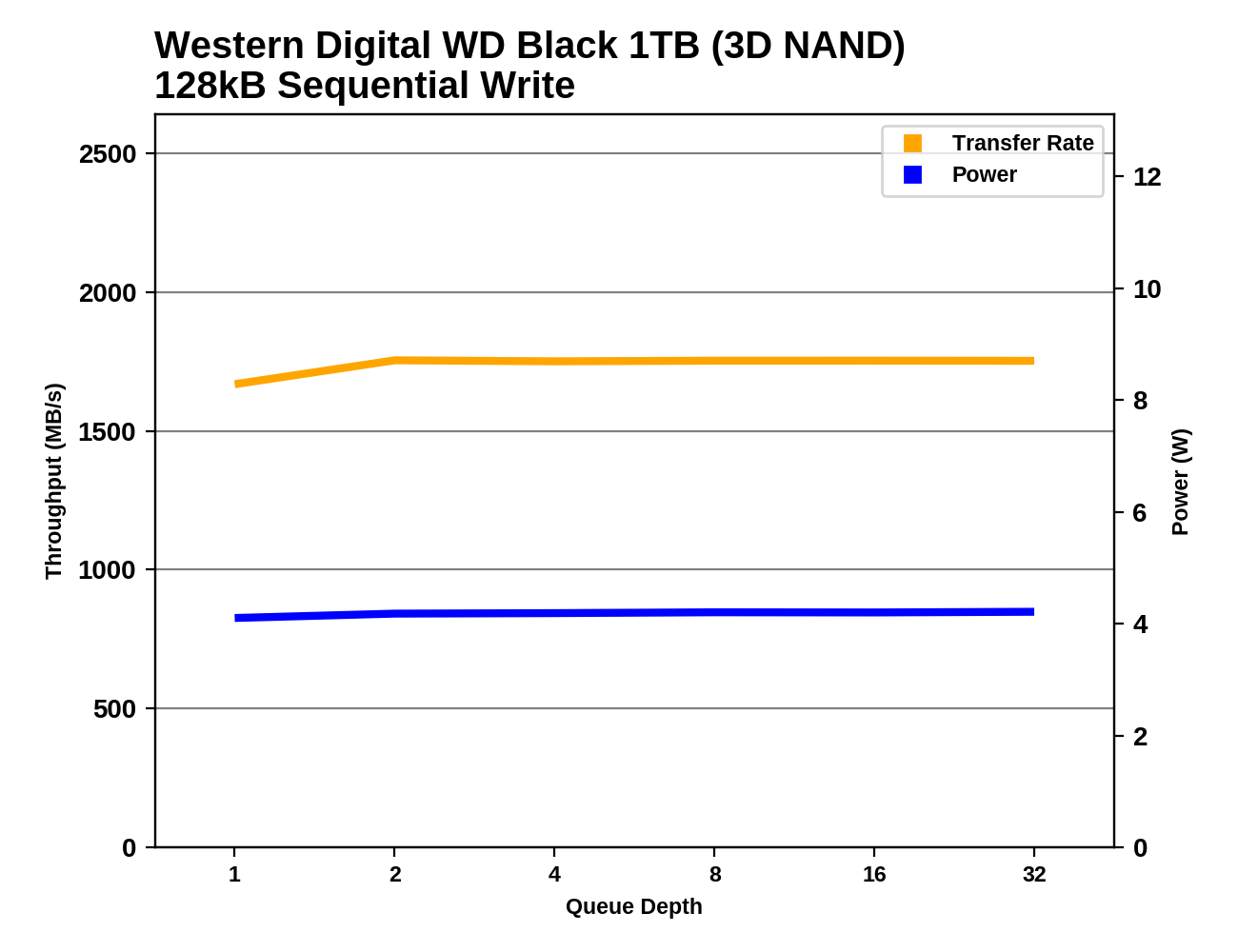
Western the Digital the WD Black 1TB (3D of NAND)

the Intel the SSD 760p 512GB
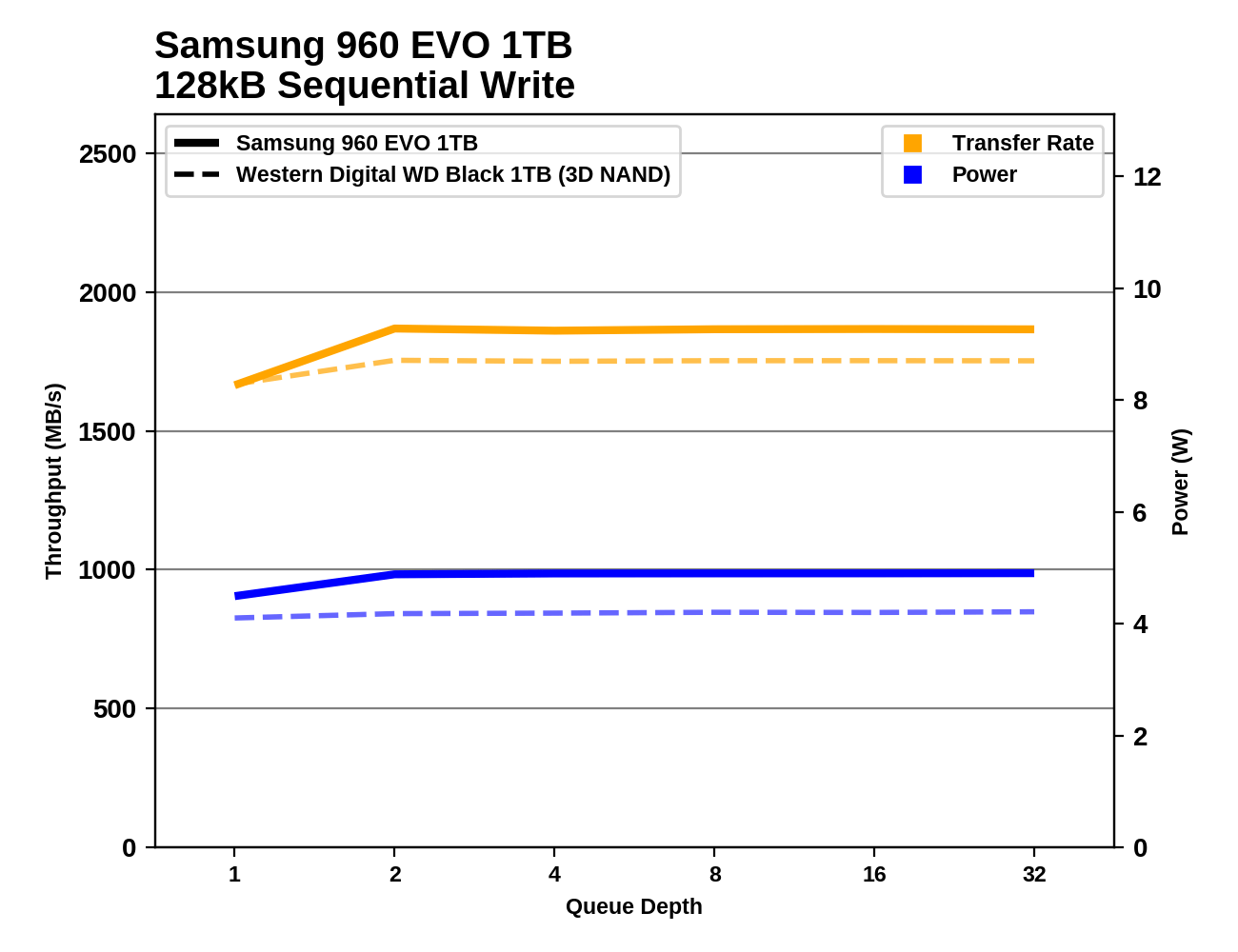
the Samsung 960 the EVO 1TB
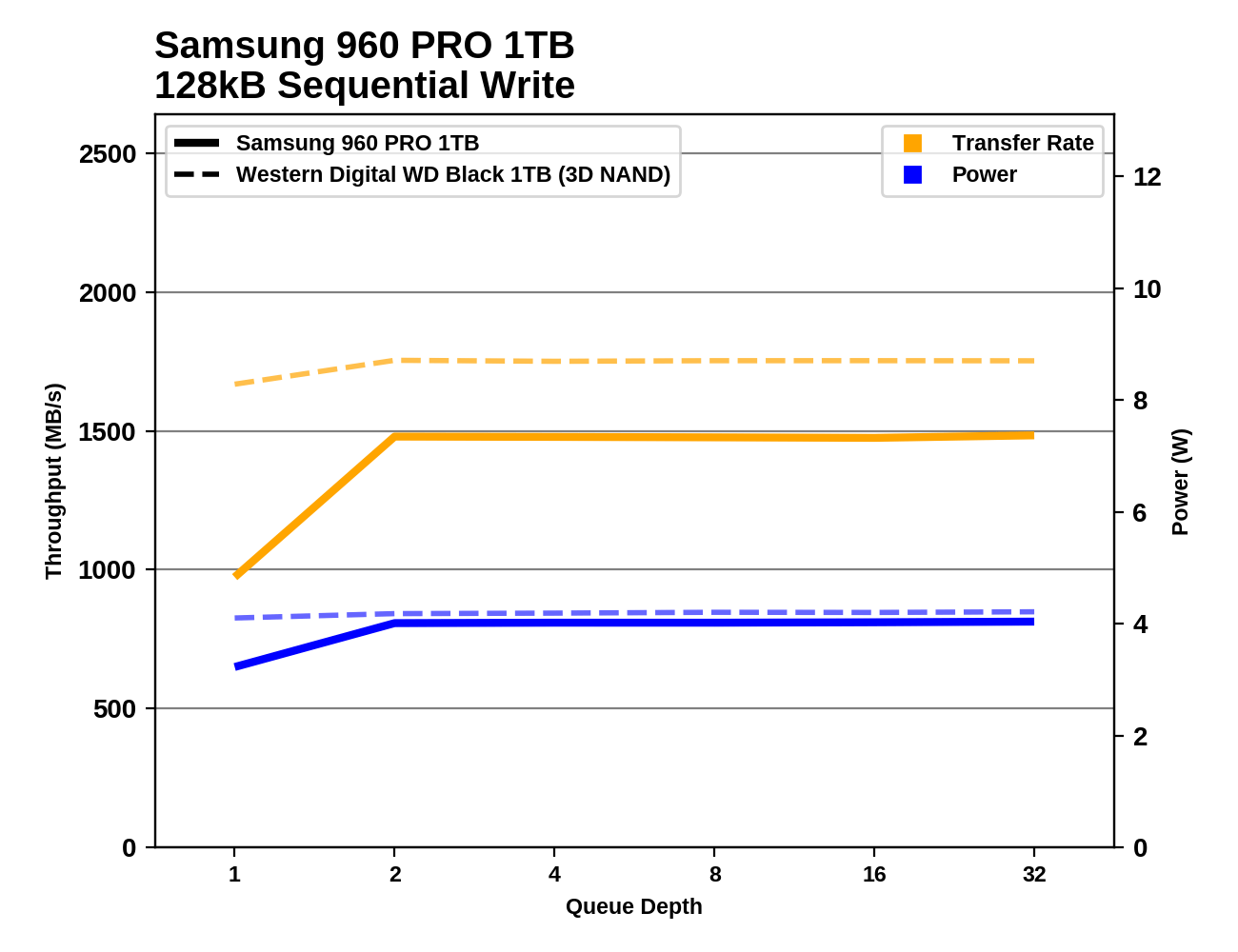
the Samsung 960 the PRO 1TB
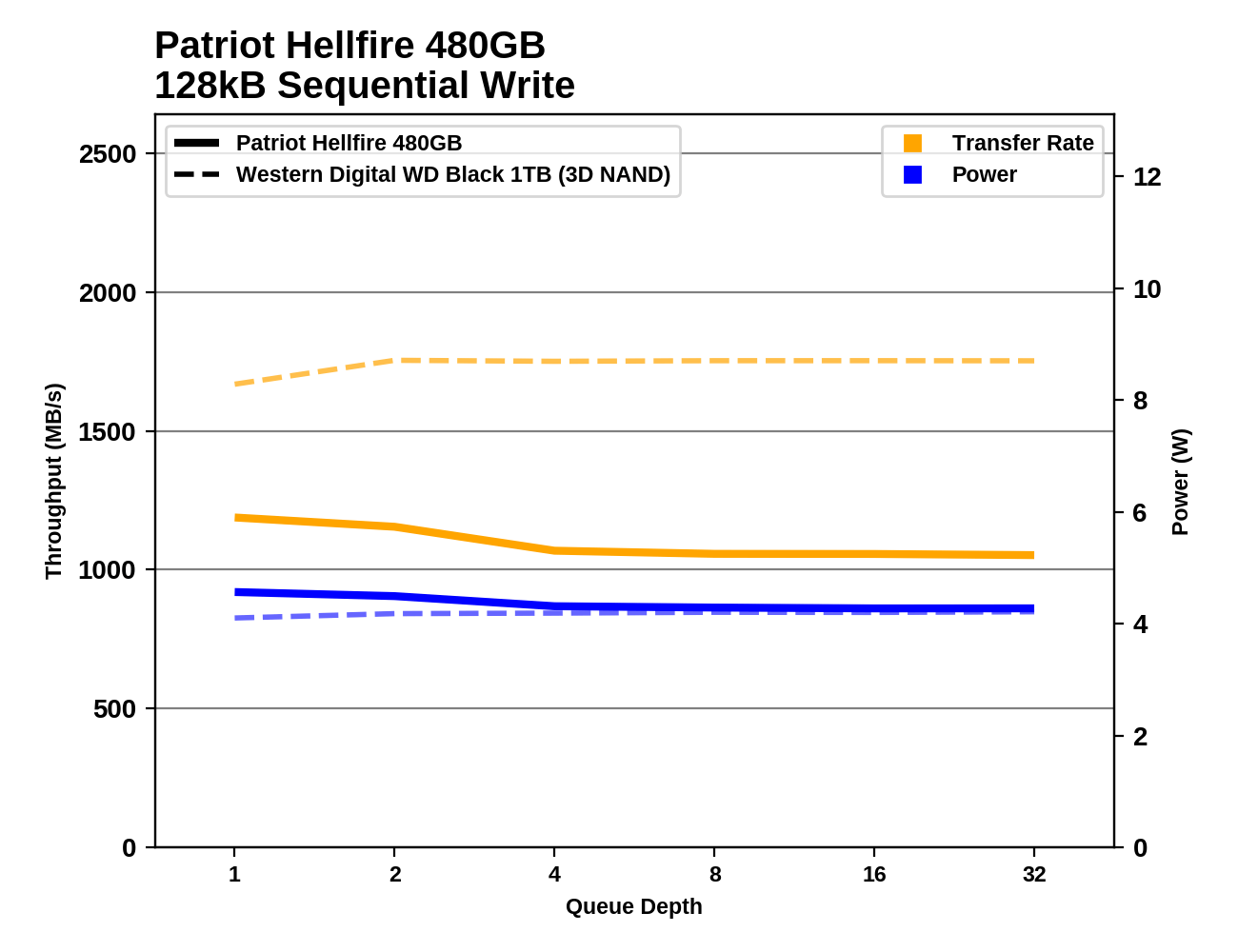
Patriot the Hellfire 480GB
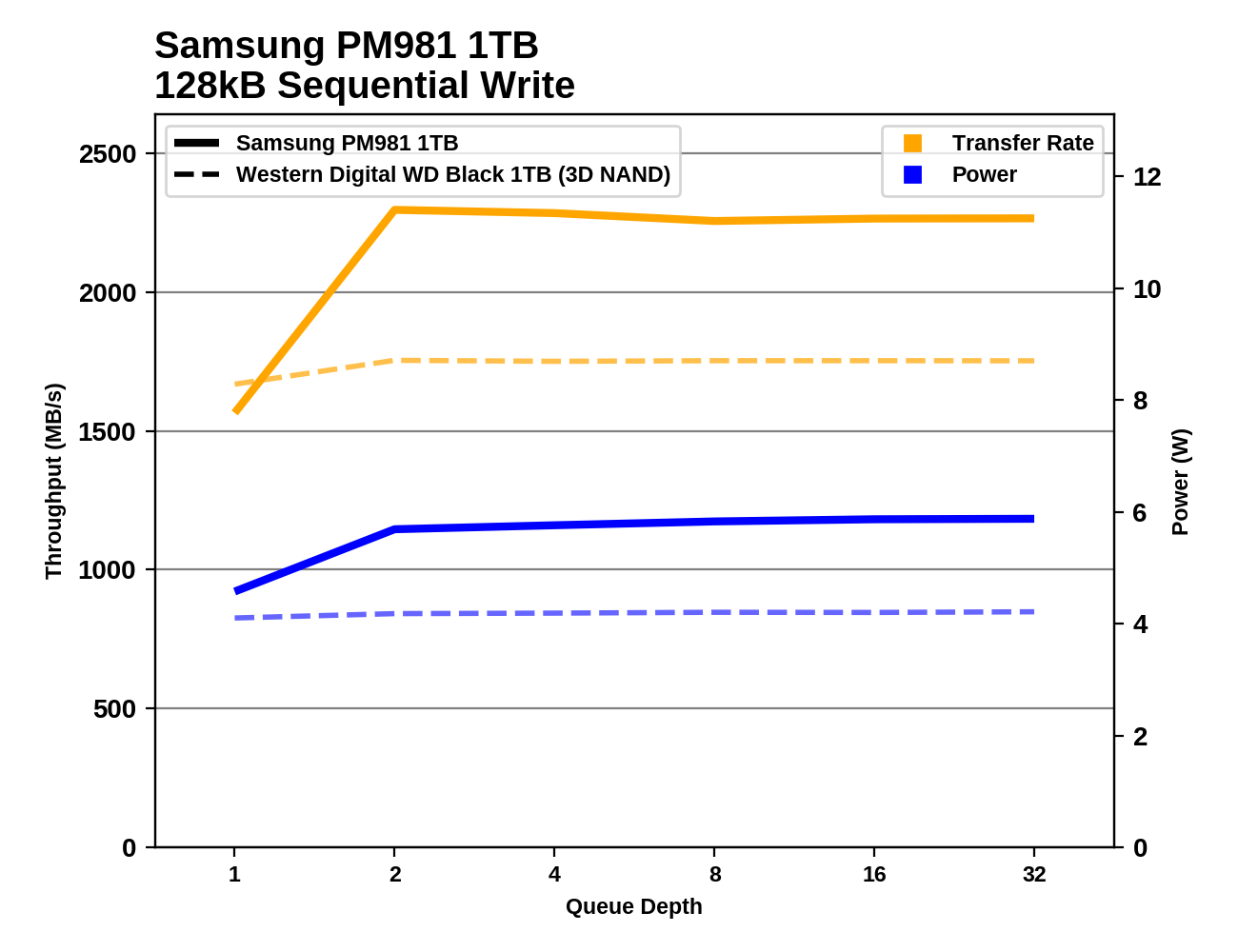
the Samsung PM981 1TB
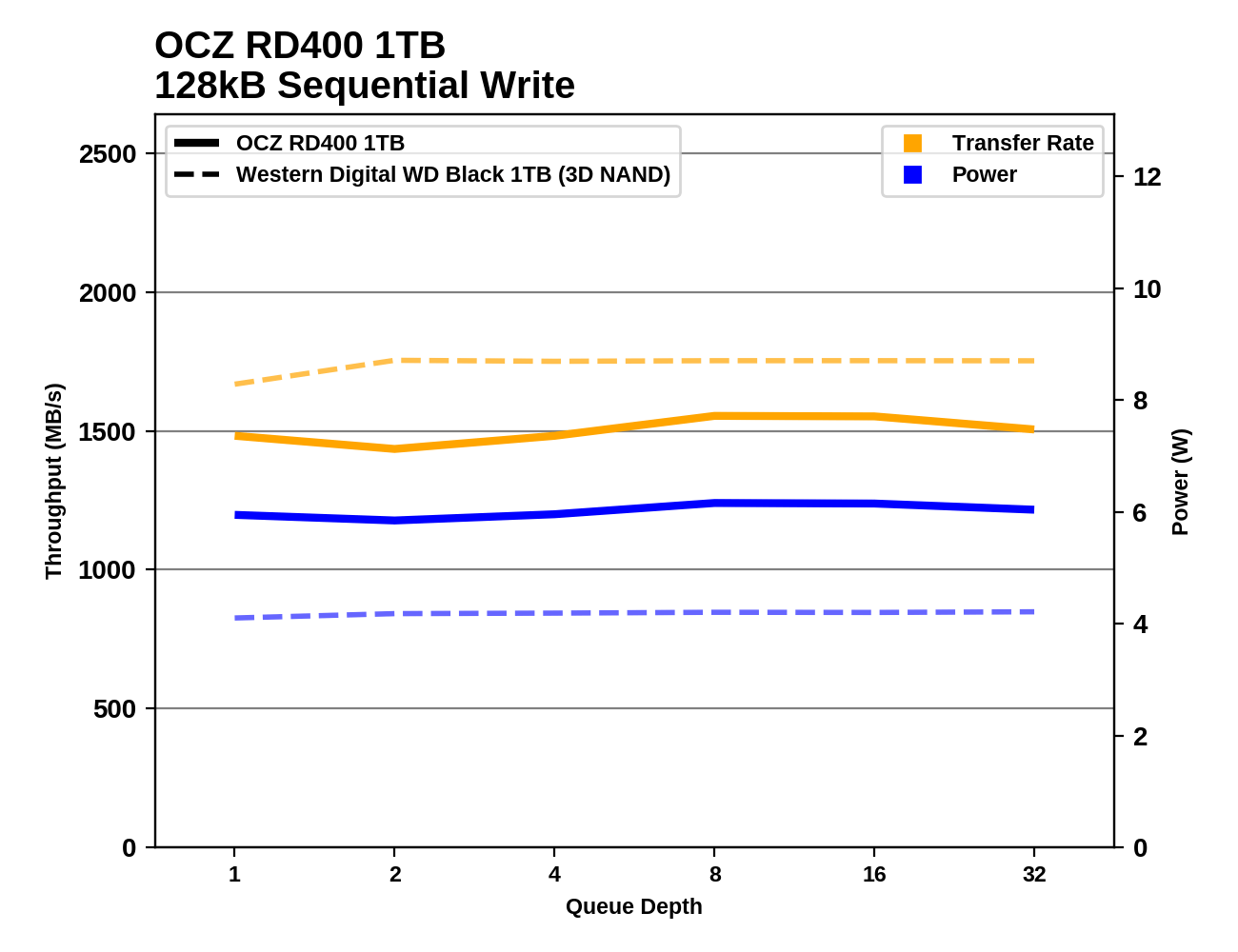
the OCZ RD 400 1TB
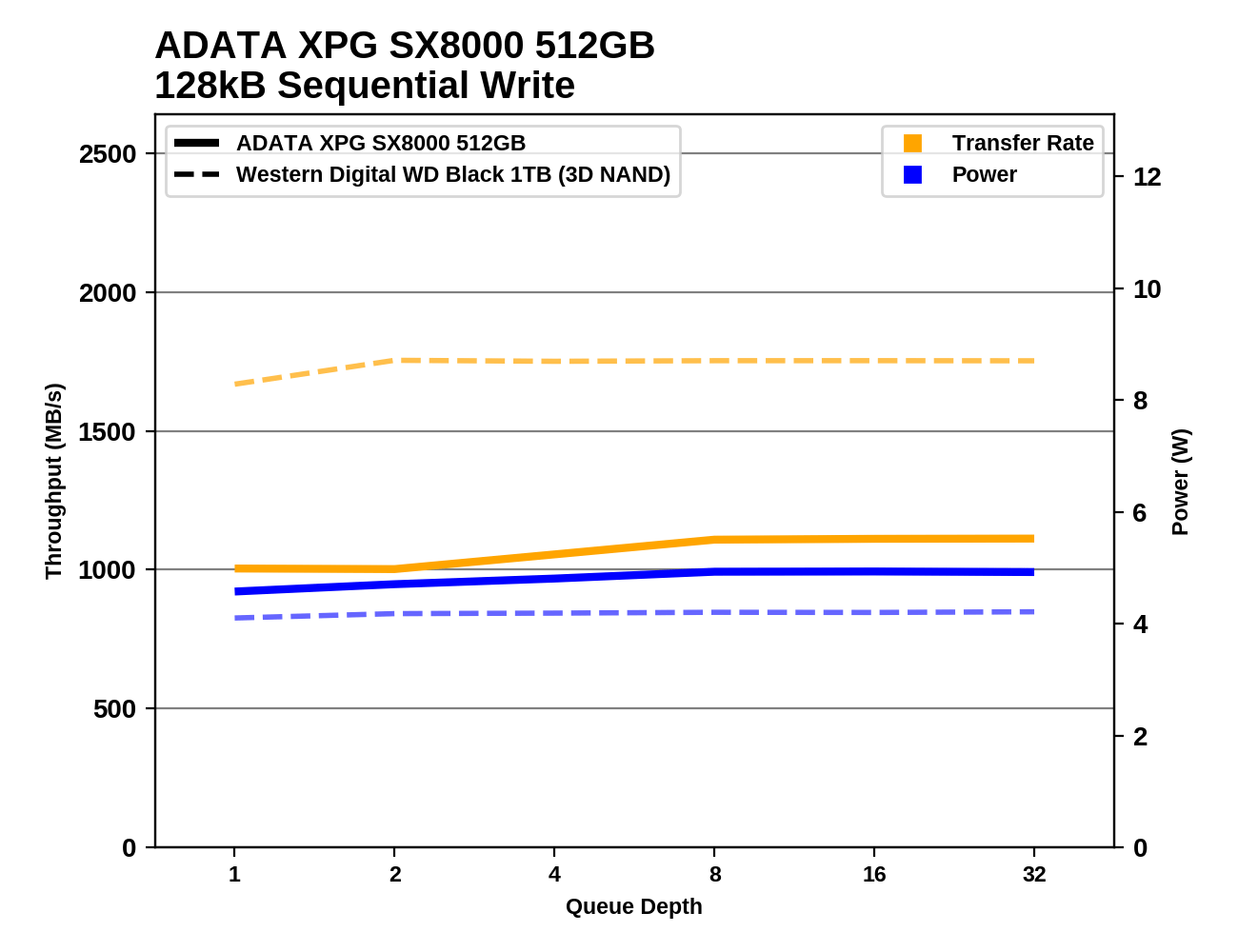
the ADATA XPG SX8000 512 GB
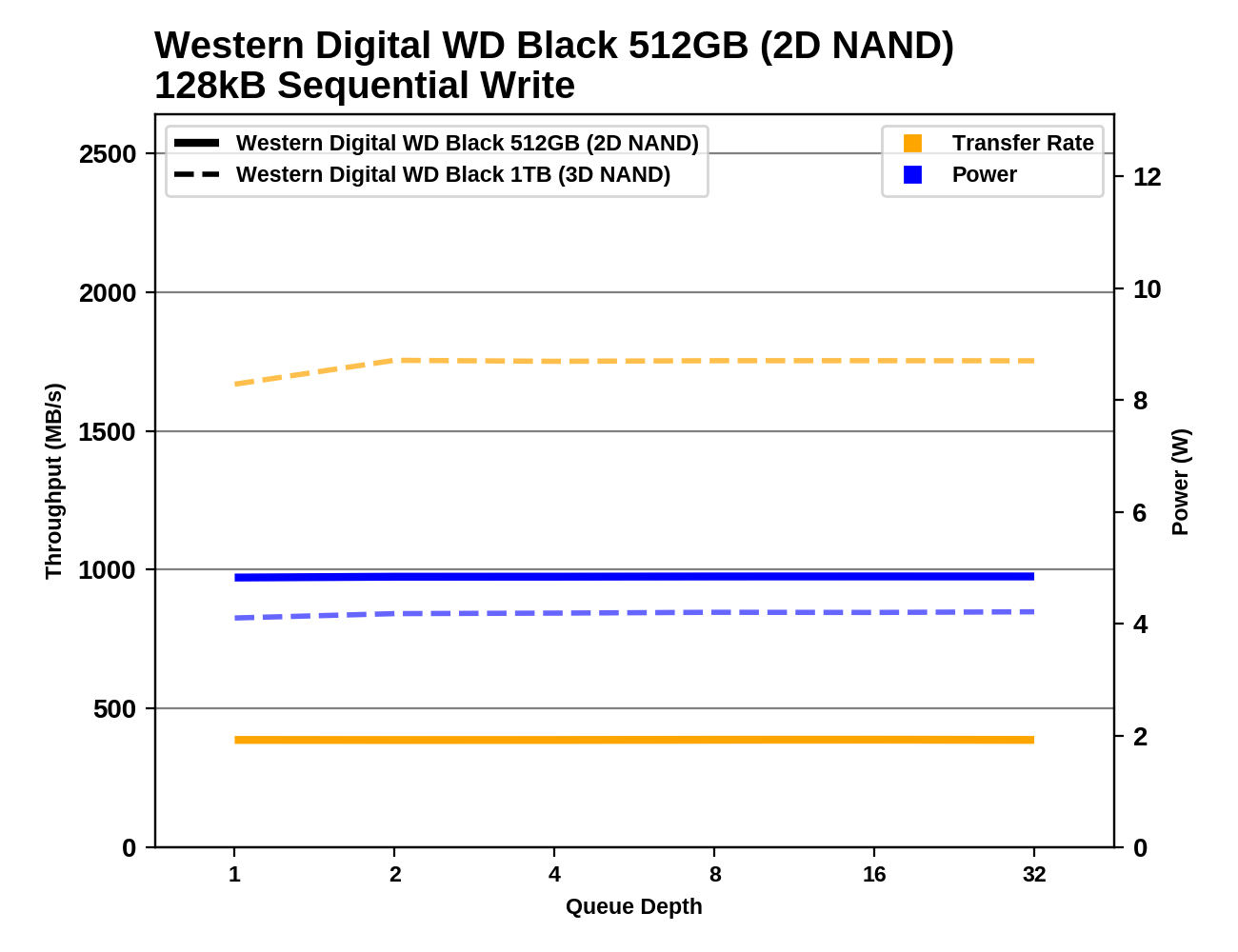
Western the Digital the WD Black 512GB (2D of NAND)
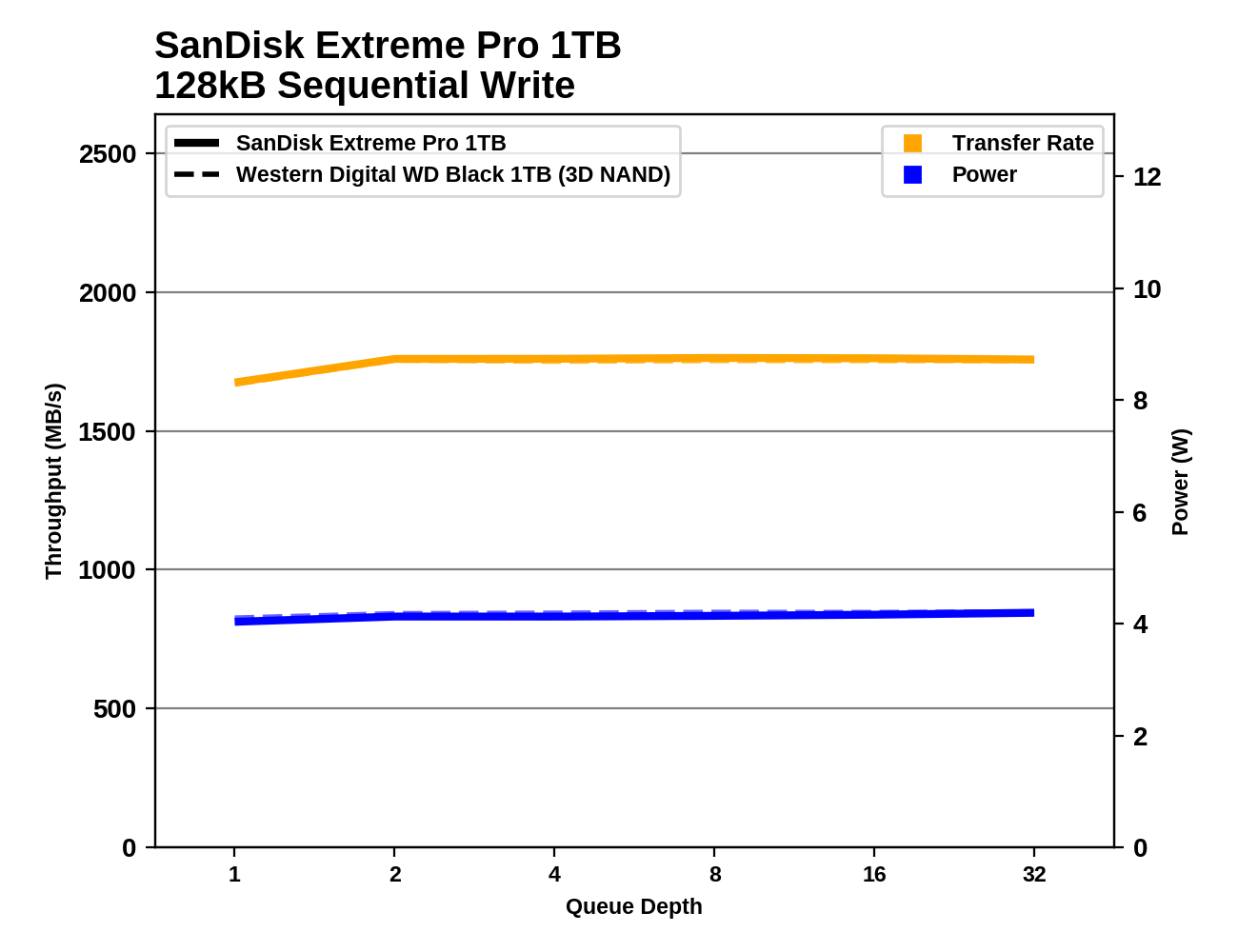
SanDisc Extreme the PRO 1TB
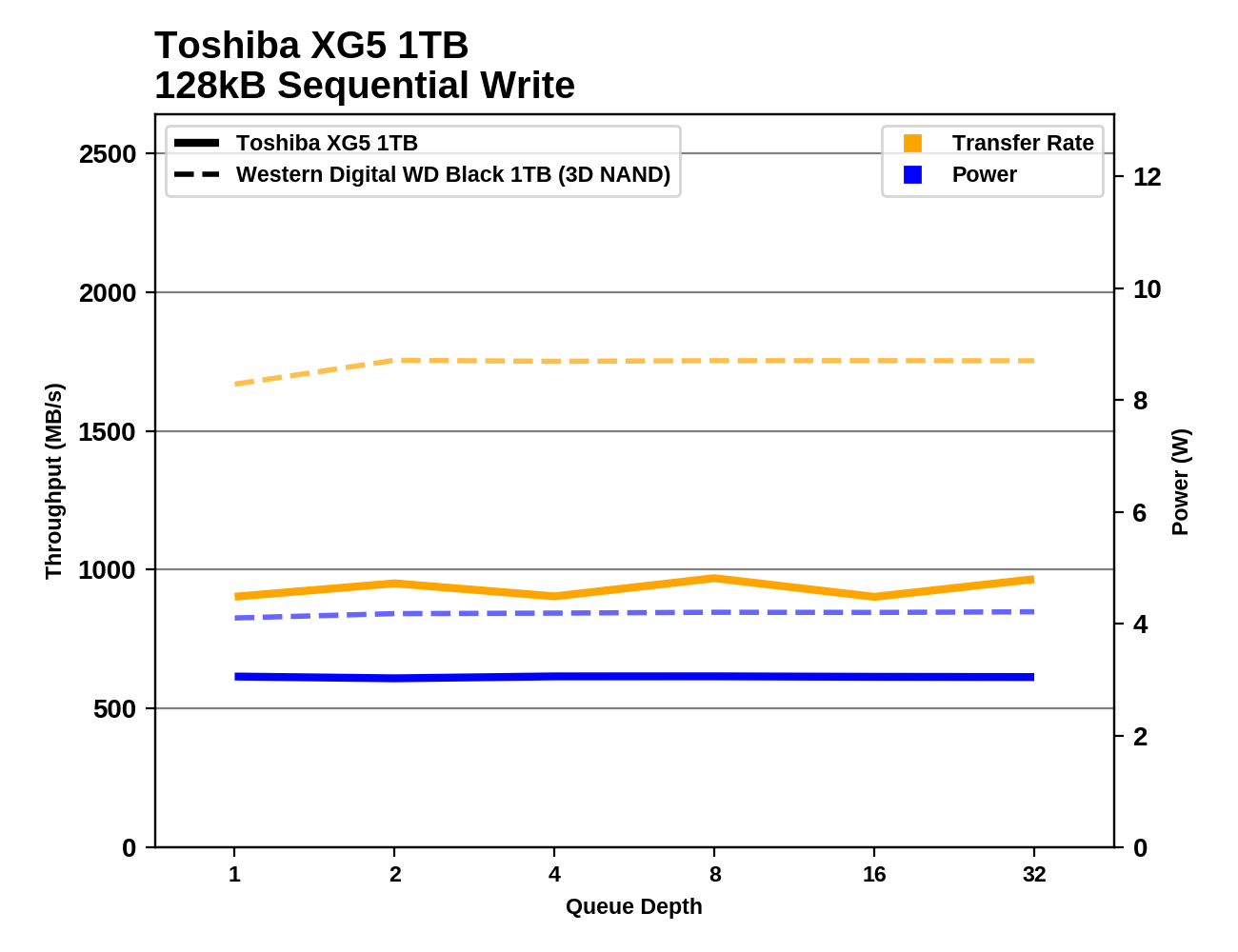
the Toshiba XG5 1TB
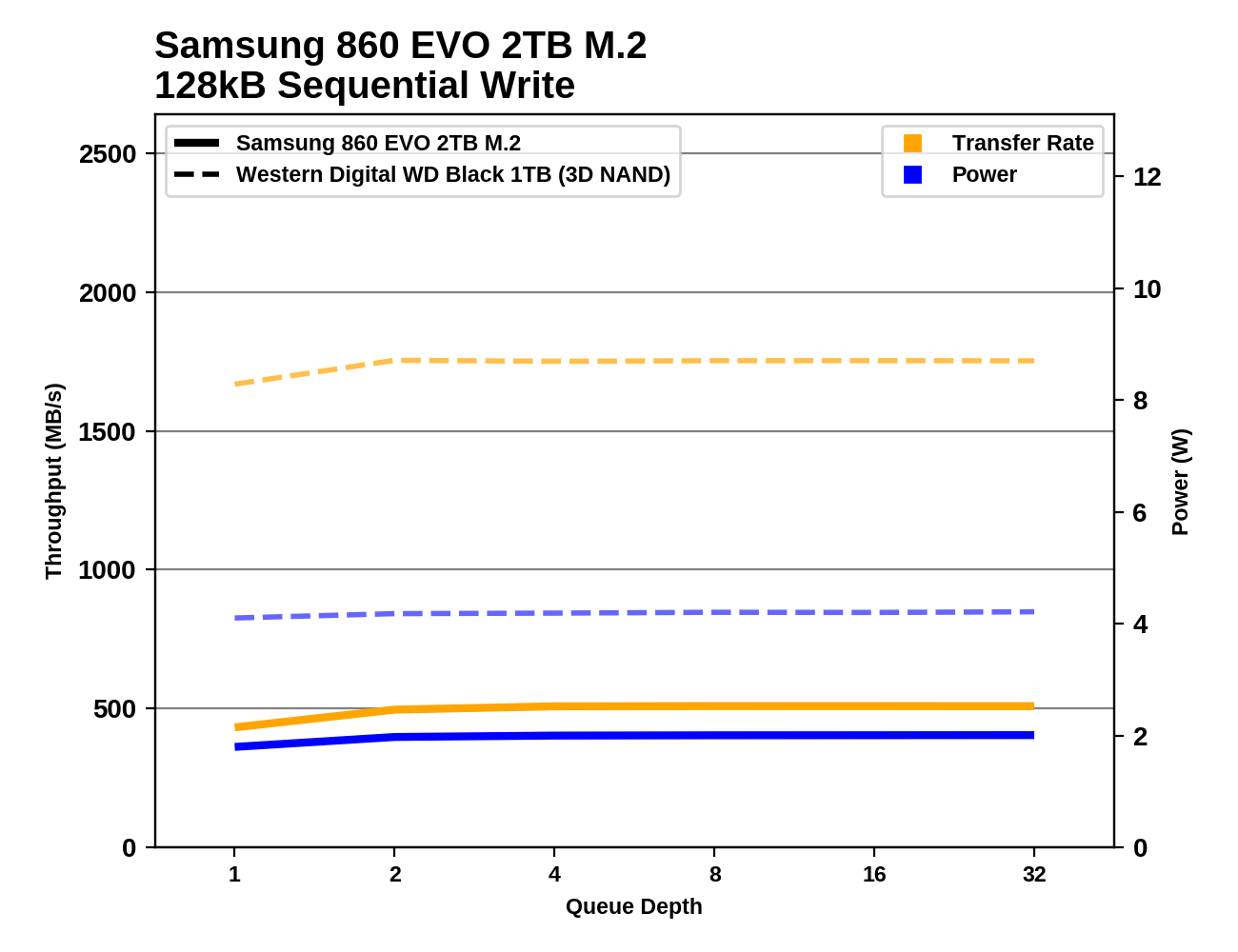
Samsung 860 EVO 2TB M.2
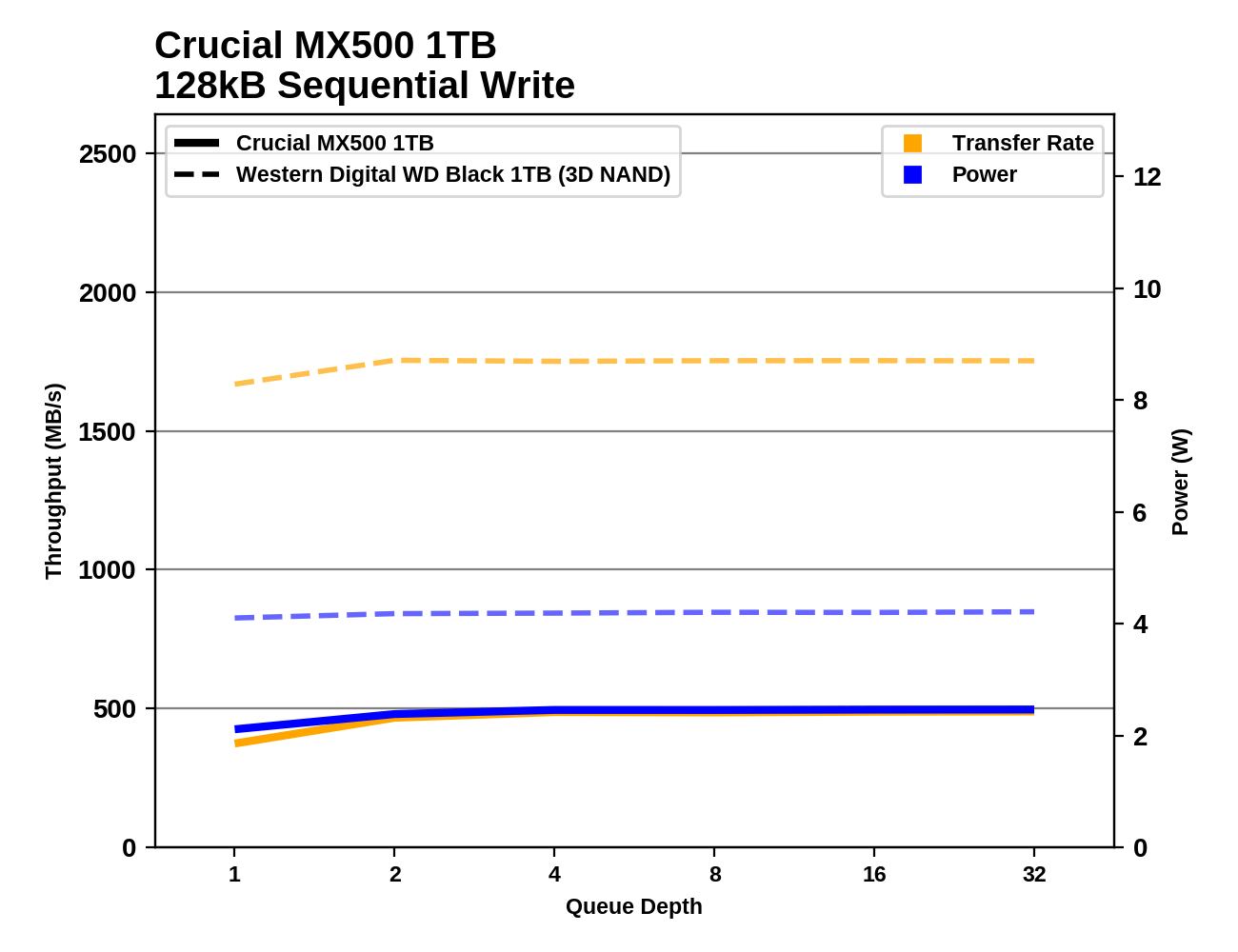
Crucial MX500 1TB
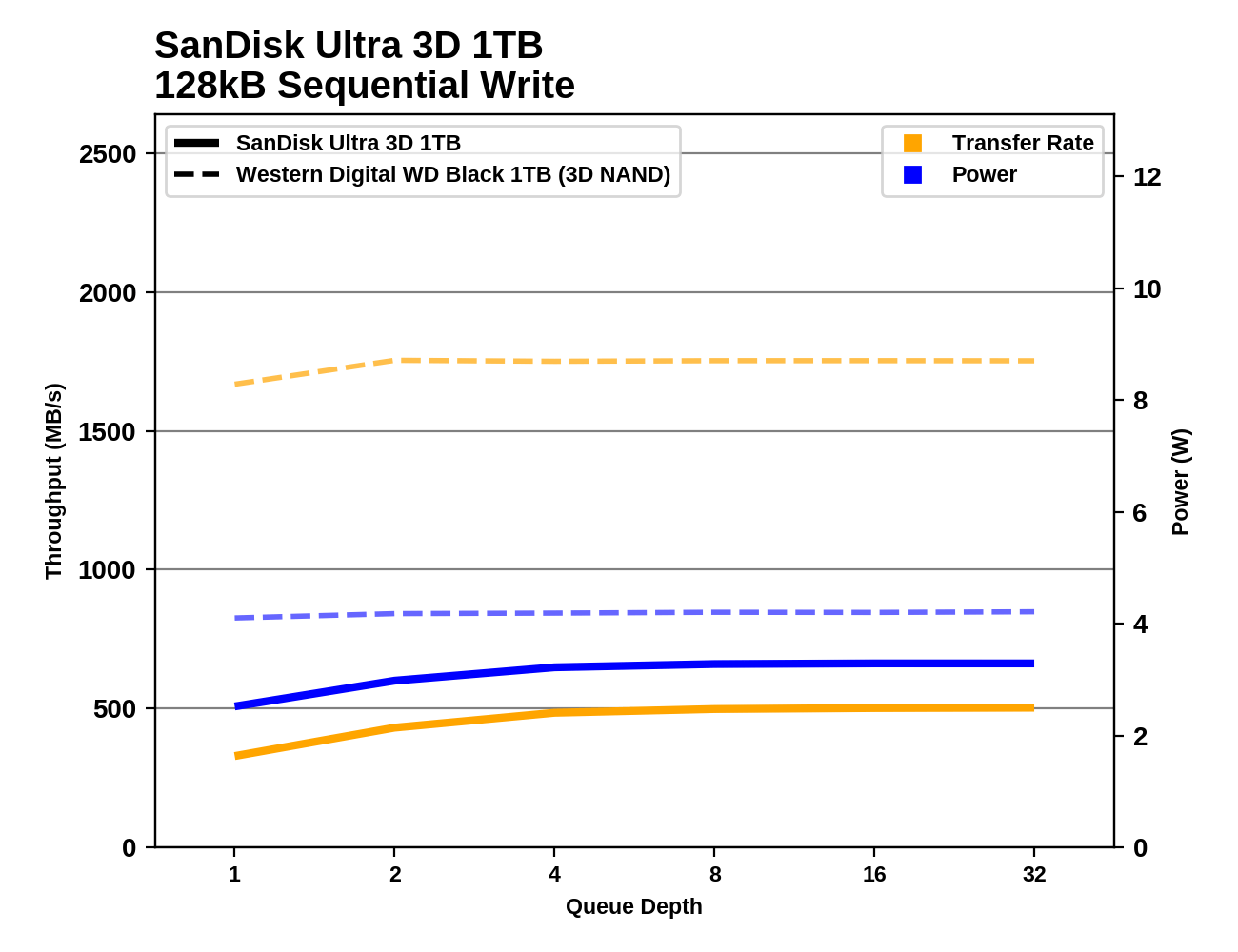
SanDisc Ultra 3D 1TB
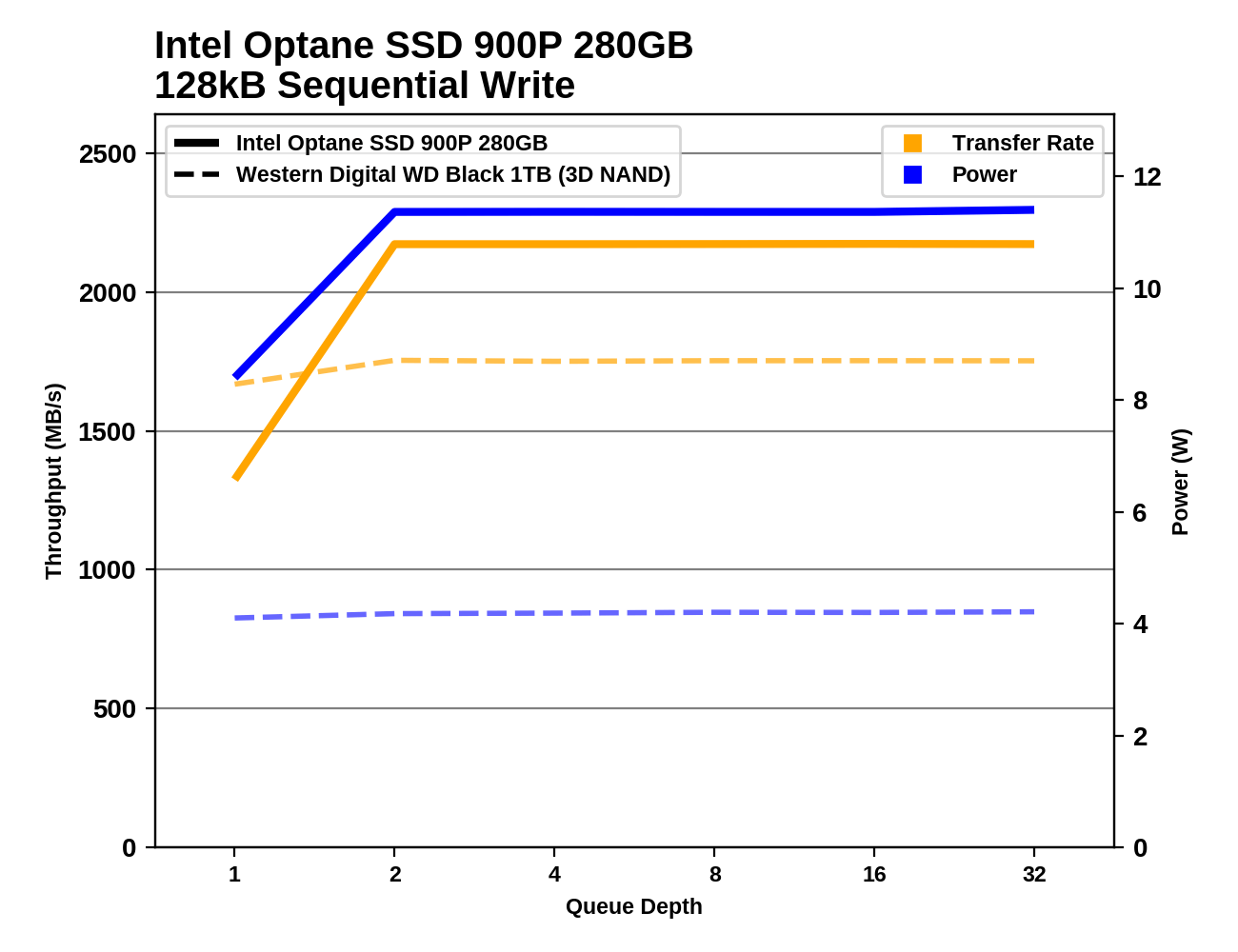
Intel Optane 900P 280GB
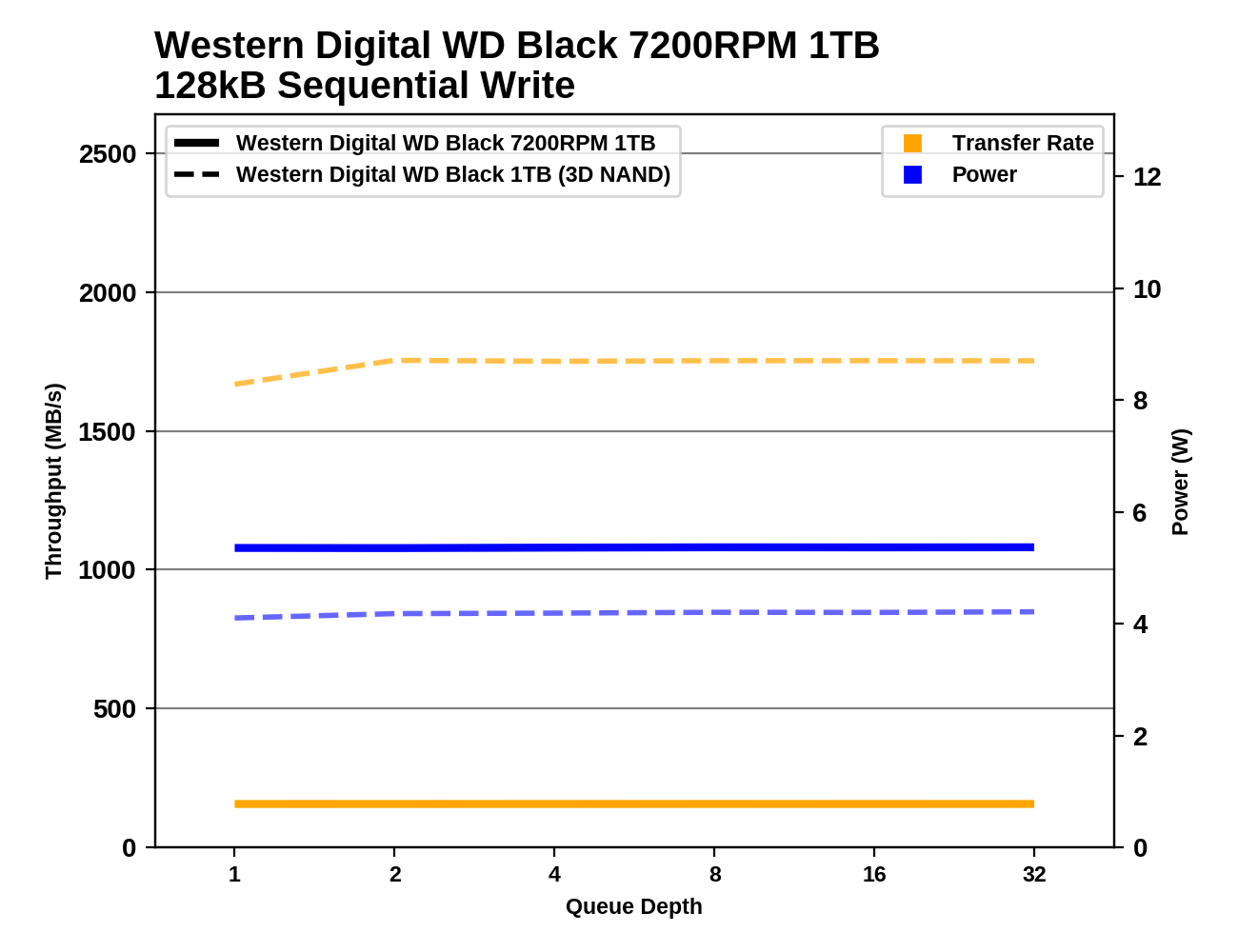
Western Digital WD Black 7200RPM 1TB WD Black's
sequential write speed is fairly stable over a wide range of queue depths and shows a slight increase from QD1 to QD2, with no signs of deterioration due to excessive garbage collection after filling SLC cache.
Mixed random performance
The test of mixed random reads and records consists of mixes that range from pure reading to pure writing in 10% increments. Each mix is tested up to 1 minute, or 32 GB of transferred data. Testing is conducted with a queue depth of 4 and is limited to the 64-gigabyte range of the drive. Between mixes, the drive is idle for up to one minute, so that the total duty cycle is 50%.
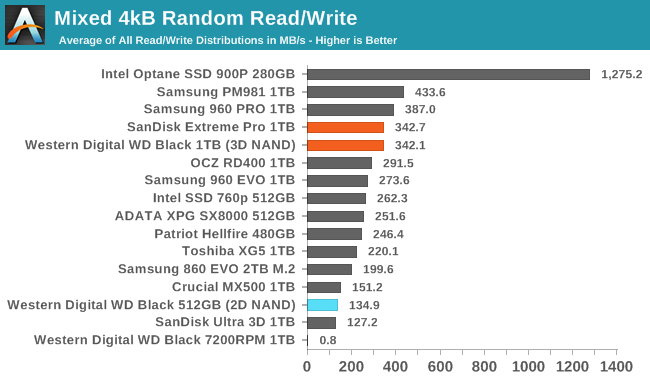
WD Black showed excellent performance with mixed random I / O, but it is still slower than the best drives from Samsung, but the Optane SSD is in a completely different league.
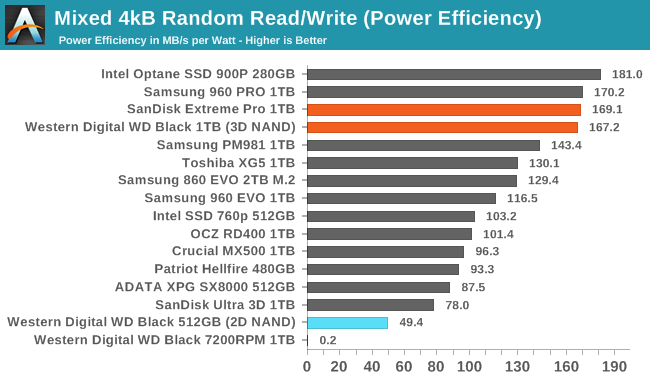
The WD Black's power efficiency with mixed random I / O testing is approximately equal to the Samsung 960 PRO, and is slightly inferior to the Optane SSD, despite the huge difference in the absolute level of performance.
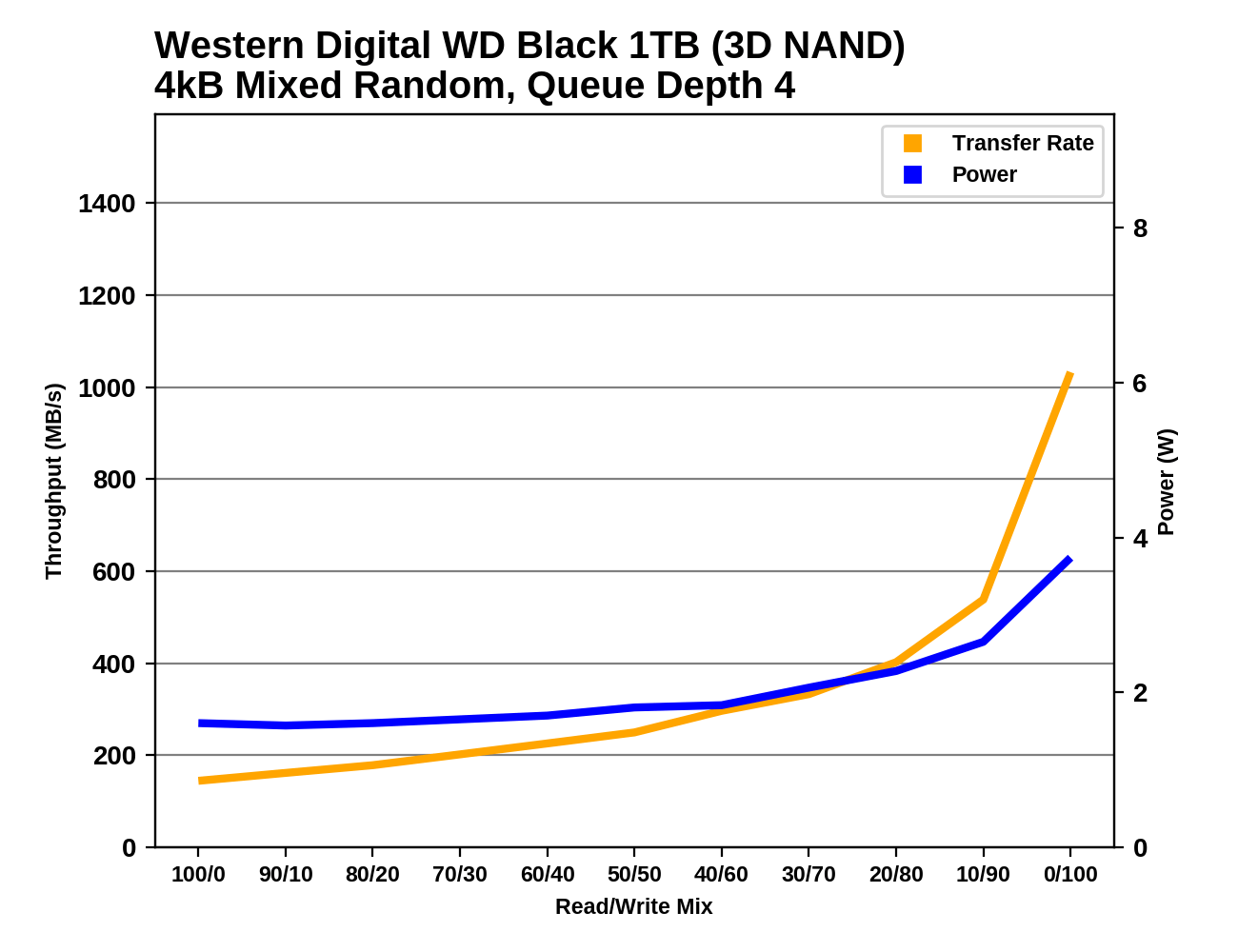
Western the Digital the WD Black 1TB (3D of NAND)
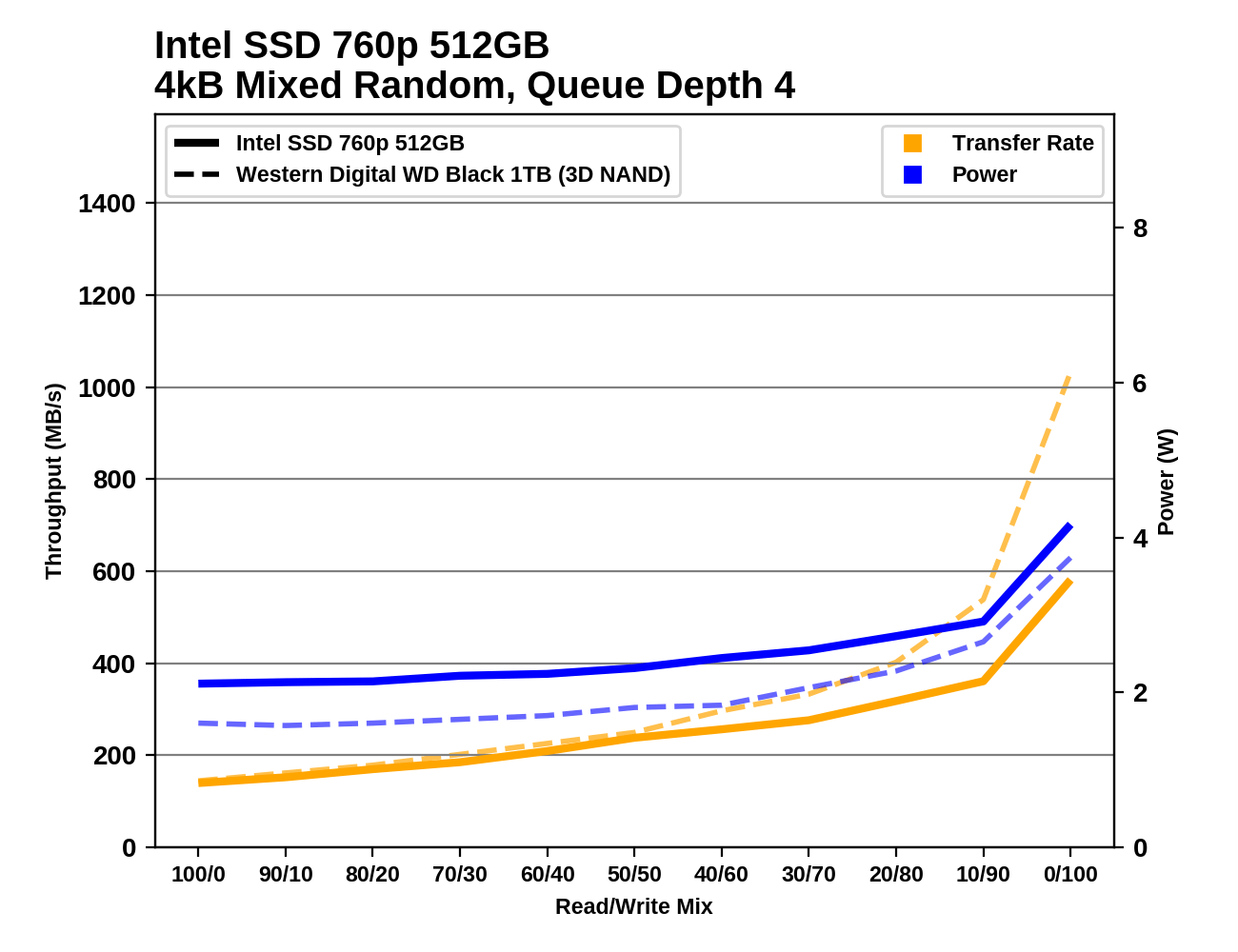
the Intel the SSD 760p 512GB

the Samsung 960 the EVO 1TB
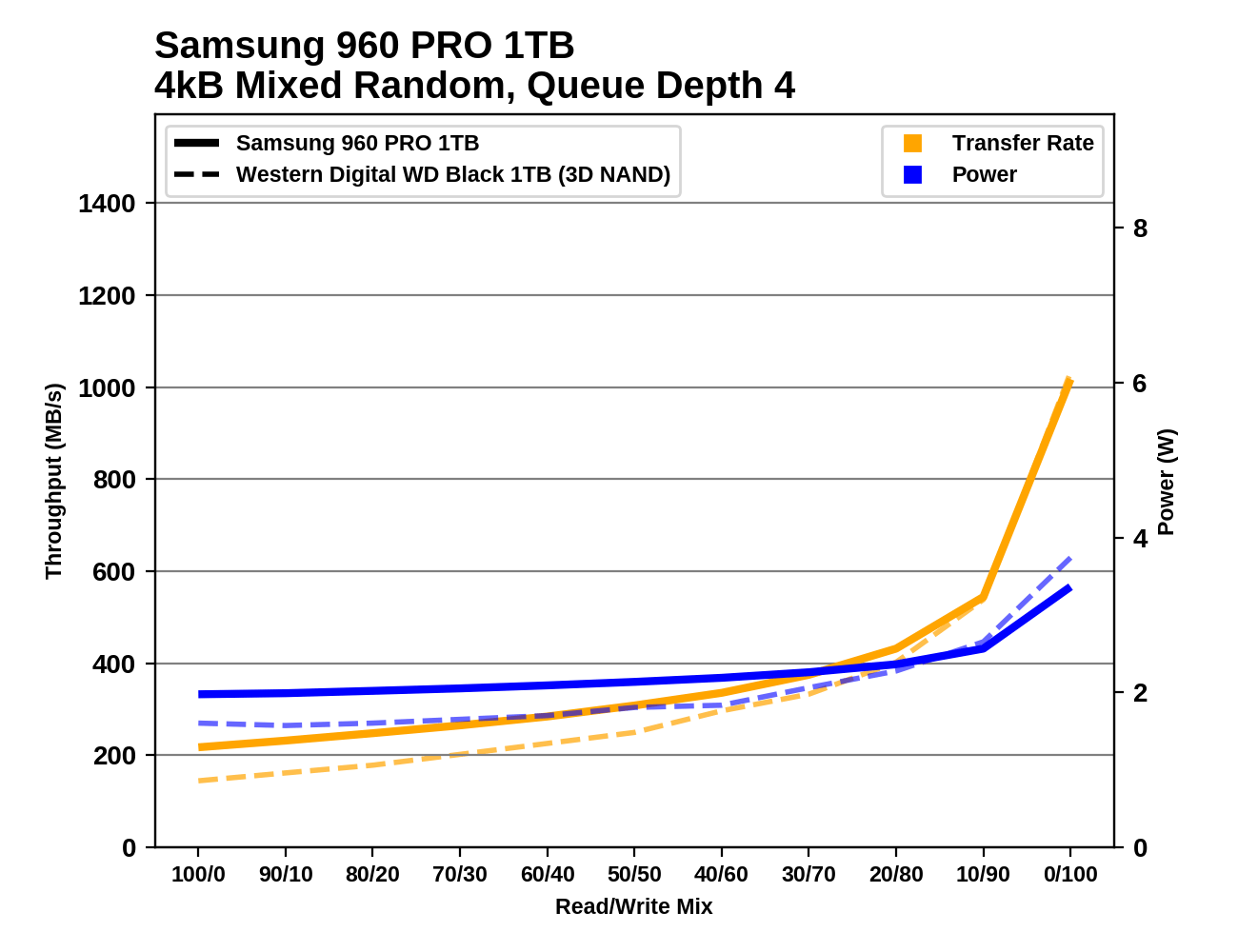
the Samsung 960 the PRO 1TB
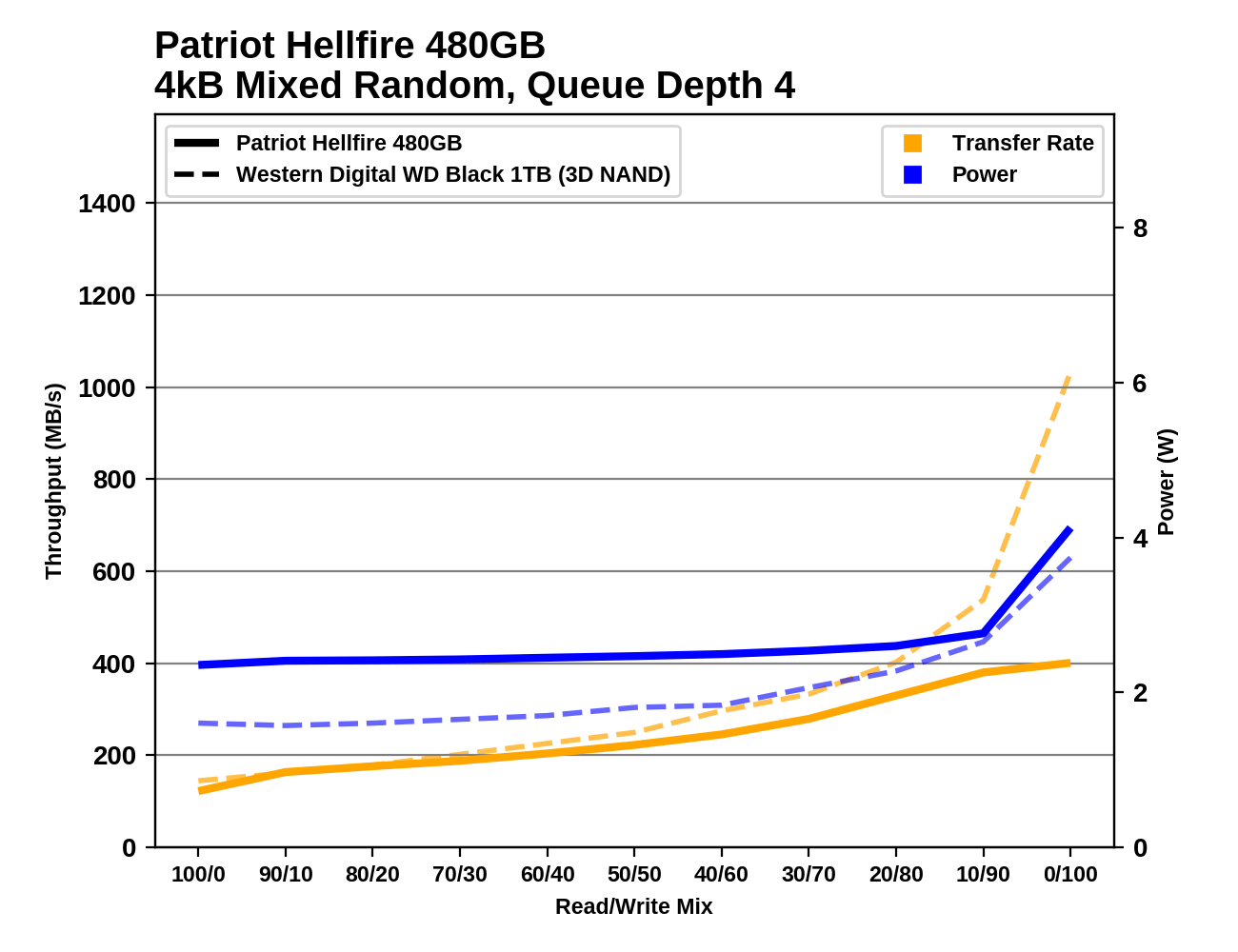
Patriot the Hellfire 480GB
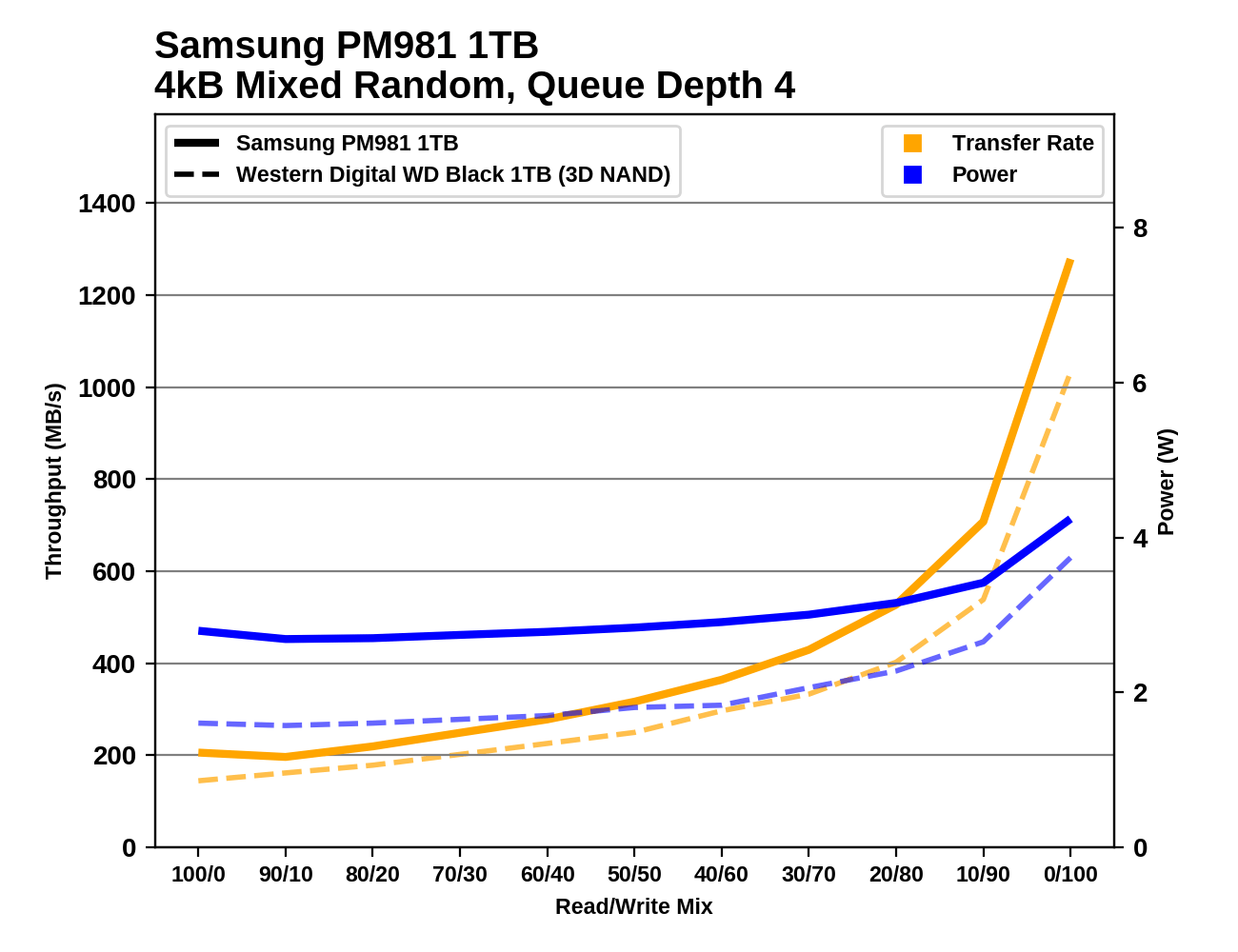
the Samsung PM981 1TB
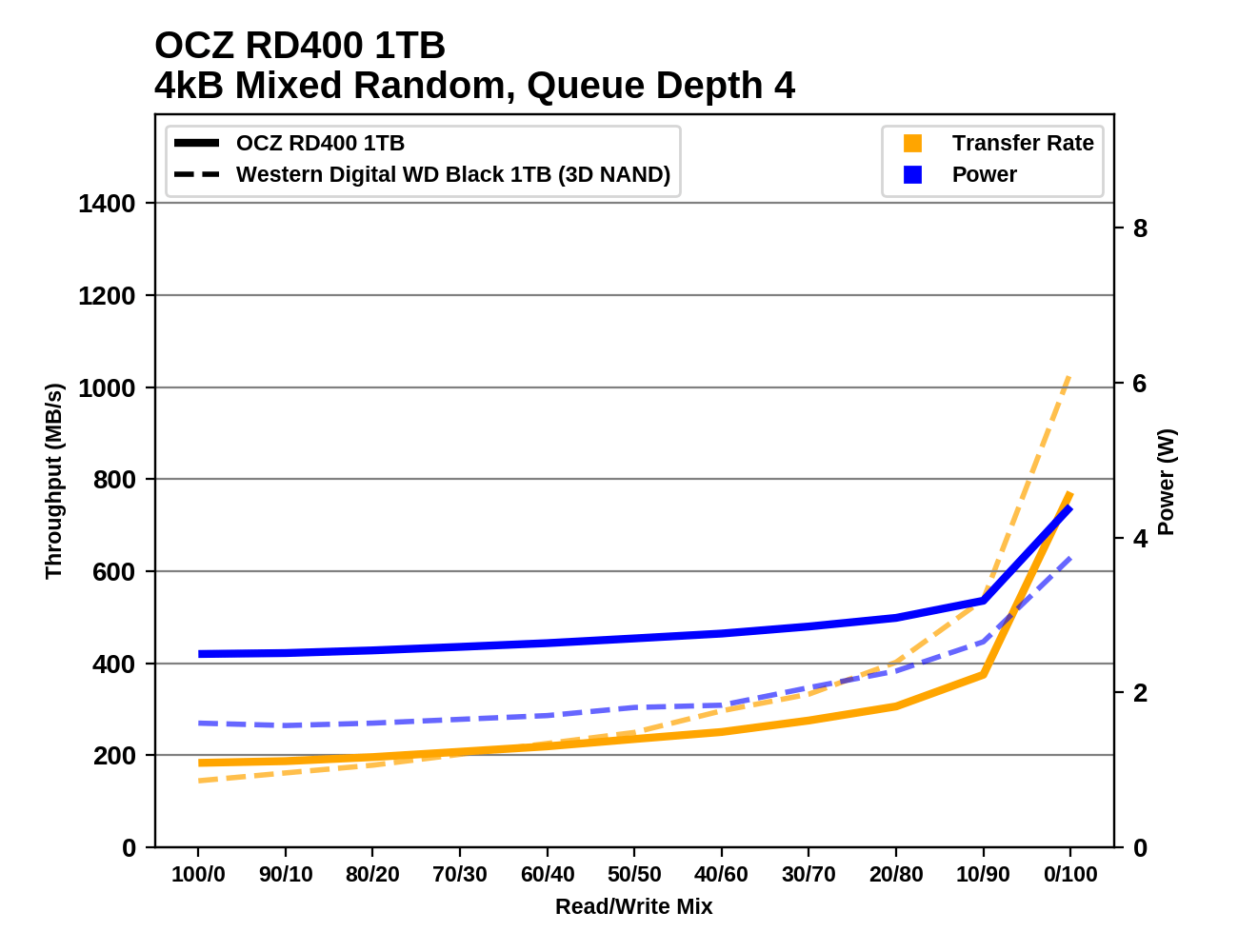
the OCZ RD 400 1TB
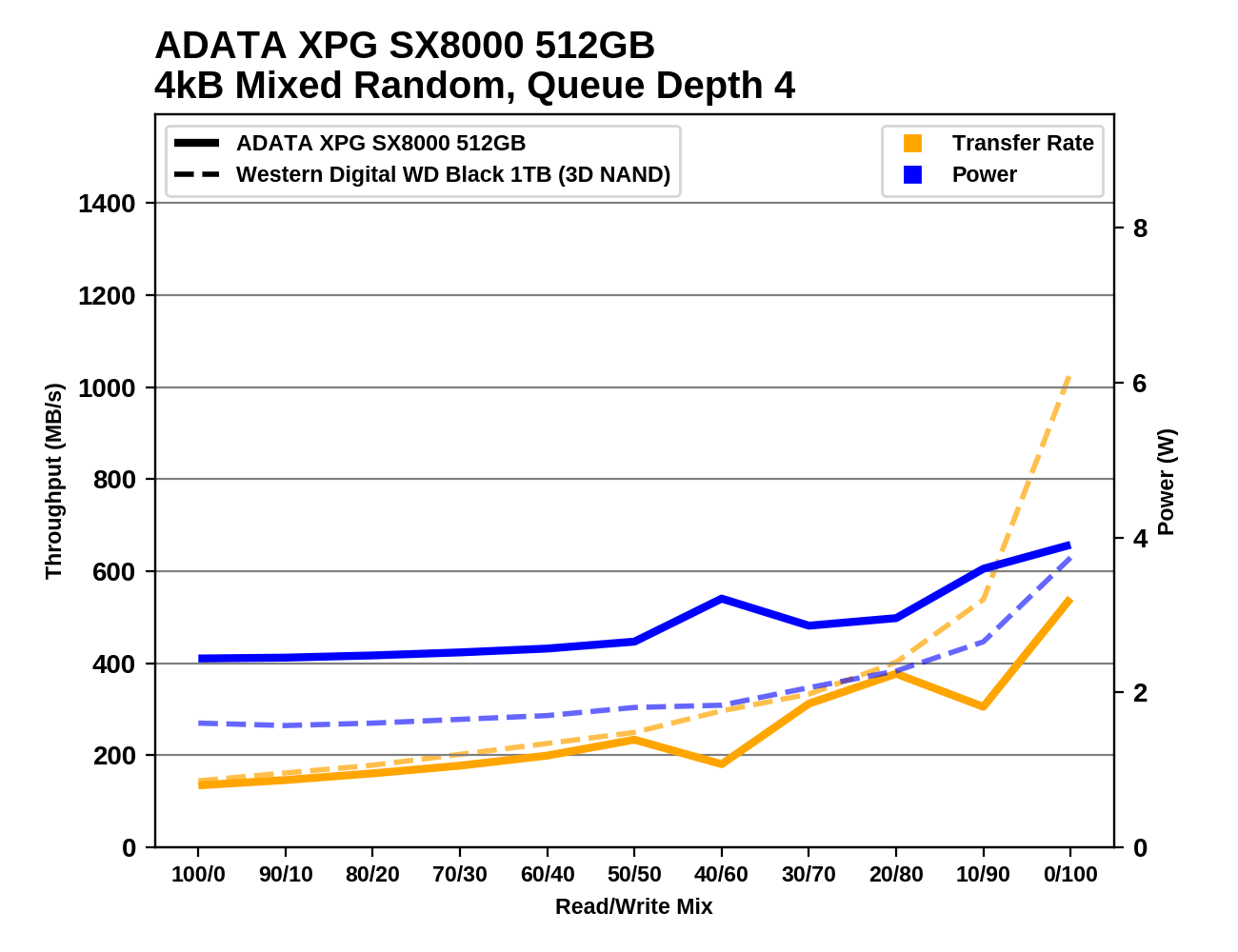
the ADATA XPG SX8000 512 GB
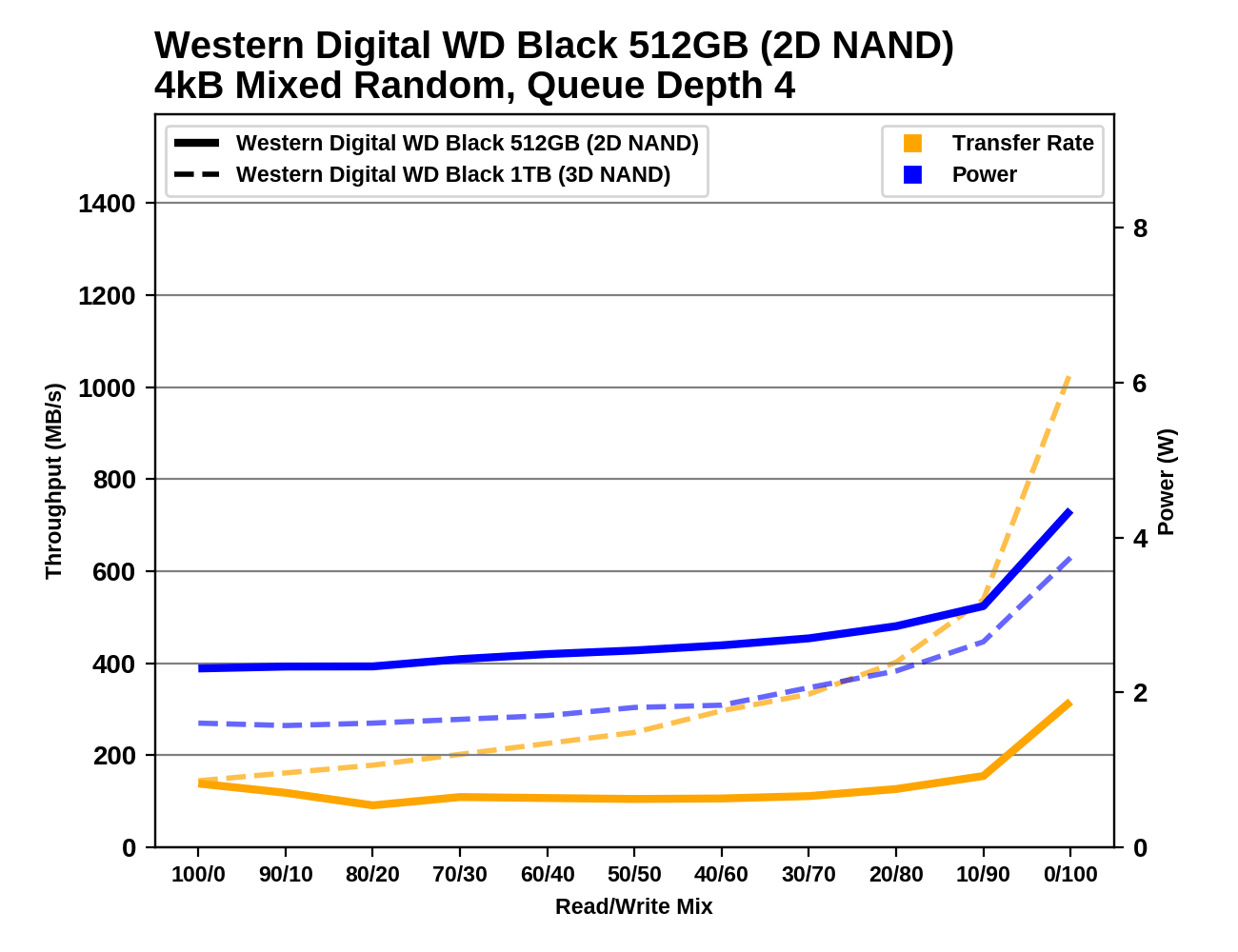
Western the Digital the WD Black 512GB (2D of NAND)
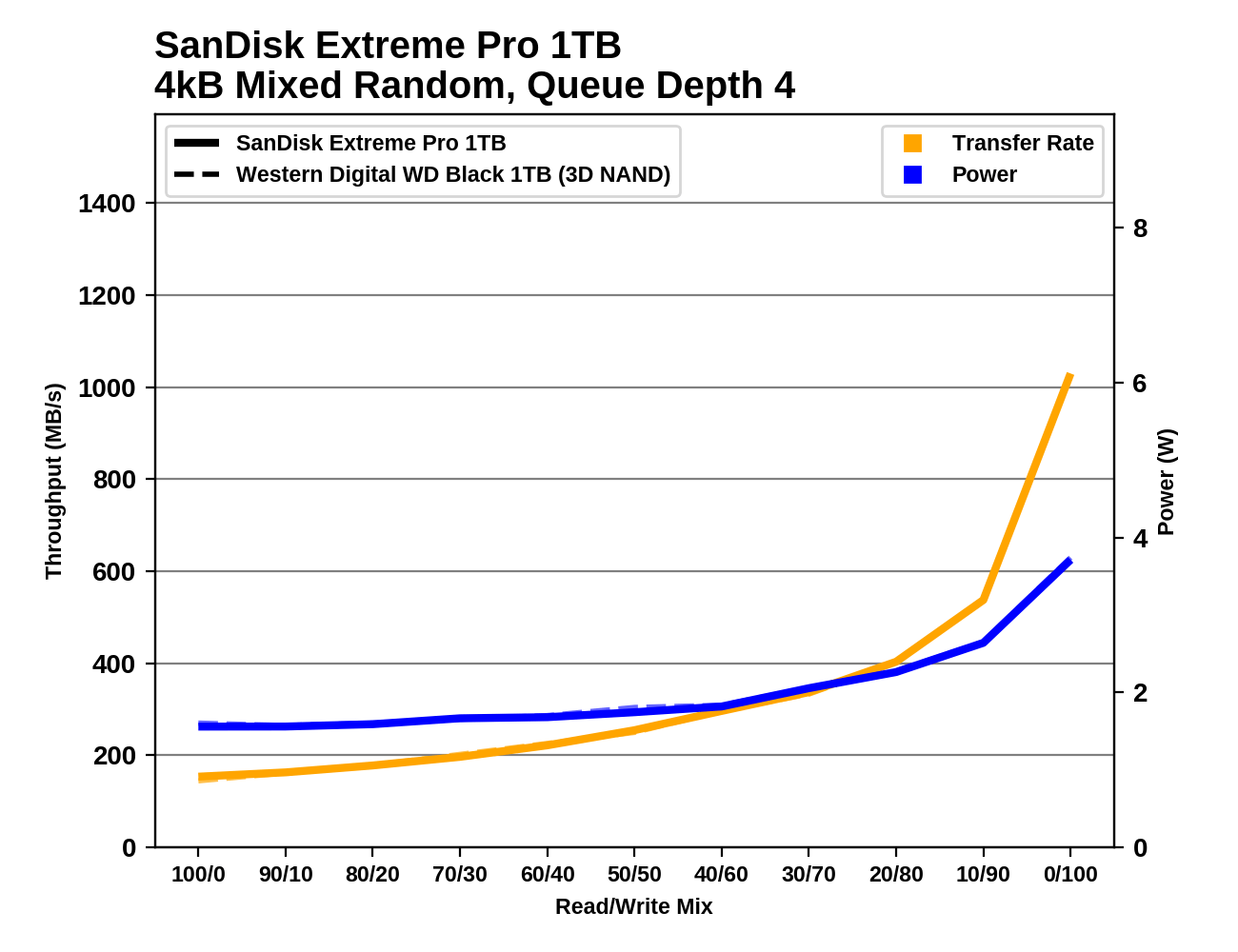
SanDisc Extreme the PRO 1TB
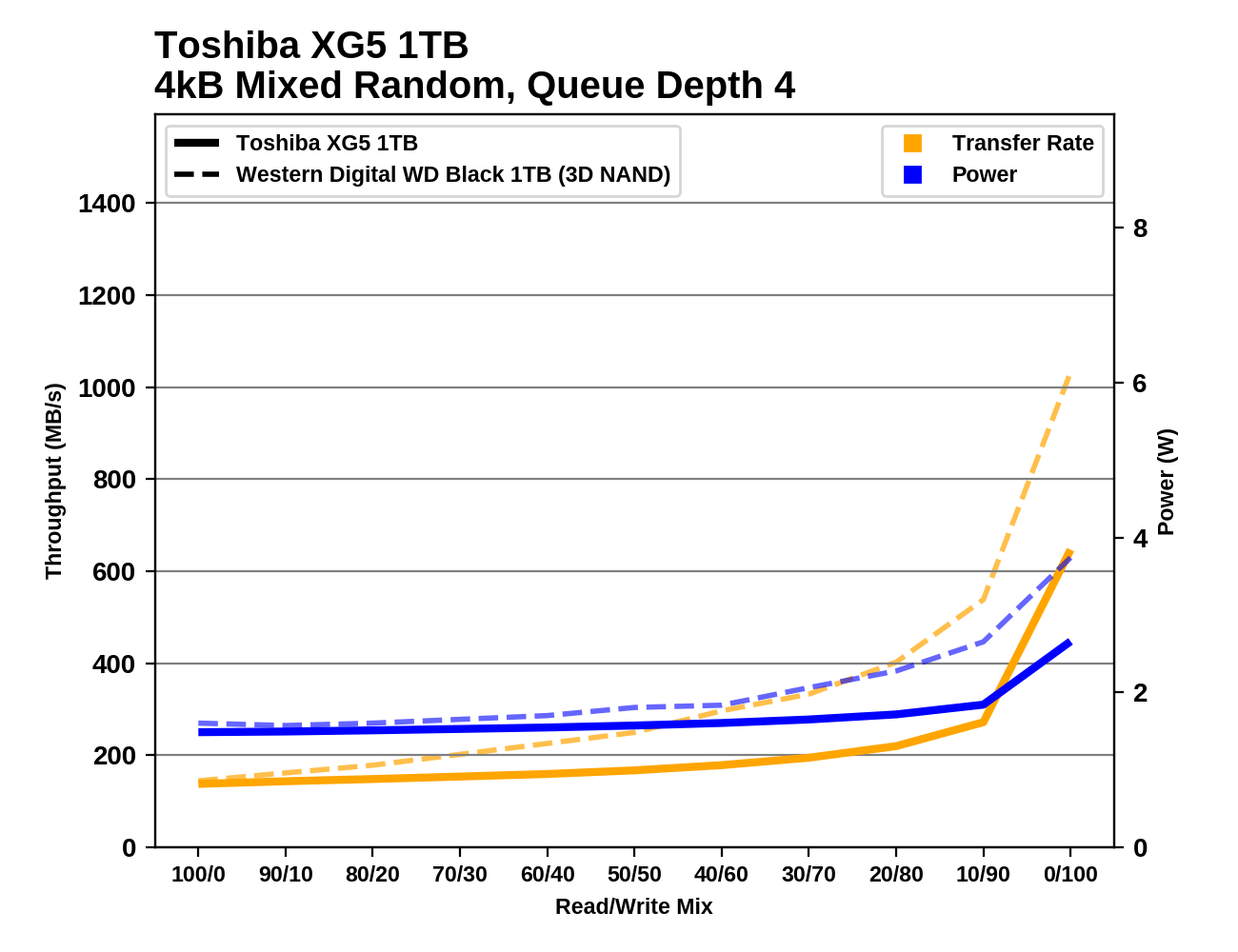
the Toshiba XG5 1TB
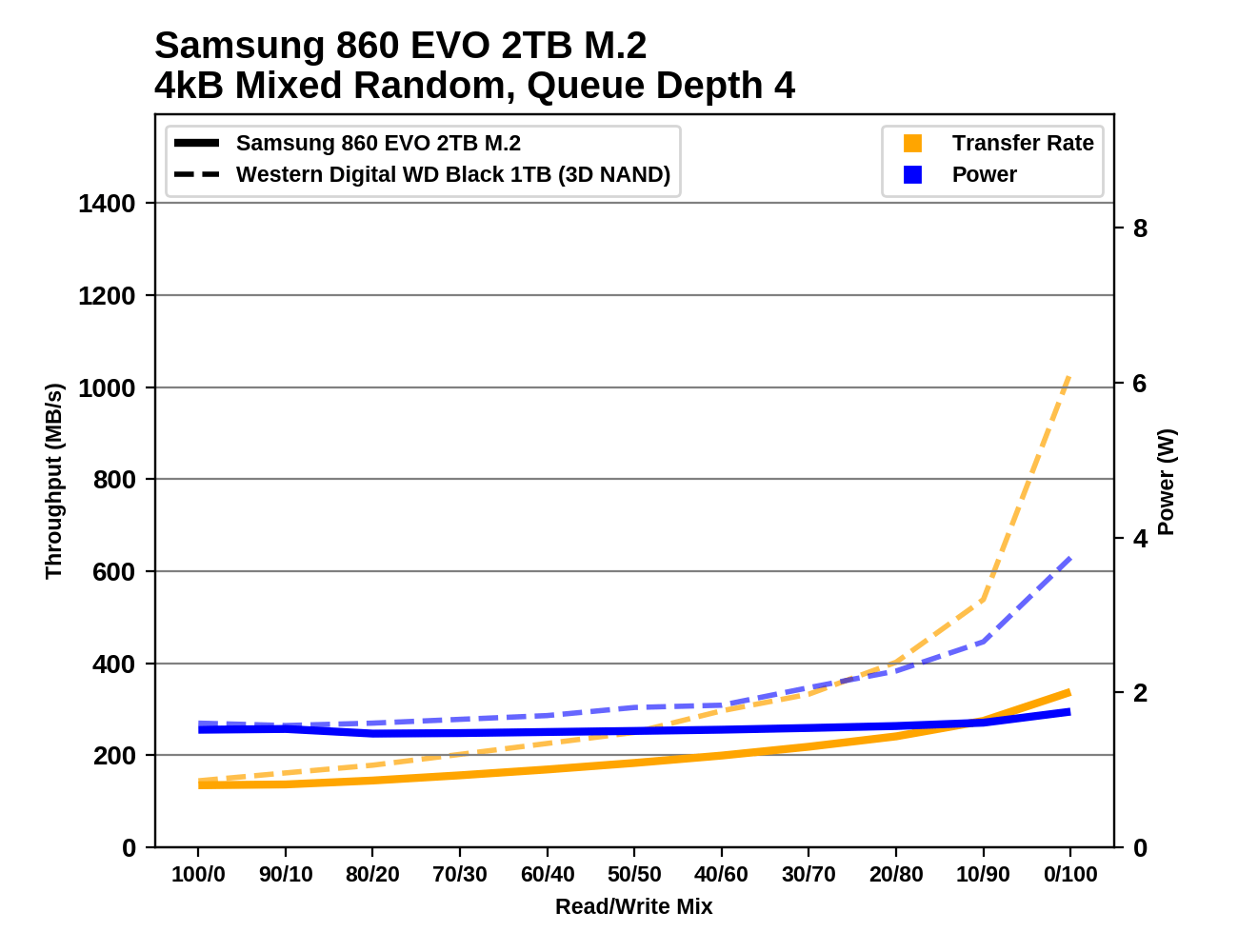
Samsung 860 EVO 2TB M.2

Crucial MX500 1TB
 SanDisc Ultra 3D 1TB
SanDisc Ultra 3D 1TB 
Intel Optane 900P 280GB
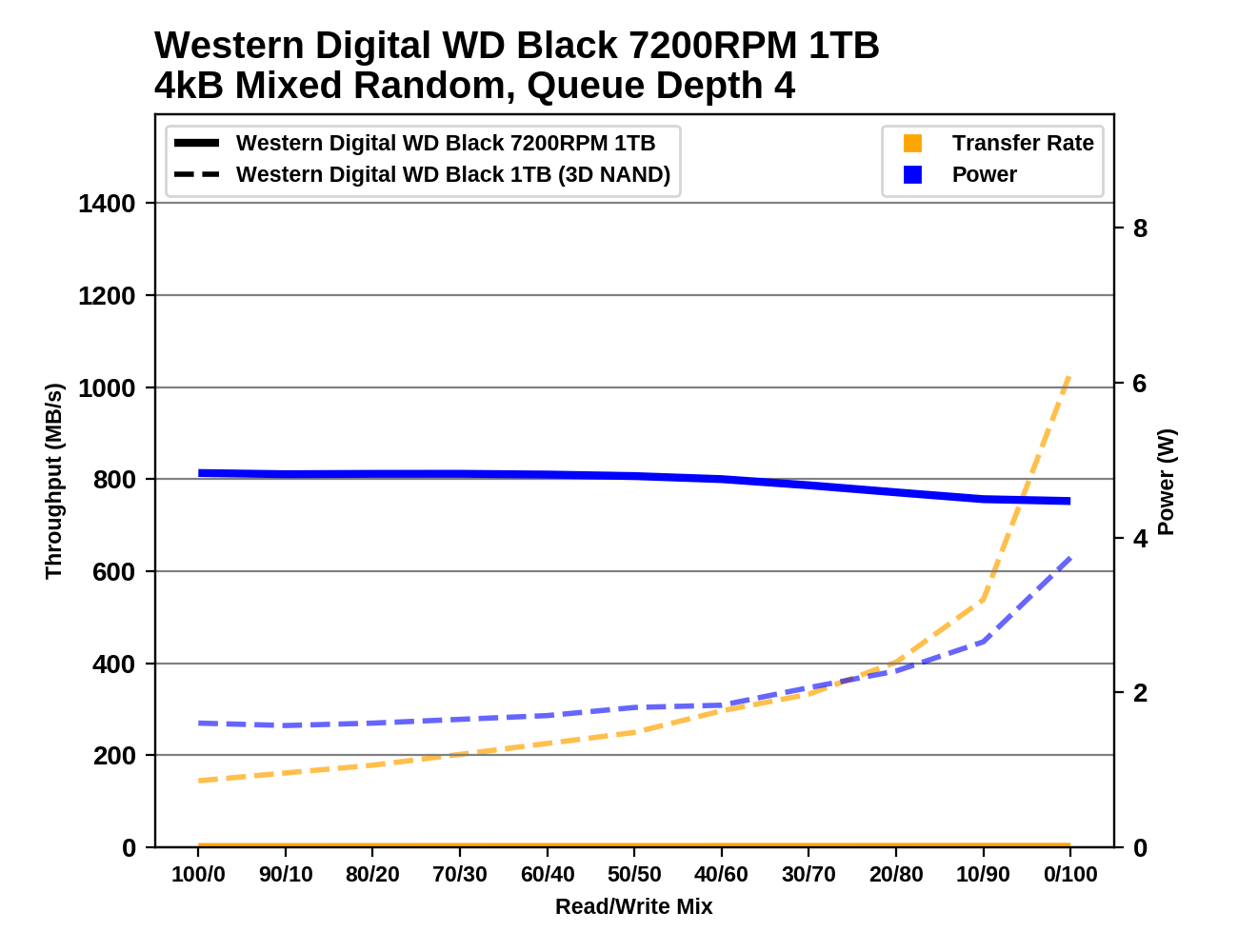
Western Digital WD Black 7200RPM 1TB
WD Black's performance grows very slowly with load shifting from reading to writing, but near the end of the test, a good implementation of SLC write caching makes WD Black a winner. The power consumption is less than 2 W for most of the test, and does not reach 4 W at the very end.
Смешанная последовательная производительность
Our mixed sequential read and write test, unlike the previous I / O test, performs successive calls of 128 KB in size (instead of 4 KB in random places), and also takes place at queue depth 1. The range of tested mixes has not changed, the timing and limits on data transfer is the same as described above.
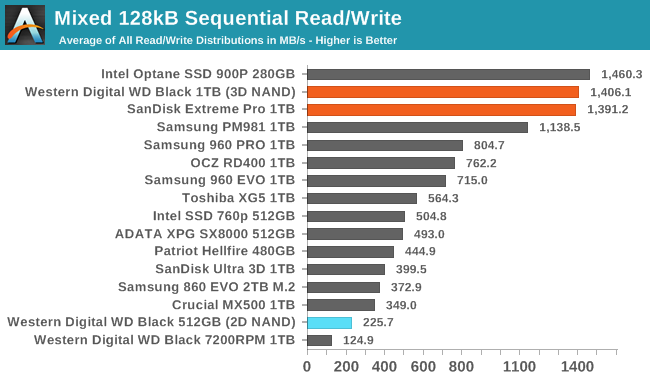
The performance of WD Black's mixed sequential workloads is surprisingly high, and is barely inferior to the Optane SSD, far ahead of other flash drives.
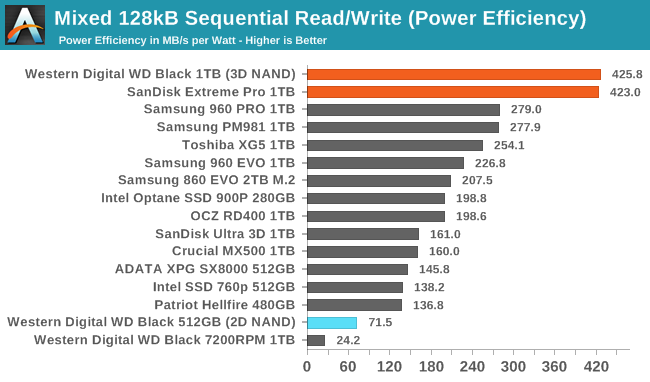
WD Black consumes about the same power as other SSDs during a mixed sequential test, which, combined with excellent performance, leads the drive to lead in energy efficiency.

Western Digital WD Black 1TB (3D NAND)
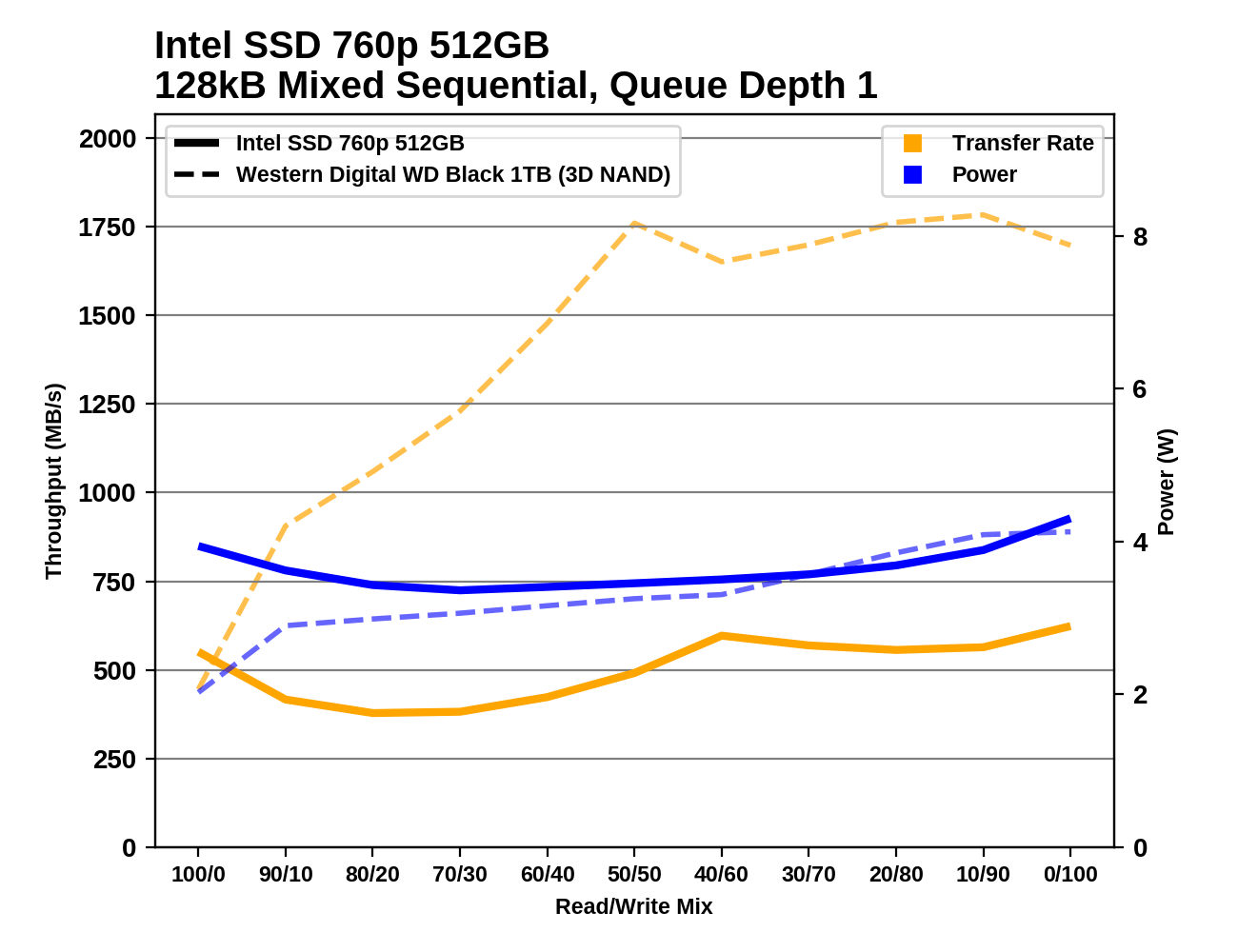
Intel SSD 760p 512GB
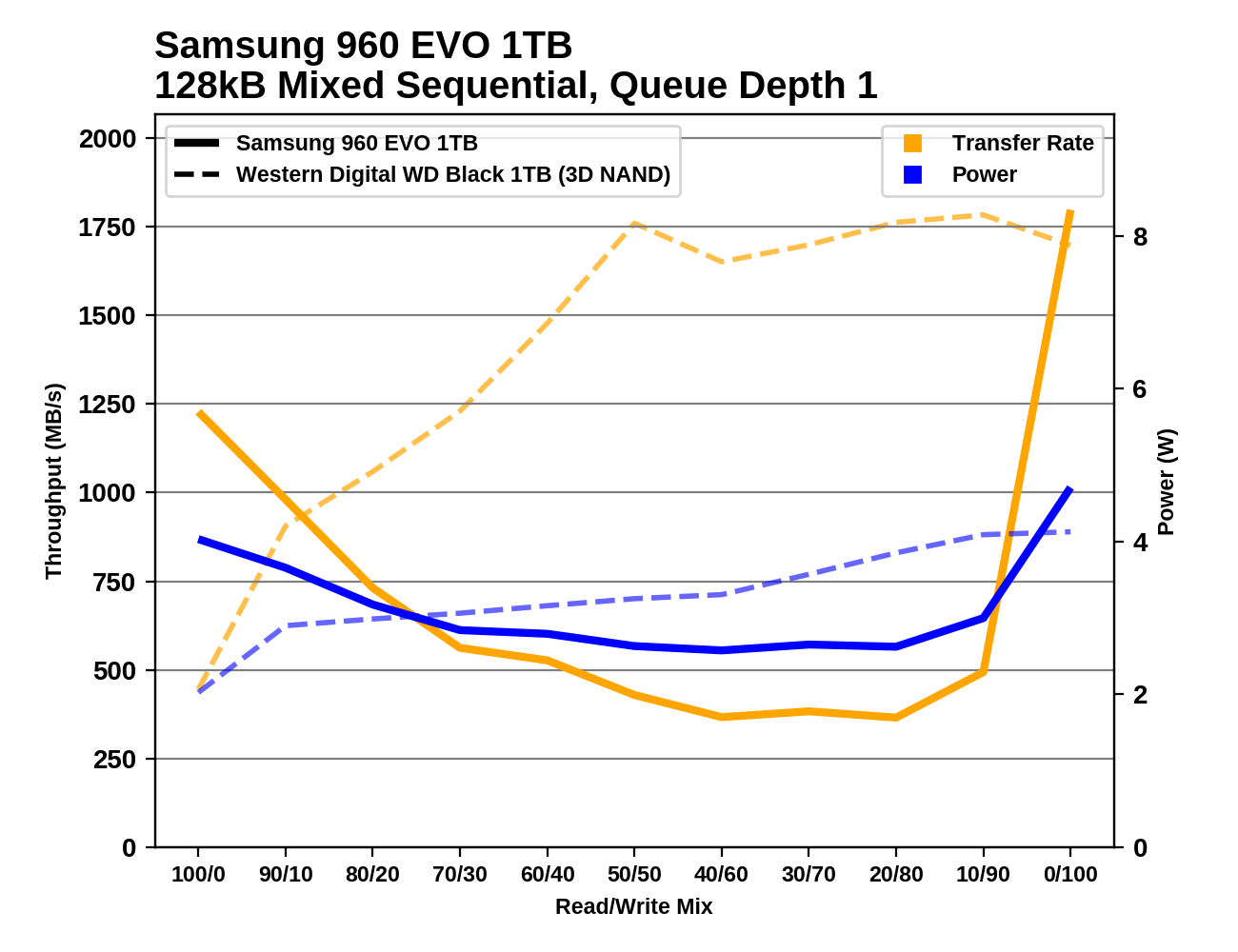
Samsung 960 EVO 1TB
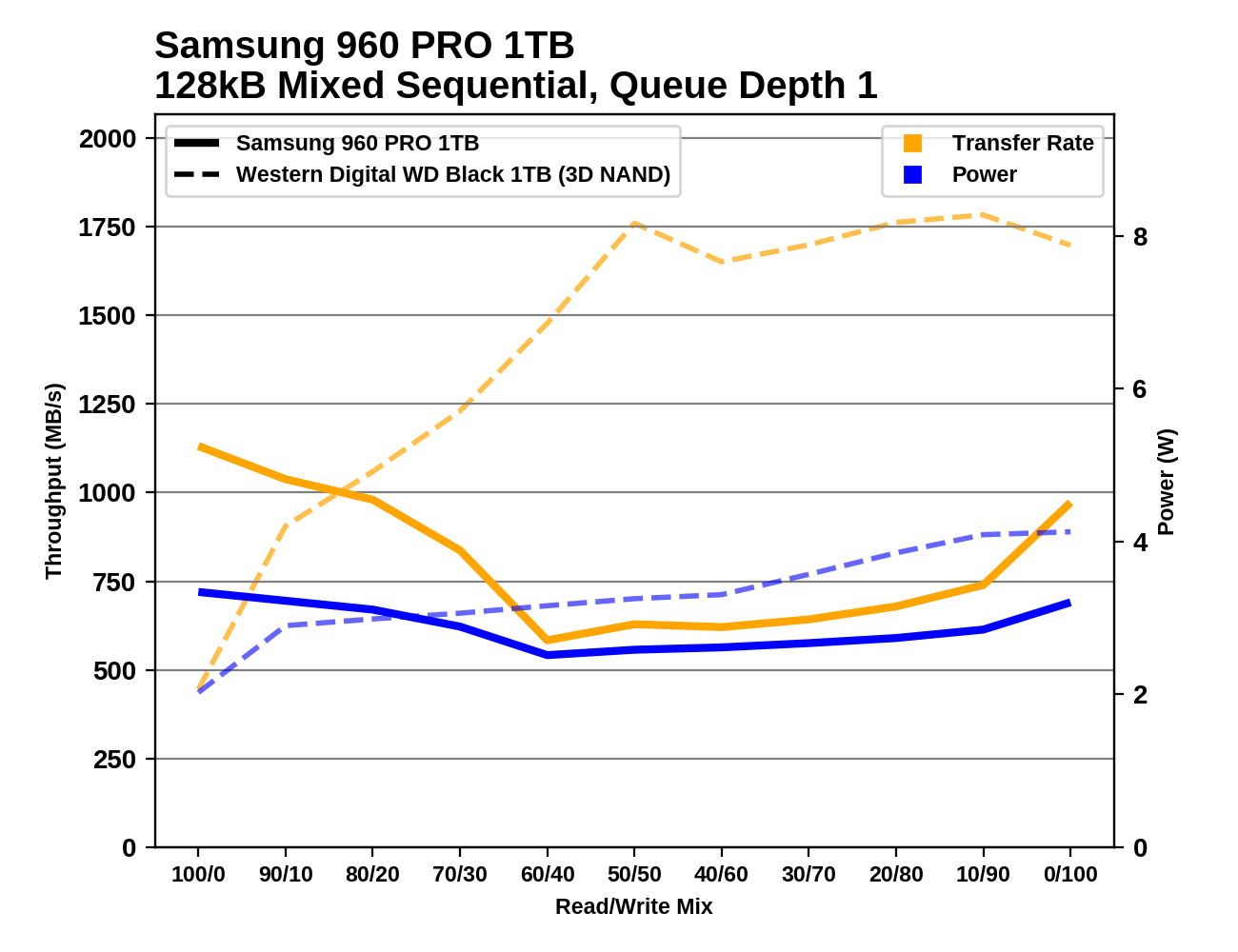
Samsung 960 PRO 1TB
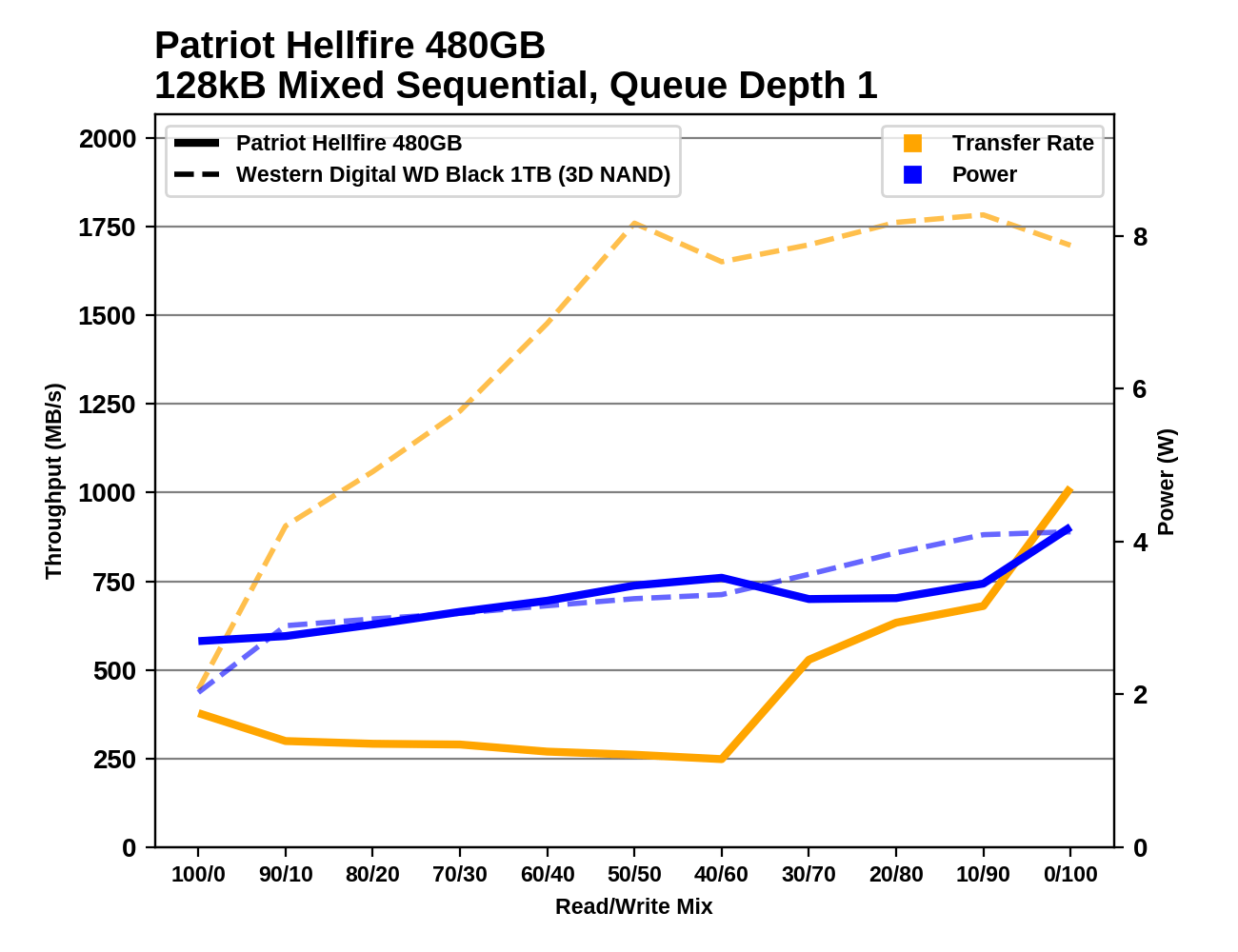
Patriot Hellfire 480GB
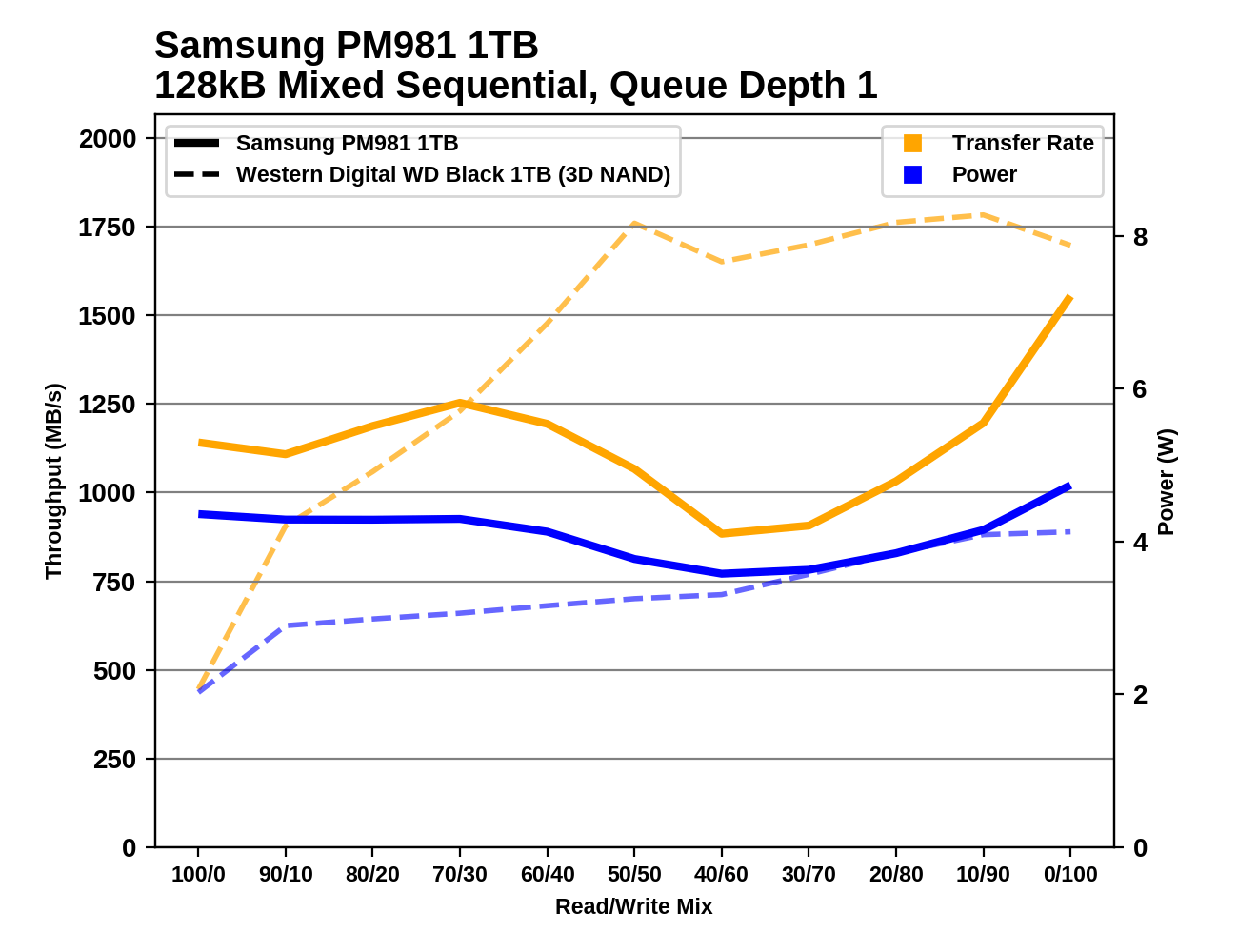
Samsung PM981 1TB
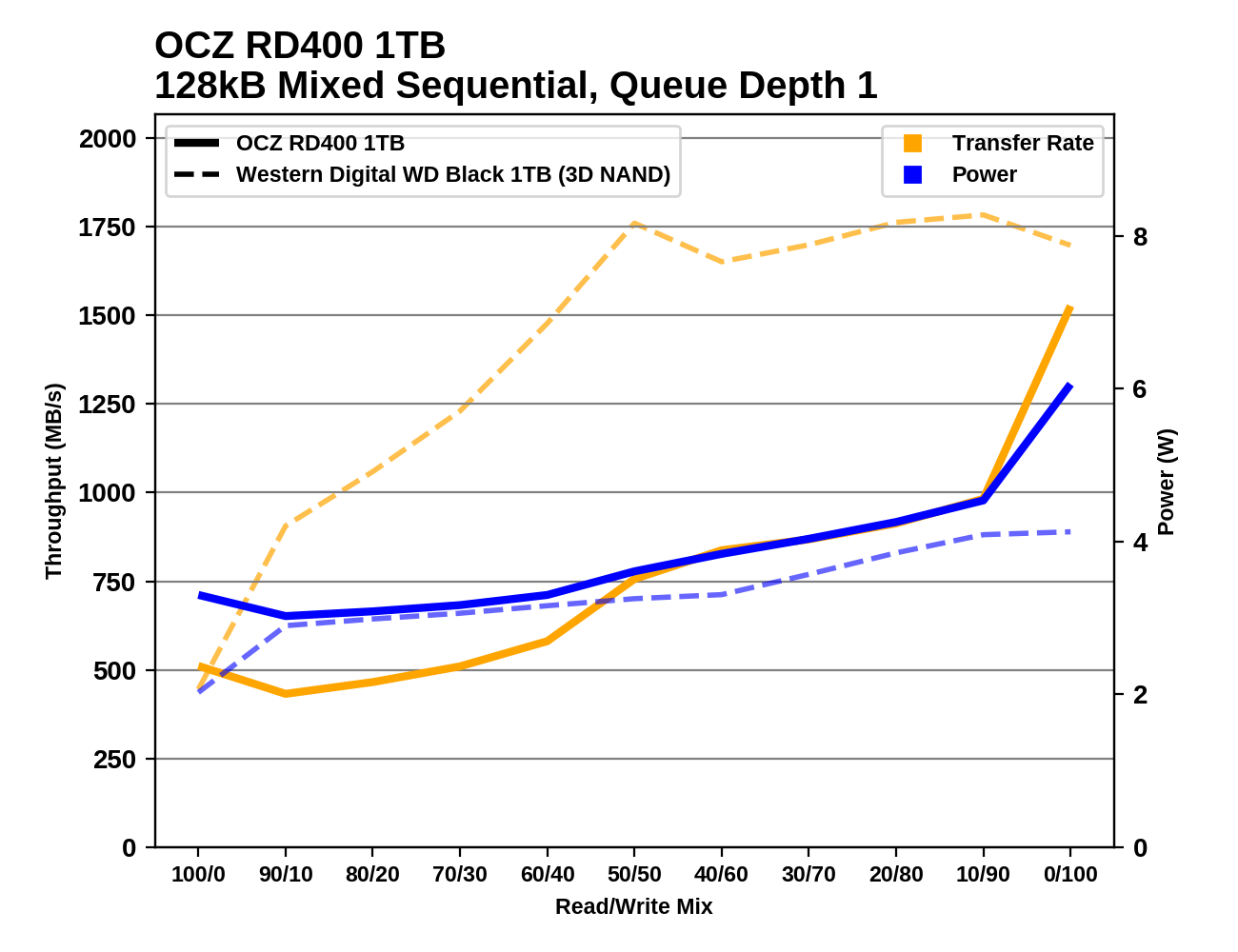
OCZ RD 400 1TB
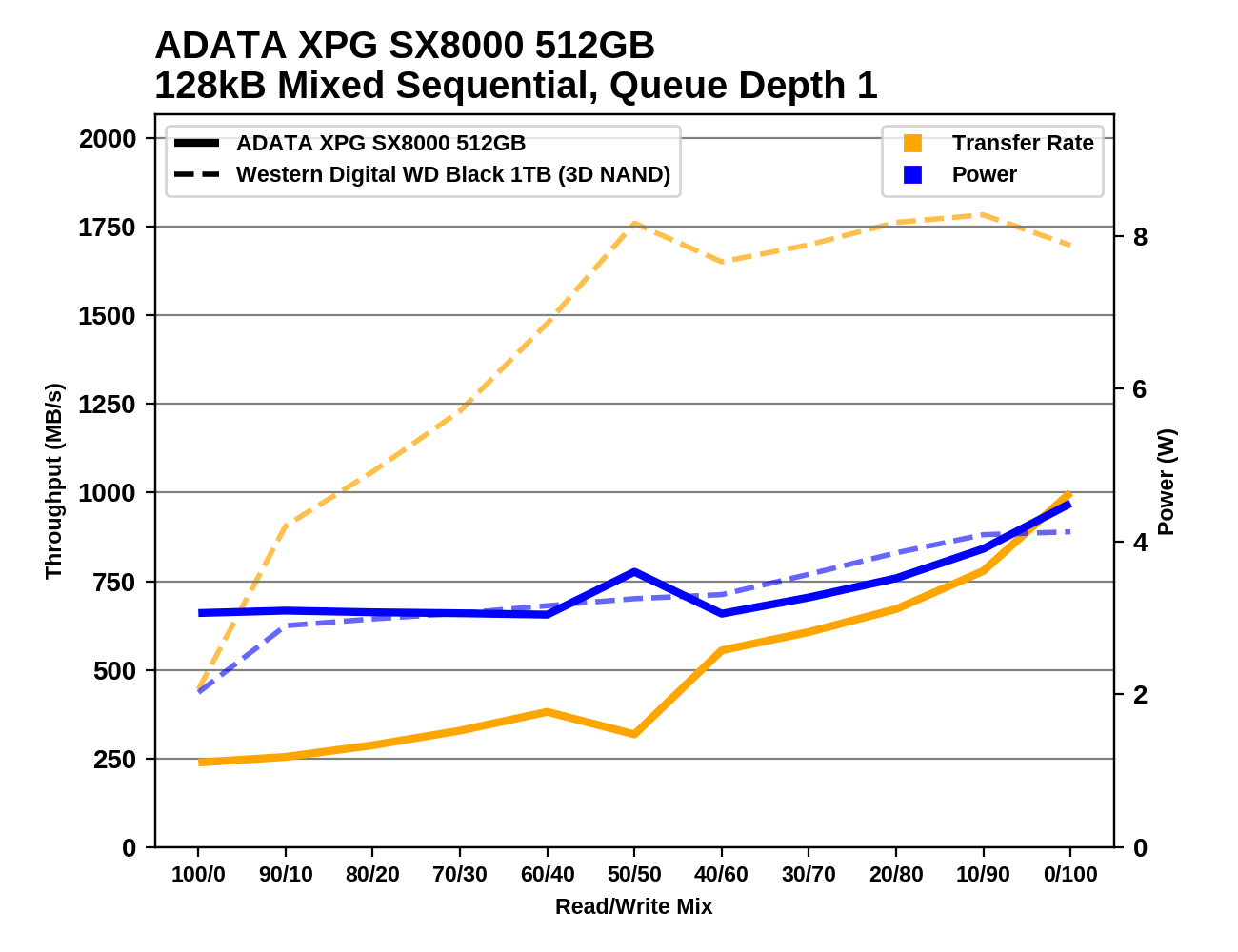
ADATA XPG SX8000 512 GB
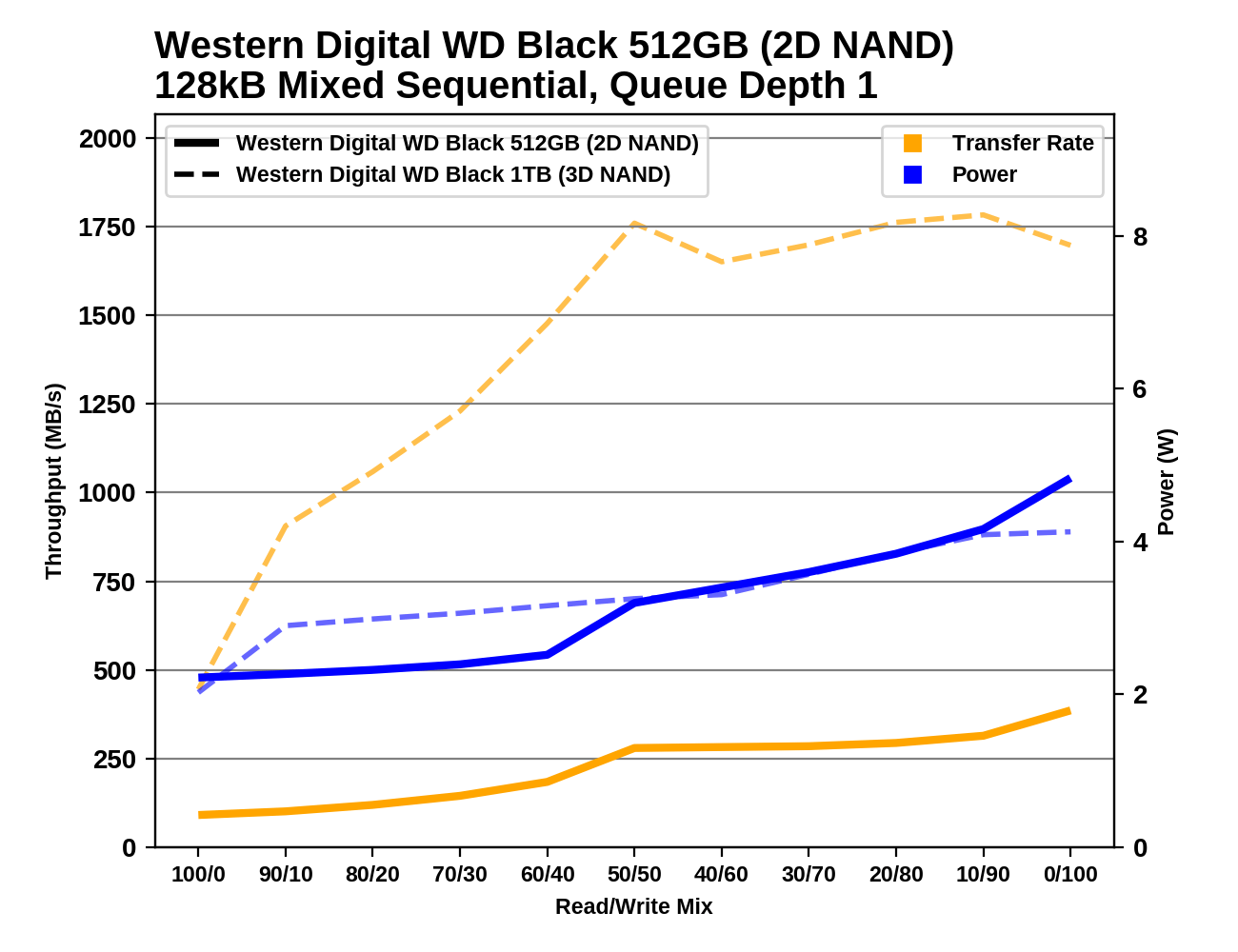
Western Digital WD Black 512GB (2D NAND)
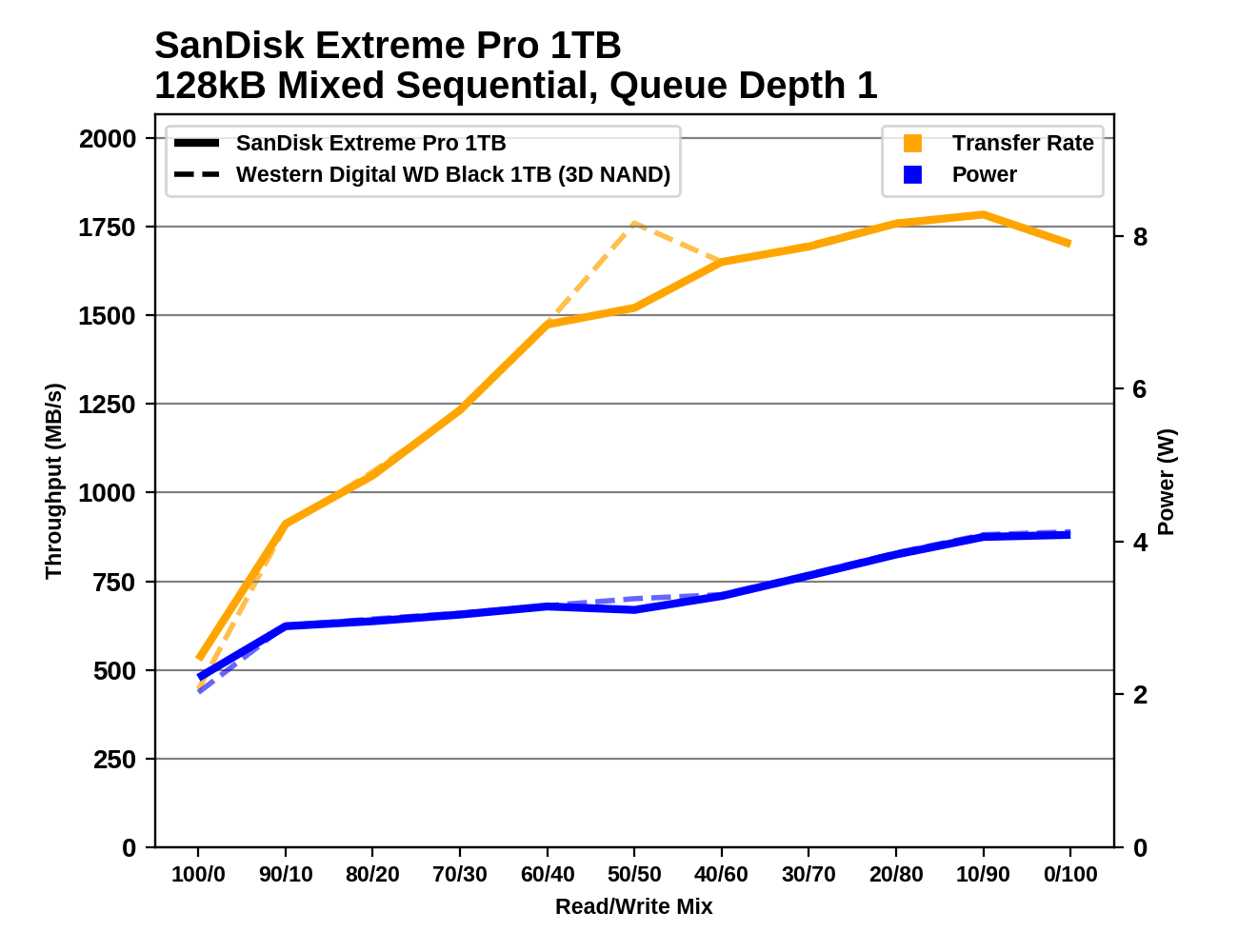
SanDisc Extreme PRO 1TB
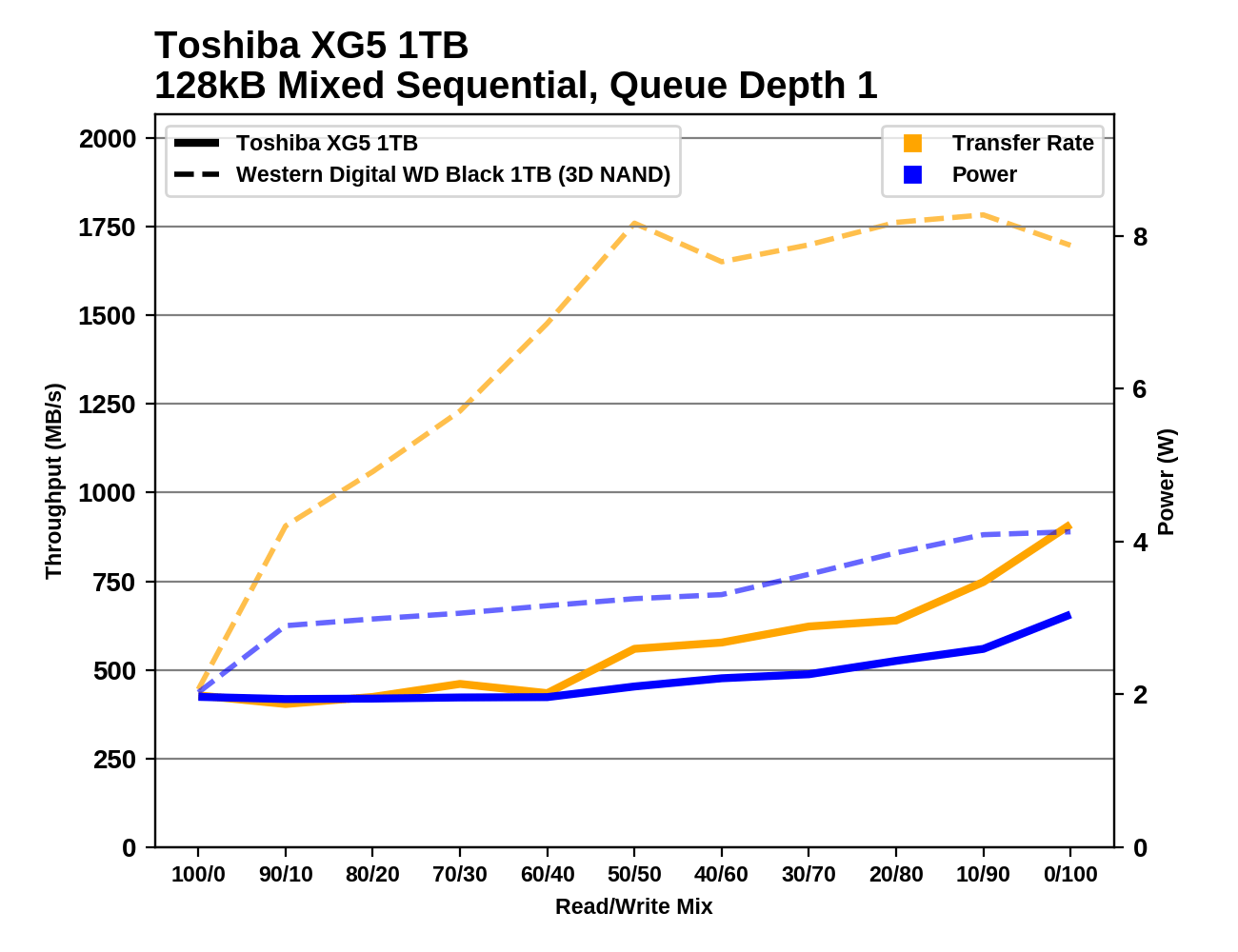
Toshiba XG5 1TB
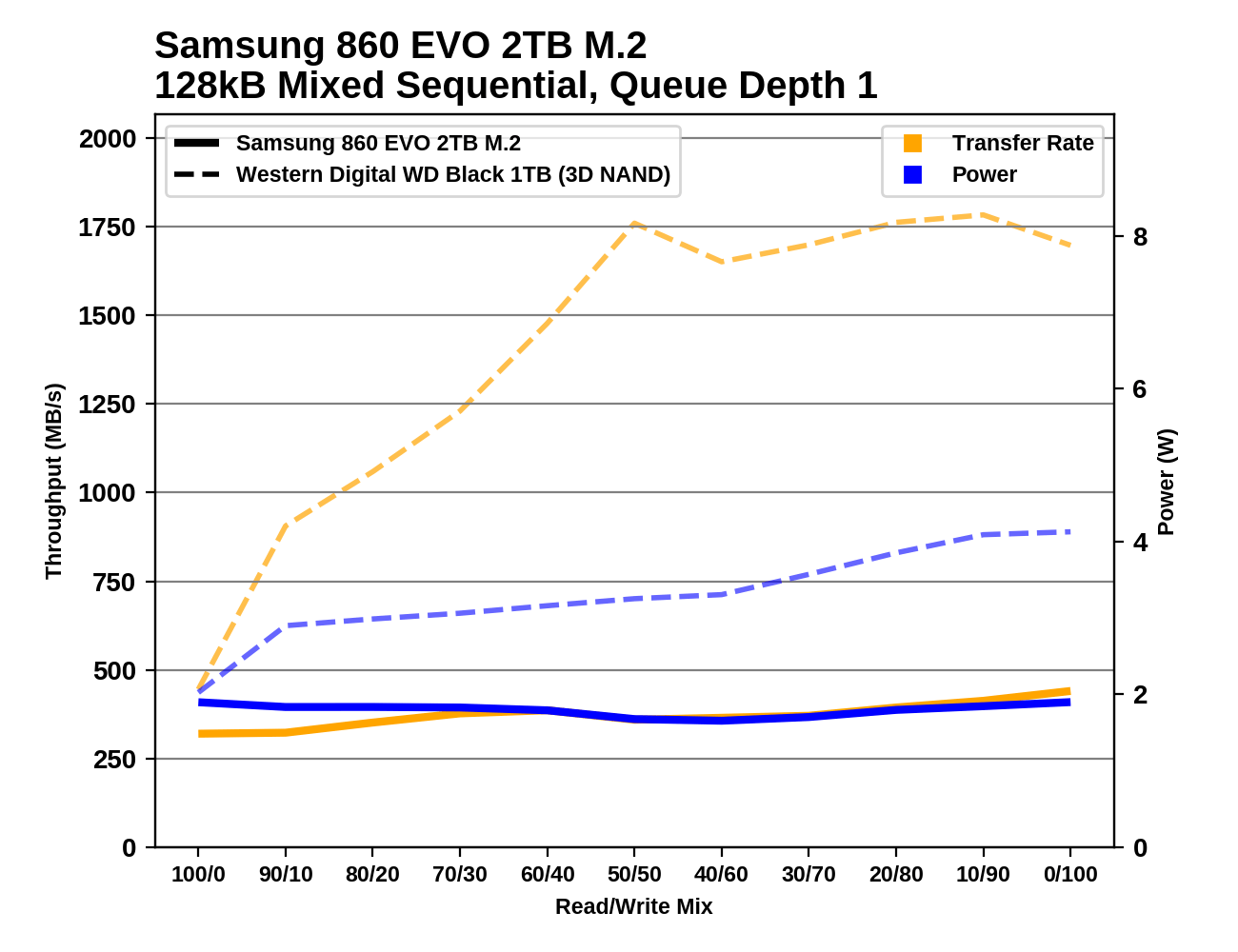
Samsung 860 EVO 2TB M.2

Crucial MX500 1TB
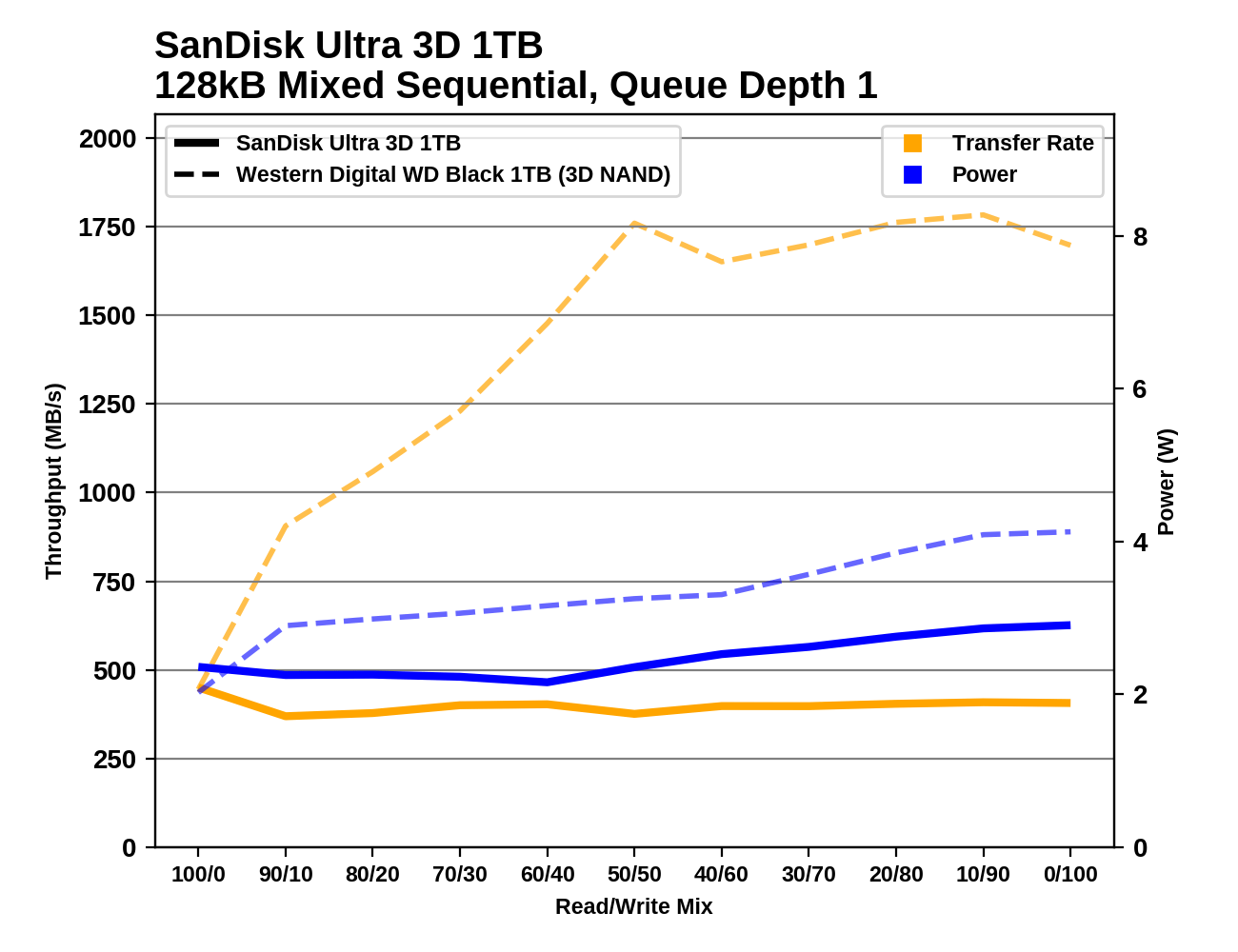
SanDisc Ultra 3D 1TB
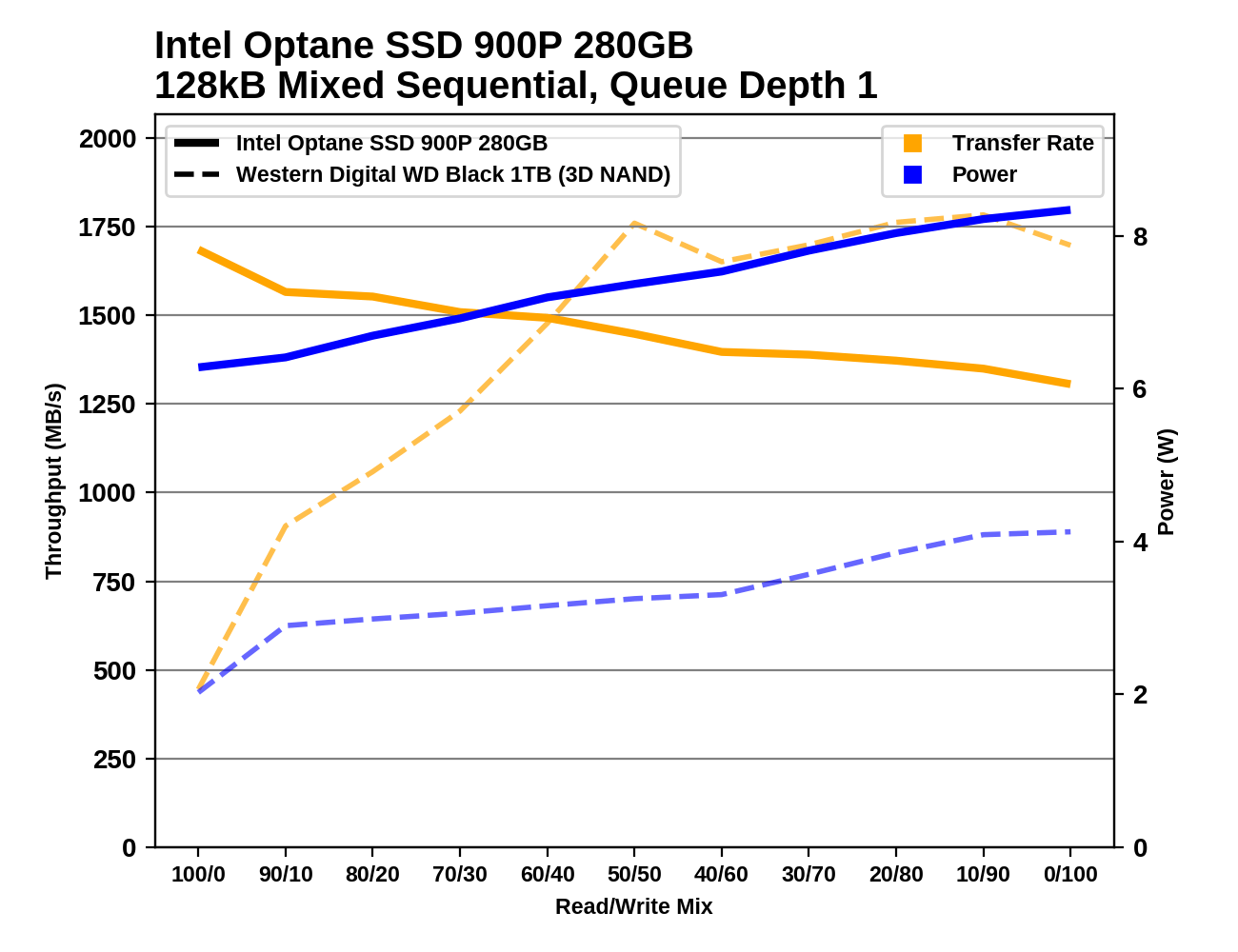
Intel Optane 900P 280GB
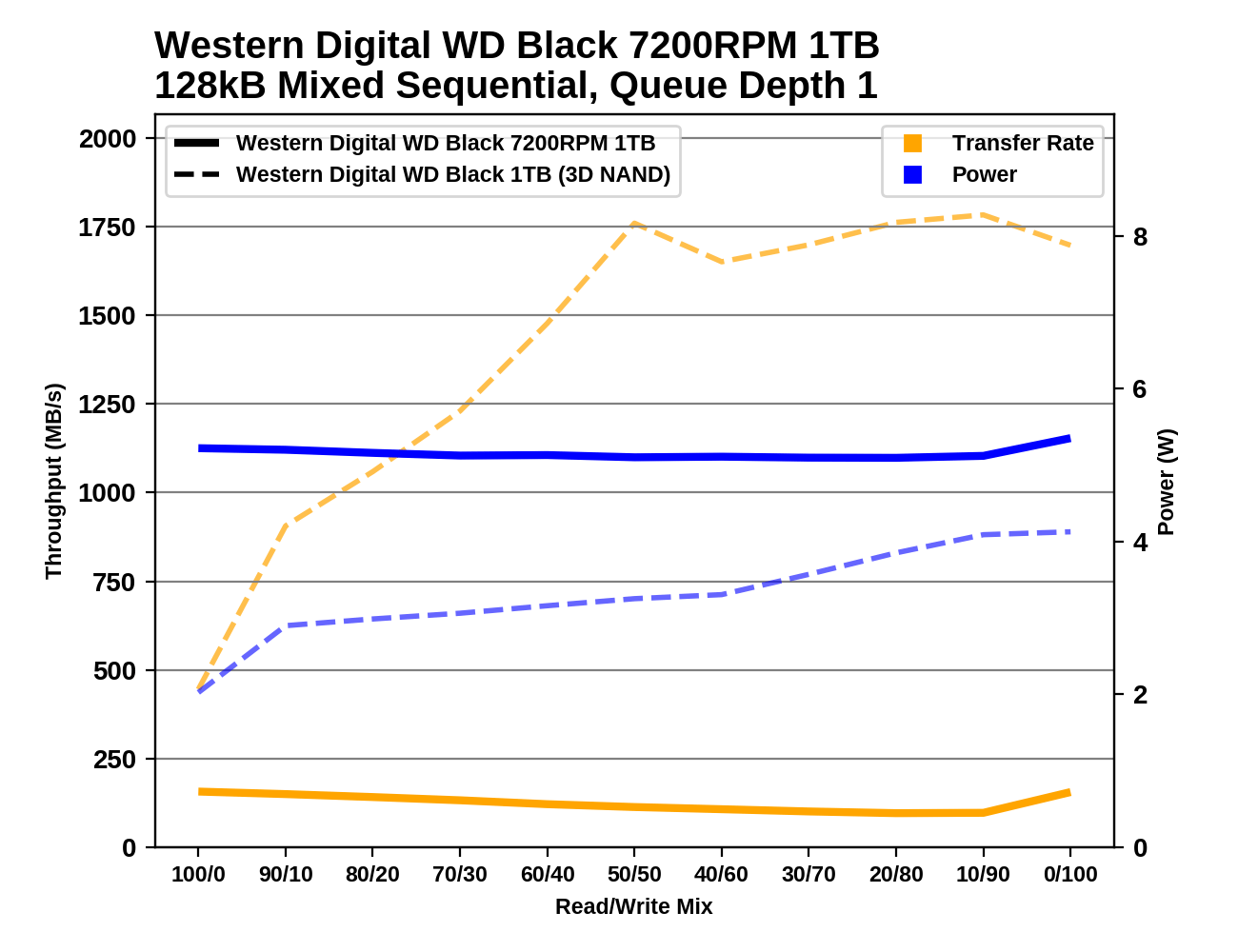
Western Digital WD Black 7200RPM 1TB
The graph of WD Black performance changes in a mixed sequential test looks very strange. Many discs show a concave curve with maximum performance at both ends of the test, when the workload is either pure writing or only reading, and the worst performance is in the middle of the test. In contrast, with WD Black, the performance graph starts from the bottom positions, but quickly grows during the first half of the test, and keeps its maximum value throughout the second half.
Power management
In the real world, home drive load mode leaves SSDs inactive most of the time. This means that the active power measurements presented earlier in this review show only part of how to determine the quality of the drive when using battery power. When lightly used, the energy efficiency of an SSD is determined by how much it can save electricity in standby mode.
SATA SSDs are tested when SATA power management is turned off to measure their active standby consumption, and further evaluate deep standby consumption and wake up delay. Our test bench, like any desktop system, cannot launch the deepest inactivity state of DevSleep (the lowest power consumption mode).
Idle consumption management for NVMe SSDs is much more complicated than for SATA SSDs. NVMe SSDs have different idle states, they differ from each other in power consumption and delays that occur when a component returns to its active state. The WD Black drive supports APST (Standalone Power State Change) technology.
We measure inactivity consumption in two ways. Active standby is a typical desktop PC that doesn’t use any of the advanced power saving features of PCIe or NVMe, and the drive is immediately ready for processing new commands. Standby power consumption is measured with Power Status L1.2 PCIe powered on and NVMe APST enabled.
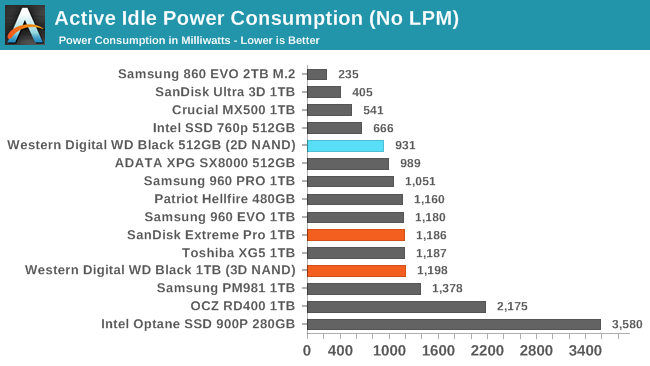
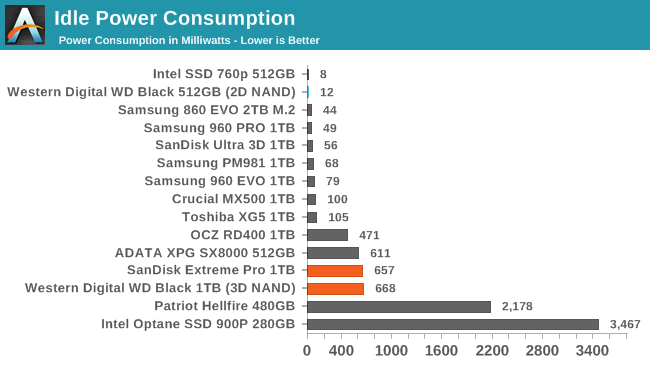
Like most SSD NVMe drives, WD Black has a fairly high consumption in standby mode - this is the price of supporting an active PCIe 3x4 bus. Active standby consumption is slightly higher than the previous WD Black SSD, but corresponds to drives from Samsung, Toshiba and Phison.
Enabling all advanced power management features of PCIe and NVMe does not have the desired effect on the WD Black disc under investigation. Consumption is reduced by only half (even less), and a "decline" was expected by at least an order of magnitude. The previous WD Black SSD model used aggressive power management regardless of whether the operating system requested it. The new WD Black, it seems, was unable to save a lot of energy on our desktop stand, regardless of the requested system power. We will work with Western Digital to try to determine the cause of this abnormal behavior. WD Black is not the only NVMe drive whose power management problems arise from the box, Intel and Samsung have been able to create disks that provide very low consumption in standby mode,
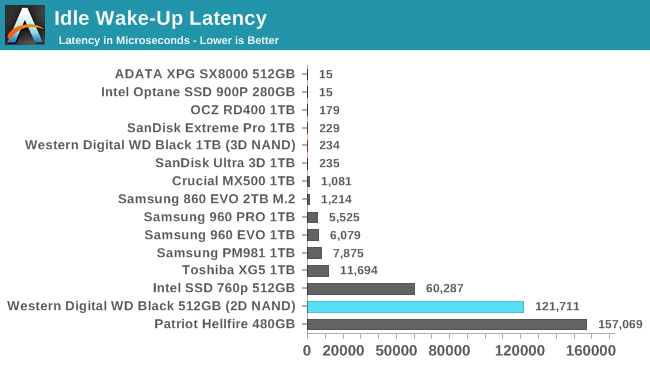
Since WD Black is clearly not in a position to use all the power management capabilities at our booth, it is not surprising that its delay in waking up is rather small. This is not the minimum ~ 15 µs, which we observe in disks that do not try to save electricity in principle, but ~ 230 µs is still a very fast wake-up time.
Conclusion
From last year's tests, we learned about SATA drives from Western Digital and Toshiba XG5, where the 64-layer 3D-TLC showed a huge jump in comparison with the planar NAND, and was probably the fastest and most energy-efficient TLC NAND. Now it is obvious that these discs did not even try to use the full capabilities of the new flash. With the new controller on board, Western Digital BiCS 3 TLC sparkles like a diamond. The new WD Black and SanDisk Extreme PRO are undoubtedly high-quality NVMe SSDs that match the level of Samsung 960 EVO, and sometimes even surpass the 960 PRO.
In addition to a few disappointing moments in the test results of WD Black, the fact that even when the drive is not in the first or second places, it is a bit more than the low-level NVMe drives, can not but rejoice. The two biggest problems are a bad start in the sequential read test, and a series of NVMe power management errors that you may be able to solve with time. Many NVMe drives start to “behave wonderfully” when it comes to idle power management, you see, a sharp contrast with the almost universal and flawless support among SATA drives, at least for the sleep state, as well as DevSleep (which cannot be used on desktop computers).
The power efficiency of WD Black under load is excellent, we can safely say that the Western Digital NVMe controller is not a power eater. According to the test results, WD Black unexpectedly surpassed all our expectations, especially during a mixed sequential I / O test: none of the tested drives could compare with it.
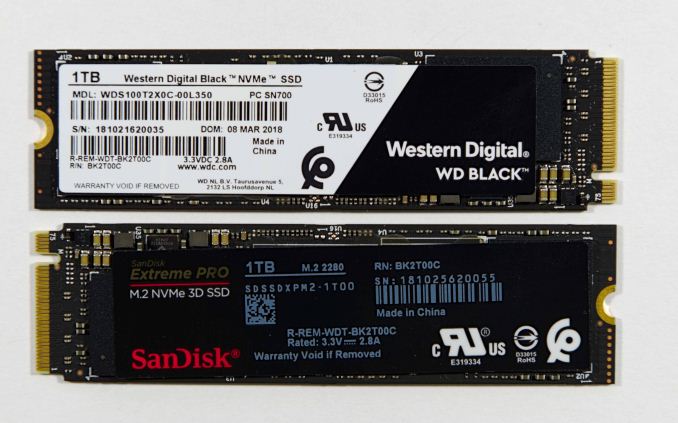
Samsung occupied the leading position in the early stage of the race among the NVMe SSD, and still continues to hold first place. During this time, many brands tried to implement NVMe high-performance SSDs with a planar NAND, or even with unsuccessful first-generation Intel / Micron 3D NAND. The unsuccessful attempts include the original WD Black NVMe SSD last year, which used 15-nm planar TLC and could hardly surpass a decent SATA drive.
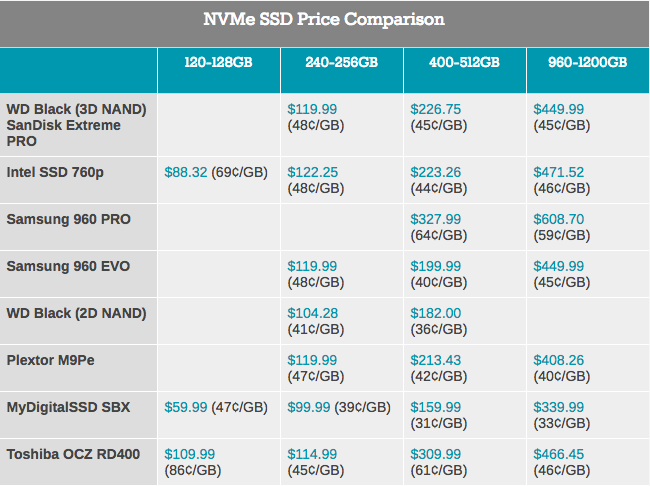
MSRP (Recommended Retail Price) WD Black roughly matches current retail prices for the Samsung 960 EVO, which is a direct competitor to the device under test. None of these drives has a clear performance advantage with a capacity of 1TB, WD Black has a modest advantage in terms of energy efficiency (despite the problems found in a state of inactivity). Intel 760p was in this price range, but it is clearly uncompetitive.
Plextor M9Pe became available to buyers after the official launch at the beginning of this year. It has a Toshiba 64L TLC and a Marvell controller, it accurately reflects what the new WD Black could be without implementing its own internal Western Digital controller. Soon we will have preliminary results for M9Pe.
The long years of Western Digital's 3D-NAND development work and their new NVMe controller paid off. They again deserve to be in the big leagues, and their last SATA SSDs also show themselves from a good side. This year, the SSD market has serious competition in almost every price category.
Thank you for staying with us. Do you like our articles? Want to see more interesting materials? Support us by placing an order or recommending to friends, 30% discount for Habr users on a unique analogue of the entry-level servers that we invented for you: The whole truth about VPS (KVM) E5-2650 v4 (6 Cores) 10GB DDR4 240GB SSD 1Gbps from $ 20 or how to share the server? (Options are available with RAID1 and RAID10, up to 24 cores and up to 40GB DDR4).
Dell R730xd 2 times cheaper?Only we have 2 x Intel Dodeca-Core Xeon E5-2650v4 128GB DDR4 6x480GB SSD 1Gbps 100 TV from $ 249 in the Netherlands and the USA! Read about How to build an infrastructure building. class c using servers Dell R730xd E5-2650 v4 worth 9000 euros for a penny?
